Remembrance Day 2021: Mona Vale's hales-smith haynes smith, holding, brentnall and roby - A.I.F. men of world war one

When researching Mona Vale people who served in World War One the National Archives of Australia's War Record documents showed those who had been killed on the fields of France had had what effects of these sons had left behind in that foreign place were often delivered around Christmas or other anniversaries to their relatives.
At first the timing struck as something that would renew a wound not yet healed – but then one wife found that something that should have been in the package was missing, that it had been tampered with, broken open, and she wrote letters and made complaints to the postal service as well as those in charge of such matters within the Services. She persisted and persisted. Her persistence pointed out that another wound had been caused here – to a widow.
It became obvious these small trinkets, all that was left, were very important to the mothers and wives they came back to. This is what they could hold, smell, caress.
Among the items listed many of these packages list ‘photos’. Although some of these may have been the places these Australians visited while in France, most of them would have been of loved ones back home – just as those loved ones would have held a photo here of that serving son or daughter.
The National Archives of Australia has done excellent work digitising and making available these individual War Records, as has the Australian War Memorial in its cache of photographs and biographies. These, along with those digitised by the State Library of New South Wales and the National Library of Australia, are a stark reminder, when you gaze into these faces of teenagers, and men in their late 30’s and early 40’s, of what may have lived within these soldiers, and what was lost with their deaths.
However, the records also show that a vast lot of these materials, particularly those photographs, have been lost or not yet made available. The absence of the faces of some of the men and one woman that run this year underline this fact.
Earlier this year the Australian public of today responded overwhelmingly against the $500 million dollar expansion of the Australian War Memorial, most deeming this a ‘colossal waste’, while 50 per cent of us wanted such funds, if spent, to be allocated to veterans health, veterans support and education about our veterans.
The redevelopment will see the award-winning Anzac Hall destroyed and 116 trees removed from the site in order to make way for a new exhibition hall, at an estimated cost of $498.7 million.
Surely Australians would prefer such funds to be invested in expanding these records, autobiographies and biographies and making these permanently available; this would be of real value to all of us, something that is already treasured far greater than another structure. It would even alleviate the sense that we have lost them yet again by choosing to build this structure rather than honour their memories and stories through making them available, and keeping these close to our hearts.
Why has that work stopped? Why cut funds from the budgets of the National Archives and National Library where such vital work is undertaken?
Imagine what could be done with just 10% of that allocated to this unpopular project if it was given towards gathering and making available their stories and songs.
This is of particular importance to Pittwater as the family which opens this year’s Tribute are commemorated in 'Halesmith' street, Mona Vale, a name suggested by the then Warringah Shire Council in January 1919 to the developers soon after the loss of yet another local life – two sons who gave their lives in this conflict, the ‘Great War’, and one daughter, who survived, and had served as a nurse.
Where are their faces? What did they look like? How did they speak, laugh, play? Why aren’t their names on the Mona Vale Village Park cenotaph and memorial?
One was the youngest son, and shot three times and sent back into battle again and again and again before the fourth time he was shot killed him. One was the eldest son, probably the de facto patriarch as their mother had had to bring them up when their father abandoned them almost 20 years prior to World War One.
Her story was not uncommon among the women who waited at Mona Vale – mother after mother raised sons alone, struggled, was forced into bankruptcy – and then, when their sons grew or were just grown into manhood, they went to war and were killed, leaving behind brides of four days or a few weeks, and children just born too – to continue the pain for the next generation.
What is also worth remembering about the state these mothers and wives were left in is that the correspondence from the Australian Army of then would not allow these widowed mothers or wives have their service medals or any estate bequeathed to them, or any entitlements and pension due automatically - they always asked 'where is his father' as the rules then were that everything was to go to the eldest male heir of the family, even if that was an uncle in a different branch of the family living elsewhere, as seen in a previous History page in the experience of another Mona Vale - Newport resident Alice Kuhlmorgen (nee Bellchambers). Alice was a widow with eight children. Women could carry them for nine months, go without everything bringing them up if their father had died early or abandoned them, weep forever after when they were killed serving Australia, but were second-class citizens in every other respect - a patriarchy still exerted itself, and lends further insight into why the 1918 Womens' Legal Status Bill was so important for New South Wales women and why Pittwater's Maybanke worked so hard to be able to divorce, and own property, and be in charge of the money she earnt, finally realised in 1876.
Alice had three sons and her, then, living with her brother William Bellchambers, who enlisted and served. Her sons Carl John and Walter Edwin both came home, both wounded. Her son Harry Moritz and brother William did not. The Army was determined that any Soldiers Wills written by her sons or brother, leaving her their all, did not count - all was to go to her brother William. It took months, and in some cases, years, before these women received what had been left to them by sons, brothers and husbands - and all the while they must keep the home shelter and other children clothed and fed. Milliners flourished among these women, great sellers of eggs from chickens kept at home they were - but, some were still taken to court, bankrupted so what little they had could be seized and sold for far less than it was worth to fulfil financial obligations.
All these widowed wives and mothers were eventually subject to the The Deceased Soldiers Act of 1918.
As an insight, in Britian:
Within a week of the outbreak of war, provisions were announced by Prime Minister Asquith, which extended the minimum level of separation allowances and war widows’ pensions to those off the strength and to the wives of all volunteers. The Government had acted quickly in making the announcement without working out how these payments were to be paid.
This was to have repercussions for much of the War. In 1914, the machinery to administer separation allowances, and, as men began to die, war widows’ pensions too, was practically non-existent. The huge numbers who responded to Kitchener’s call for volunteers in the first months of the War meant that army paymasters in the War Office were totally inundated. They were also unable to validate many of the claims from regular soldiers’ wives; they had refused to acknowledge the presence of off-the-strength families (off-the-strength; men who had married without seeking permission to) and therefore had no lists of their names. Delays in the payments of allowances caused terrible hardship. Many servicemen’s wives were forced to apply to the Poor Law in the first months of war. Not only was there no administrative machinery, there was also no clear idea of from where the money was to come. The Government was loath to commit any but the very minimum amount of state money to such an open-ended commitment.
Therefore, although the narrow entitlement to the 5 shilling (25p) pension for the widows of regular soldiers, which was in place before the War began, was, in theory, extended to the widows of the men who volunteered, in practice, in the first months of the War, payments were largely inadequate, frequently late or non-existent. Widows and children of Kitchener’s volunteers were largely dependent on the Patriotic Fund for help, the Patriotic Fund in its turn relied on the SSFA for much of the work of validating claims, and both the Patriotic Fund and the SSFA had to apply to the National Relief Fund for money. Even when the state pension was finally paid, the payments from the Patriotic Fund were still needed to supplement the meagre amount given. The amounts given by the Patriotic Fund varied from 7s (35p) to 9s (45p) per week according to age and ‘the station in life of the beneficiaries’.
For much of the War, separation allowances remained higher than the war widow’s pension. The Treasury justified this by the fact that a pension might be for life while a separation allowance was of limited duration. They also insisted that widows’ expenses were less. This was because wives had to keep the home going for their husband’s return, while widows were told they could move to somewhere cheaper. As Sir Charles Harris, put it:
The man who goes to fight is entitled to expect that his home or cottage, or whatever it is, shall be kept together as long as he is alive ...
When the man is dead it is in all ranks of society customary for the widow to move into a smaller house ...
Janis Lomas (2000) ‘Delicate duties’: issues of class and respectability in government policy towards the wives and widows of British soldiers in the era of the great war, Women's History Review, 9:1, 123-147, DOI: 10.1080/09612020000200233
In Australia:
DECEASED SOLDIERS' PLAY.
Complaints have been received at the "Herald" office from the widows or the dependents of deceased members of the A.I.F., to the effect that they have been unable to draw the soldiers' pay owing to his paybook not having been forwarded from Egypt.
According to a statement just issued by headquarters a new regulation is to be immediately brought into force whereby this delay will be done away With. It is proposed that within two months of the official receipt of the notice of the death of a member of the A.I.F., full payment, including deferred pay, will be made by the military authorities, and the widow or dependents can then come on the pensions list. This prompt settlement of accounts will also be a help to the various patriotic funds, as it will prevent the long drain on them that in many instances has been made before widow or dependents could obtain a satisfactory settlement from the military. DECEASED SOLDIERS' PAY. (1916, January 24). The Sydney Morning Herald (NSW : 1842 - 1954), p. 10. Retrieved from http://nla.gov.au/nla.news-article15638719
For the mothers of deceased soldiers who had not married and who had bequeathed their pay, pension and estate to their mothers, even after the war:
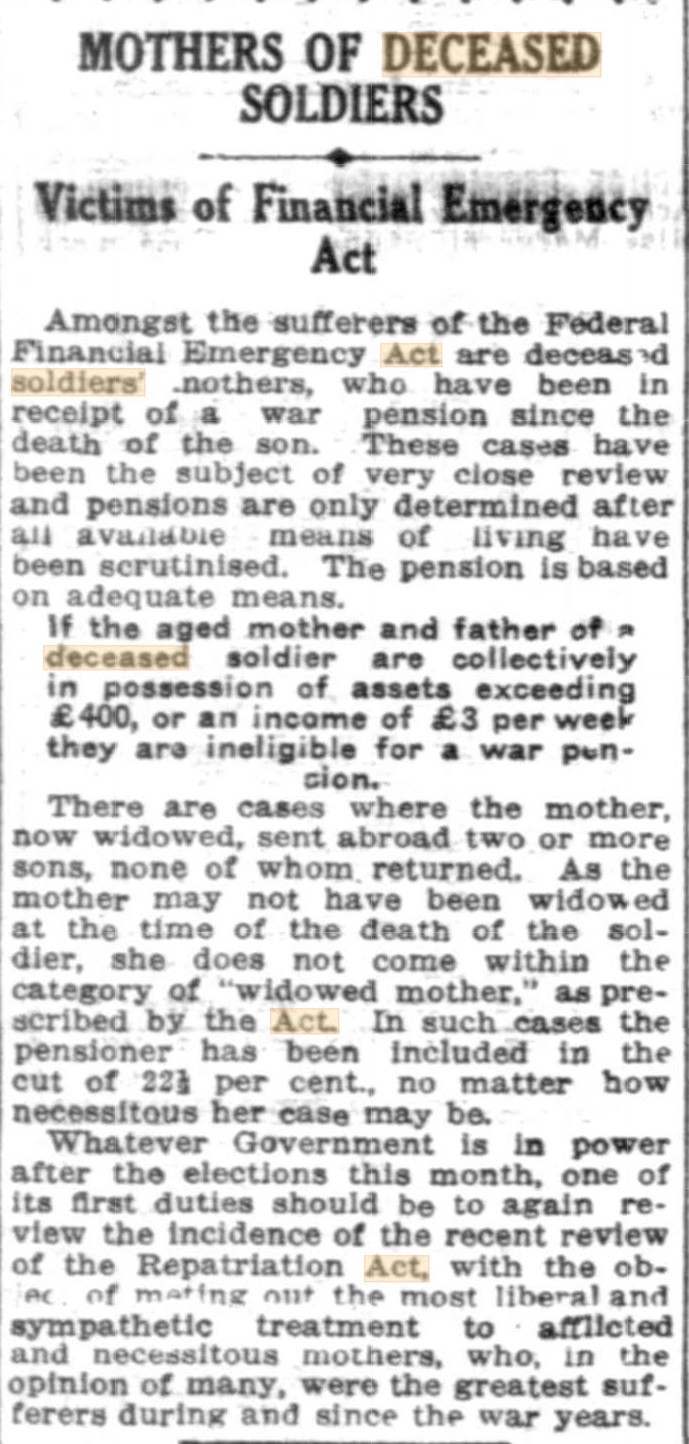
MOTHERS OF DECEASED SOLDIERS (1931, December 6). Sunday Times (Perth, WA : 1902 - 1954), p. 12. Retrieved from http://nla.gov.au/nla.news-article58653104
We have now come full circle with War Widows established, as well as the community still trying to help make up the difference through Legacy Day each year, who have been supporting veterans families since 1923, but the suspicion, scrutiny and attitude towards these grieving women then reads as a disgraceful chapter in our history.
What was sent back to Alice, according to the records, was in William's case; 'Leather cigarette case, Handkerchief, Razor hone' - then later; '2 Post cards, photo, letter.'. A photo of her or a sweetheart?
A similar 'practice' was applied to some of the nurses who served where, initially, they were told they could not have the Victory Medal as they had not served in a theatre of war - as occurred for Mary Hales Smith's daughter.
Also included is a list and photos of Manly teenagers who enlisted as soon as they could, although by then it was mid-1918 and they, sent into France, were allocated to grave duties in most cases. Some of them did not live into old age either on returning. These were sights and experiences they would not have recovered from – burying their Australian dead.
As young men of Manly they must have known each other prior to enlisting within days and weeks of each other.
Just placing their photos and a few notes here is a means of quietly stating what so many Australians really value and what they would grab should a bushfire or flood come through: the family photos and documents - all else can be replaced.
All this resonated through the years after this conflict, as well as through the next generation. This lends further insight into why, when memorials were proposed for each place where these women wept but had no gravesite to visit, they were so quickly approved. There was no headstone apart from a photo of one where he was buried in France, if he had been buried - there was no support from the bureaucracy, just patriarchal obliqueness - there was, however, people with hearts still living here, as Warringah Shire Council showed over and over after this horrendous conflict and as recorded in Council Minutes of Meetings:
Geo Sheppard and J. W. Austin. 28/12/25, requesting permission to erect a War Memorial in Mona Vale Park, at far the corner of Pittwater Road and Newport Road : Resolved- Memorial (crs. Parr 'Hitchcock) That the Engineer put in pegs on the park boundary, which will give the position for the Memorial, on the alignment in accordance with the plan of the Memorial, and the Engineer's plan for widening the road. Permission to erect the Memorial on this site to be granted
Surely we owe them more than to forget what they did or what they looked like, their scribbled letters, their dreams for tomorrow?
Surely just 10% of that allocated to a display of grandiose waste and cutting down of trees of commemoration could be better spent?
We choose to Honour them.
We choose to Remember them.
The Hales-Smith Family of Mona Vale
Richard Hales Smith, (1853 – 1928), born in Sheffield, Yorkshire, and married Mary Bradford (1852 – 1942), born in Helpston, Northamptonshire, daughter of son of William Bradford (1794 - 1858) and Millicent Haynes (1811 - 1860), in 1876 - U.K. records list a 'Marriage Settlement of Richard Hales Smith of Sheffield, Tobacconist and Mary Bradford of Masbrough, 25 Oct 1876.
Their son Frederick Haynes Smith was born in Notting Hill, London in July 1878. Their daughter Millicent Mabel Hales Smith (1885-1934) was born in April 1885 in Paddington, London. Their son James Bradford Hales Smith was born in Melbourne Australia in May 1893.
Around 1897 Mary's husband disappeared and she didn't hear from him again. A curious incident reported in a Western Australian newspaper may have been him and may point out where he then was, years later:
WOMEN'S DRESSES ' DAMAGED
A MAN'S STRANGE ACT.
A respectably-dressed man, Richard Hales Smith (53), a masseur, of Connaught-street, Hyde Park, London, was charged at Marylebone recently with wilfully damaging the dresses of two women, Rose Shelah, a typist, and Ellen Hamley, a married woman, both living at Fort-road, Bermondsey. According to the evidence, the women were travelling from the Marble Arch to Wormwood Scrubbs one afternoon on top of an omnibus. They were the only passengers on the roof of the 'bus when they started, but on reaching Praed-street, the prisoner got on to the 'bus and sat behind them. As they were passing through Westbourne Grove, Miss Shelah felt the skirt of her dress touched. She turned to Mrs. Hamley, her sister, and was drawing her attention to what had occurred when Mrs. Hamley said her dress had also been pulled; indeed, she had been pinched on the body. The prisoner then alighted, and the women, being suspicious, examined each other's skirts. They found that both their skirts had been cut in several places, the slits being several inches long, quite spoiling the dresses. Miss Shelah's costume cost 2 ½ guineas, and Mrs. Hamley's two guineas. Indignant at the treatment they had received from the prisoner, who was an entire stranger to them, they alighted, and with assistance overtook him and gave him into custody. 'Why should I cut the ladles' dresses; I have plenty of money,' remarked the prisoner as the constable was taking him to the station. When the policeman examined the omnibus he found cuts on the seat where the prisoner had sat. Mr. Paul Taylor ordered a remand and fixed bail at one surety in £100, or two in £50. WOMEN'S DRESSES DAMAGED (1906, September 13). The Daily News (Perth, WA : 1882 - 1950), p. 4 (SECOND EDITION). Retrieved from http://nla.gov.au/nla.news-article82458547
On March 15th, 1915 James enlisted in the A.I.F. and became part of the 20th Battalion, his brother Frederick enlisted on October 9th, 1915 and became part of the 4th Field Company Australian Engineers.
Their sister Millicent enlisted in the Australian Army Nursing Service on September 16th, 1916 and embarked that same day on the 'Karmala' for Bombay, disembarking on October 10th. She served as a Sister in the Victoria War Hospital and in 1917 was transferred to Officers Hospital Masok/Nasik, then the Hislop War Hospital, Secunderabad, and was transferred to Gerard Freeman Thomas Hospital for duty – all in Bombay. She returned to Australia via Calcutta on the 6th of November 1918.
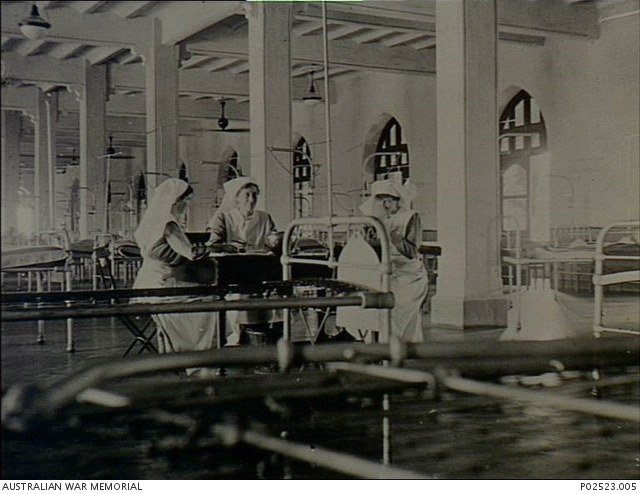
Bombay, India. c 1917. Three members of the Australian Army Nursing Service (AANS) sitting at a table in a ward at Victoria War Hospital (situated in a new railway office building close to the docks). On the left is Staff Nurse (S/Nurse) Edith Maud Philp, who was one of a contingent of one hundred nurses requested to work in British War Hospital in Bombay. S/Nurse Philp, who trained at Caulfield Hospital, travelled to Bombay on the Canberra. She worked at the Victoria War Hospital, a hospital with two hundred beds on each of the first three floors and Sister's quarters on the fourth. This hospital received the most serious cases as it was five minutes from the dock. Patients were received from Mesopotamia, and they included British Prisoners of War (POWs) released by the Turks, Turkish prisoners and British troops. At one stage British troops suffering from heatstroke were received at one thousand a week. (Donor E. Pearce)
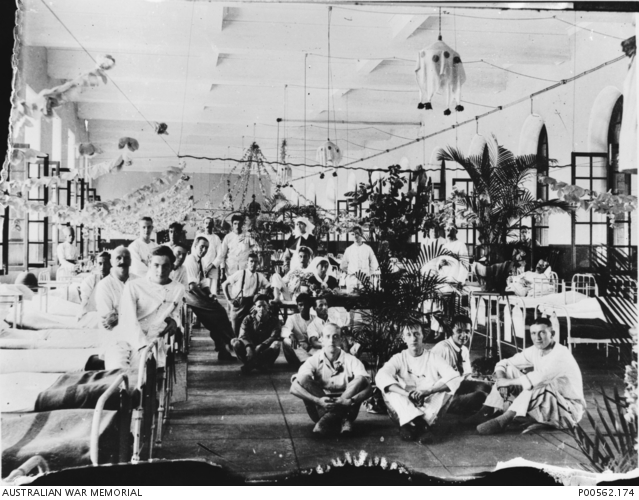
Bombay, India. 1916-12-25. Patients and staff in one of the wards of the Victoria War Hospital decorated with Christmas decorations. The hospital was staffed by members of the Australian Army Nursing Service (AANS) whose patients included members of the Mesopotamian Expeditionary Force and captured Turkish prisoners. On the day this photograph was taken new eighty surgical cases arrived at the hospital.
The Mesopotamian campaign was a campaign in the Middle Eastern theatre of World War I fought between the Allies represented by the British Empire, troops from Britain, Australia and the vast majority from British India, against the Central Powers, mostly from the Ottoman Empire.
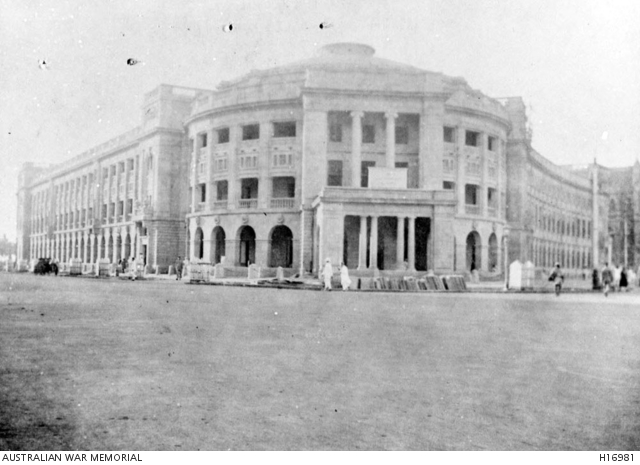
Bombay, India. c. 1916. The Gerard Freeman Thomas Hospital which was staffed by Australian Army Nursing Staff sisters. (Donor Sister M.E. Campbell)
Millicent went back to work, married and had a daughter, but passed away before reaching her 50th year:
MRS. M. M. JOHNSTON.
By the death of Mrs Millicent Mabel Johnston, wife of Mr W G Johnston, stock inspector, the Upper Richmond River district suffered the loss of an active worker for charity and of the Casino branch of the Country Women's Association.
Mrs Johnston was the youngest daughter of Mr and Mrs Hales-Smith of London, and a niece of the late Sir James Bradford, of Sussex. After coming to Australia she took a course of training at the Royal Prince Alfred Hospital Sydney, and at the Royal North Shore Hospital, and then took up nursing as a profession. At the outbreak of the war she was matron of a private hospital at Coonamble, and enlisted for war service from that town. For some months she was attached to the Randwick Military Hospital, and in 1915 she was drafted to India where she put in four years' service in military nursing homes.
Returning to Sydney in 1919, she became attached to the Bathurst Red Cross soldiers' nursing home, and also served for a time at Bodington Red Cross Home. Other centres at which Mrs Johnston acted as sister or matron were Murwillumbah and Casino. Mrs Johnston, after her marriage, was responsible for raising the funds for the Country Women's Association's' rest-room on the showground at Casino She was accorded military honours at her funeral. MRS. M. M. JOHNSTON. (1934, June 13). The Sydney Morning Herald (NSW : 1842 - 1954), p. 18. Retrieved from http://nla.gov.au/nla.news-article17091070
FUNERAL NOTICE.
JOHNSTON.—The FUNERAL of the late MILLICENT MABEL JOHNSTON, dearly beloved wife of Mr. W. G. Johnston, of Kyogle, will leave the Church of England, Kyogle, TO-DAY (MONDAY), at 11 a.m., for the Kyogle Cemetery. G. GROVE. Funeral Director. Family Notices (1934, June 4). Northern Star (Lismore, NSW : 1876 - 1954), p. 4. Retrieved from http://nla.gov.au/nla.news-article94535450
JOHNSTON -June 3 1934 at Memorial Hospital Kyogle Millicent Mabel dearly beloved wife of Walter George Johnston (Stock Inspector) of Kyogle and formerly of Casino, aged 49 years. Family Notices (1934, June 12). The Sydney Morning Herald (NSW : 1842 - 1954), p. 8. Retrieved from http://nla.gov.au/nla.news-article17102827
JOHNSTON. - June 3, at the Memorial Hospital, Kyogle, Millicent Mabel (Sister M. M. Smith, ex-Australian Army Nursing Staff, in India during Great War), beloved wife of Walter George Johnston, stock inspector, Kyogle, youngest daughter of Mrs. Hales-Smith, and niece of Sir James Bradford, England, aged 49 years. Interred at Kyogle June 4. Family Notices (1934, June 16). The Sydney Morning Herald (NSW : 1842 - 1954), p. 14. Retrieved from http://nla.gov.au/nla.news-article17105904
IN MEMORIAM
JOHNSTON.—Cherished memories of my dear wife, Millicent Mabel (Sister M. M. Smith, A.A.N.S., in Great War), who passed away at Kyogle Memorial Hospital, June 3, 1934. Inserted by W. G. Johnston, Casino. Family Notices (1939, June 2). Northern Star (Lismore, NSW : 1876 - 1954), p. 8. Retrieved from http://nla.gov.au/nla.news-article98579240
Frederick Haynes Smith, 4th Field Company Engineers – Sapper – late 14th Reinforcements 1st Field Company Engineers, was a postal telephone mechanic prior to enlisting and aged 36 and 3 months when he enlisted. He disembarked in Alexandria on February 27th, 1916 ex A.54, proceeded to Tel-el-Kabir, Zeitoun. On June 1st 1916 he embarked on the 'Canada' for Marseilles, disembarking on the 9th and joined the B.E.F., British Expeditionary Force.
On the 25th of August he was docked a days pay for being absent from his billet after 9 pm. That's all that appears on his record card until December 6th when he is listed as 'Killed in Action' in the 'Field, France'.
SMITH.—Killed in action December 6 1916 Sapper Frederick Haynes Smith dearly loved eldest son of Mrs. Hales Smith Mona Vale. His duty done. Family Notices (1916, December 30). The Sydney Morning Herald (NSW : 1842 - 1954), p. 10. Retrieved from http://nla.gov.au/nla.news-article15682430
A Sapper is a soldier who performs a variety of military engineering duties, such as breaching fortifications, demolitions, bridge-building, laying or clearing minefields, preparing field defences, and road and airfield construction and repair.
Frederick's mother received back:
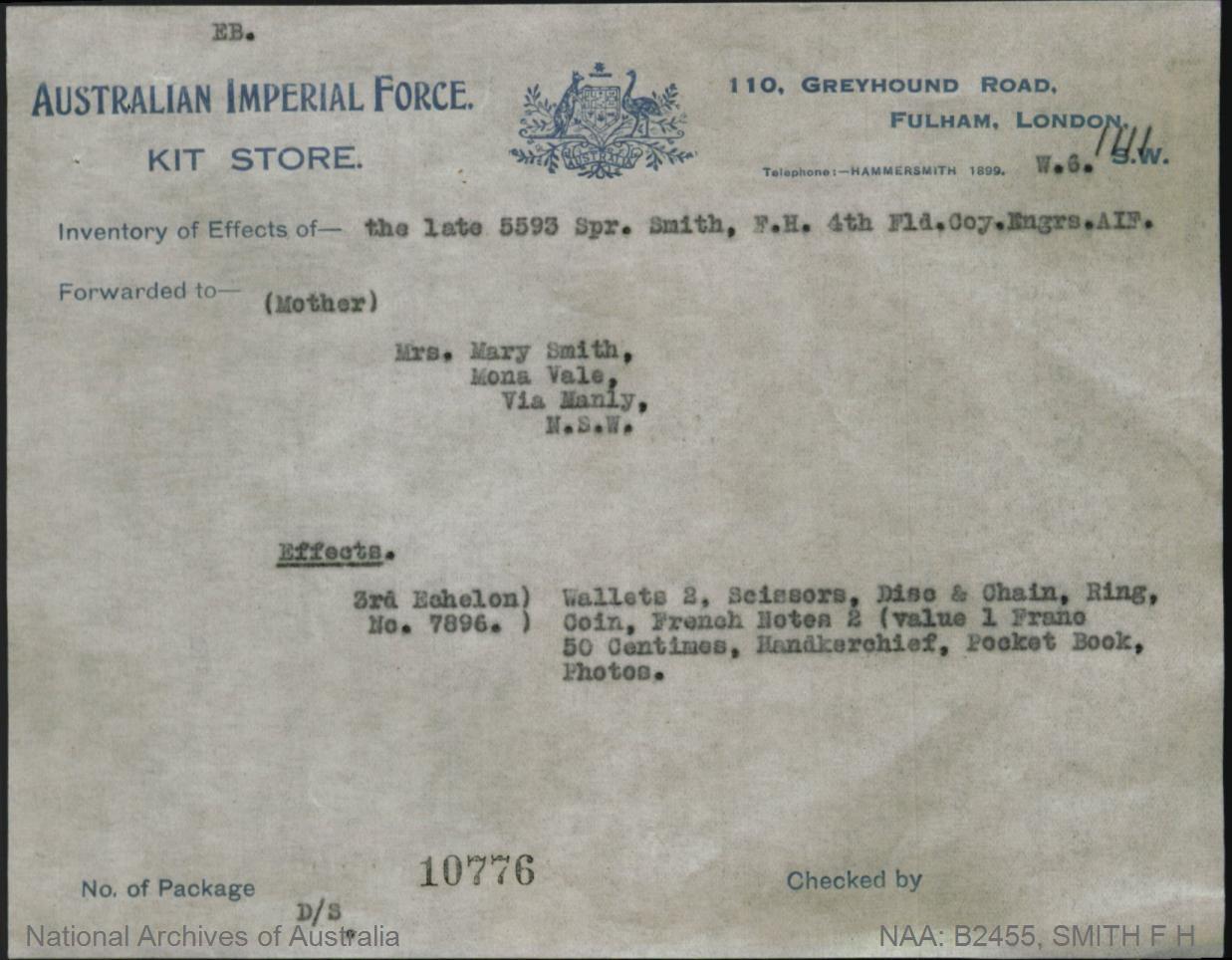
No one seemed to know exactly what had happened or exactly where he died - although the War Diary for the 4th Field Company Engineers shows 3 other men were killed and 4 men and 1 officer wounded at the same time and they had been near the Decauville Railway of the Cobazet Estate, which was a 12 km long narrow-gauge railway near Mosset in the Pyrénées-Orientales department in southern France, and also working on the Longueval Road, which also has a Cemetery that now contains 223 burials and commemorations of the First World War, with 47 of the burials of unidentified men - although there are special memorials for them. The Longueval village was part of the Battle of the Somme. There are commemorations "In honour of the men of the New Zealand Division, first battle of the Somme, 1916", and near the church stands a British trench mortar that would have been used for short-range bombardments of enemy positions, with large calibre model being introduced late in 1916.
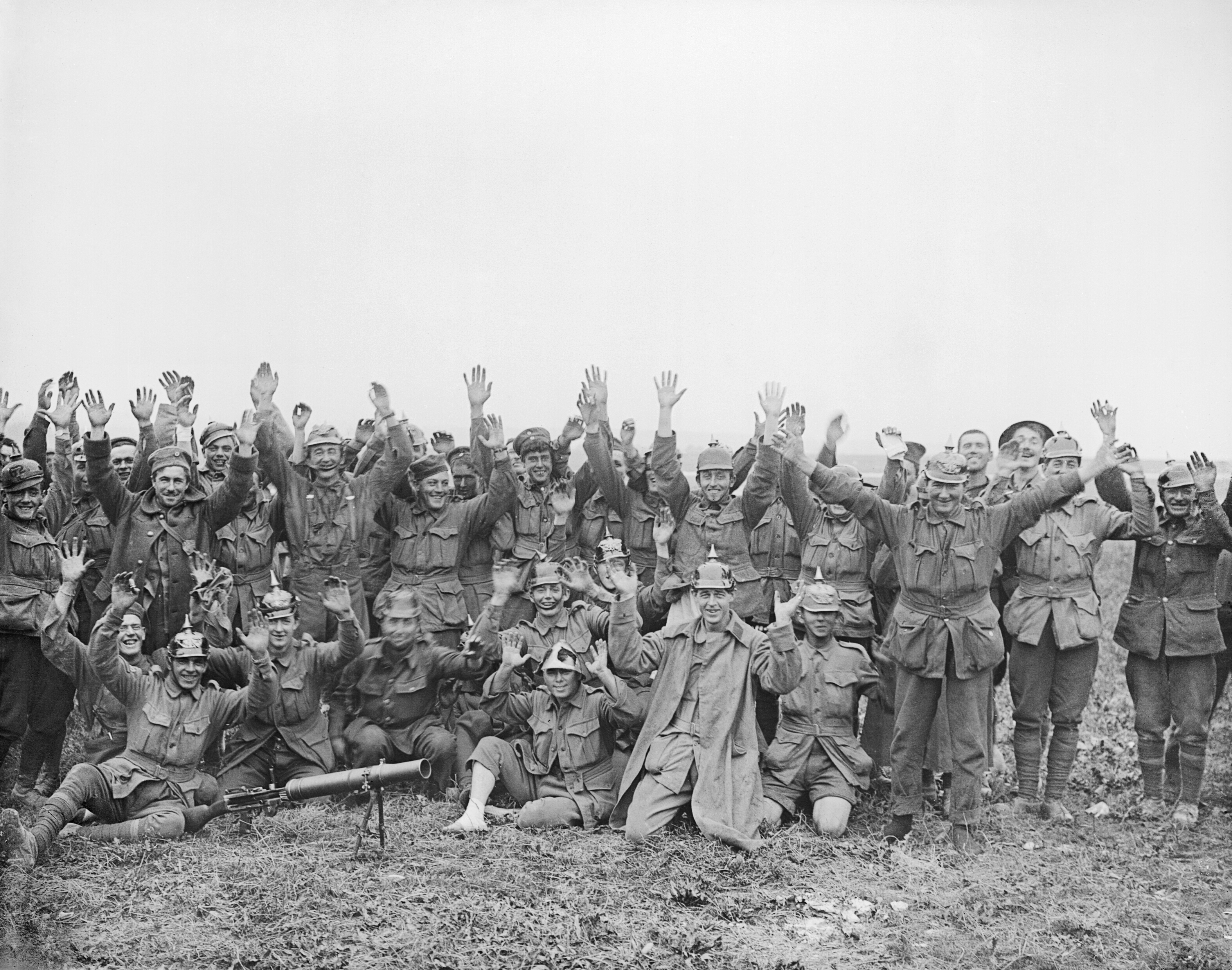
Men of the 1st Anzac Division, some wearing German Helmets, pose for the camera after fighting near Pozieres on 23 July 1916 during the Battle of the Somme. Battle of Pozieres Ridge. Troops of the 1st Australian Division (1st ANZAC Corps), some wearing German helmets, photographed between La Boisselle and Pozieres on their return from the taking of Pozieres, 23 July 1916. Photo courtesy Imperial War Museum.
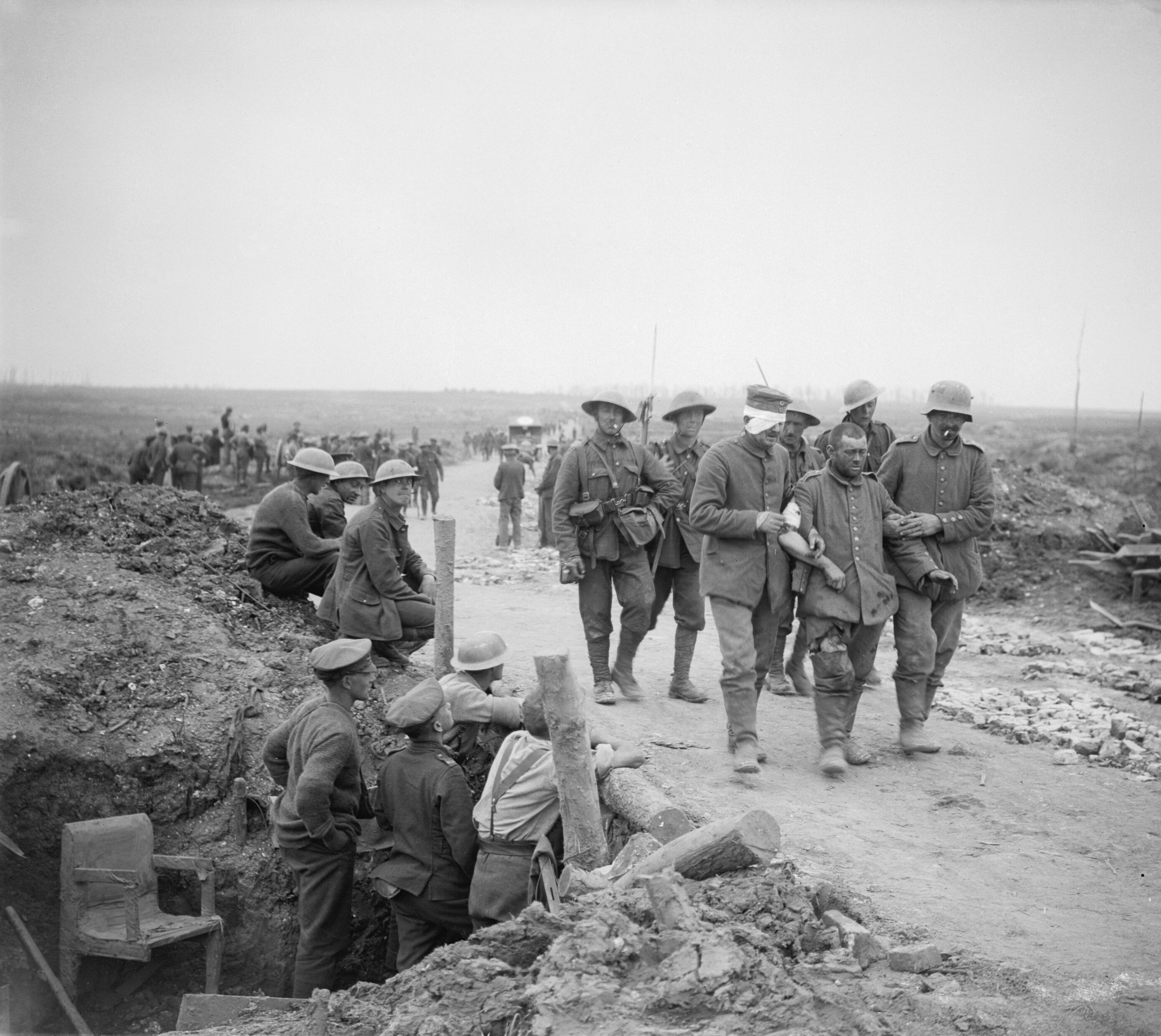
British gunners watching German prisoners passing after the taking of Guillemont, 3 September 1916 - image courtesy the Imperial War Museum.
Although historians and records indicate this battle was finished by November 18th 1916 as both sides tried to survive the weather, clearly that didn't stop shells killing people. More than three million men fought in the battle and one million men were wounded or killed, making it one of the deadliest battles in human history. The 57,470 casualties suffered by the British, including 19,240 killed, were the worst in the history of the British Army. In less than seven weeks in the fighting at Pozières and Mouquet Farm three Australian divisions suffered 23,000 casualties. Of these, 6,800 men were killed or died of wounds.
The 'Place; particulars not yet to hand' record and the 4th's War Diary page from that date, December 6th, 1916:
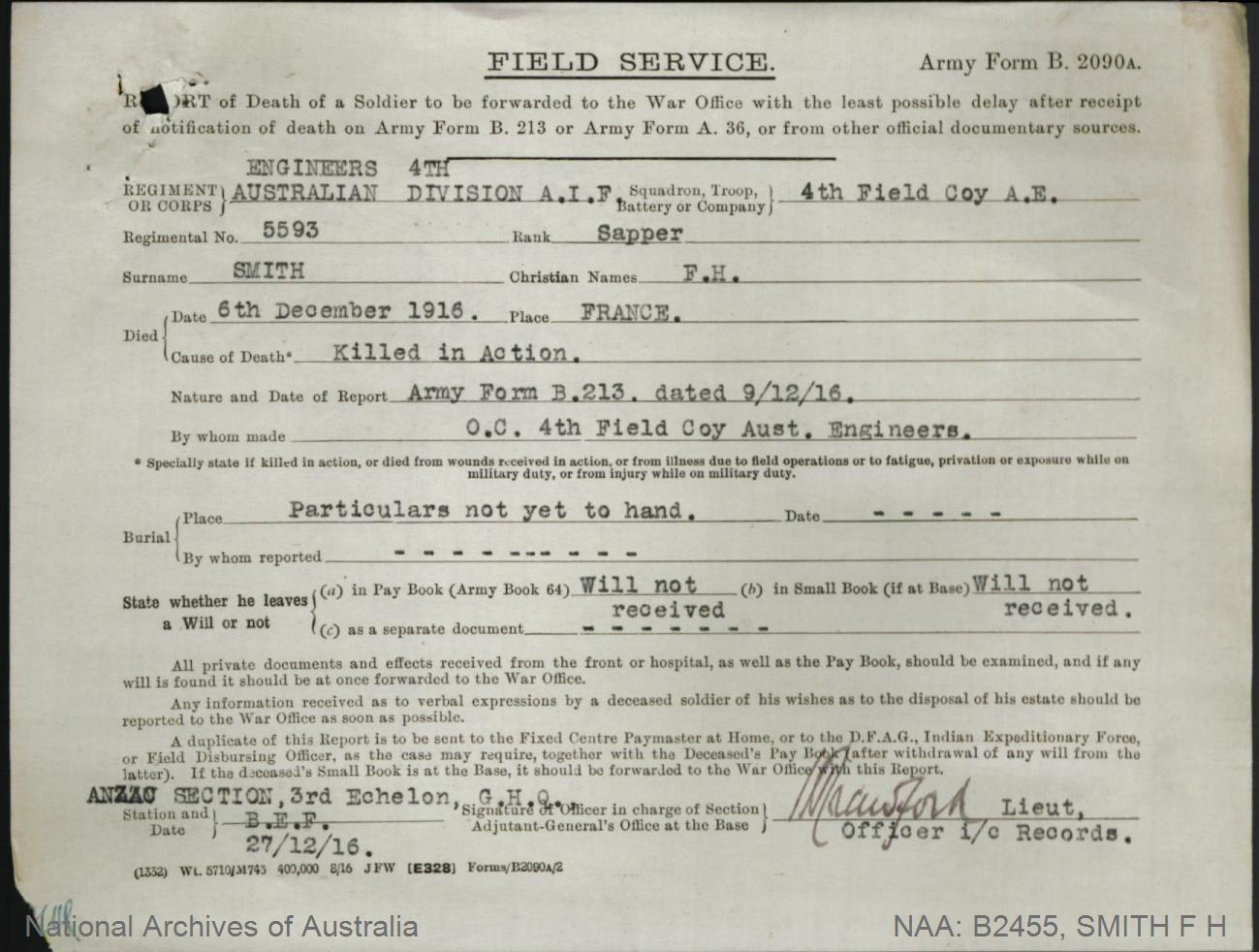
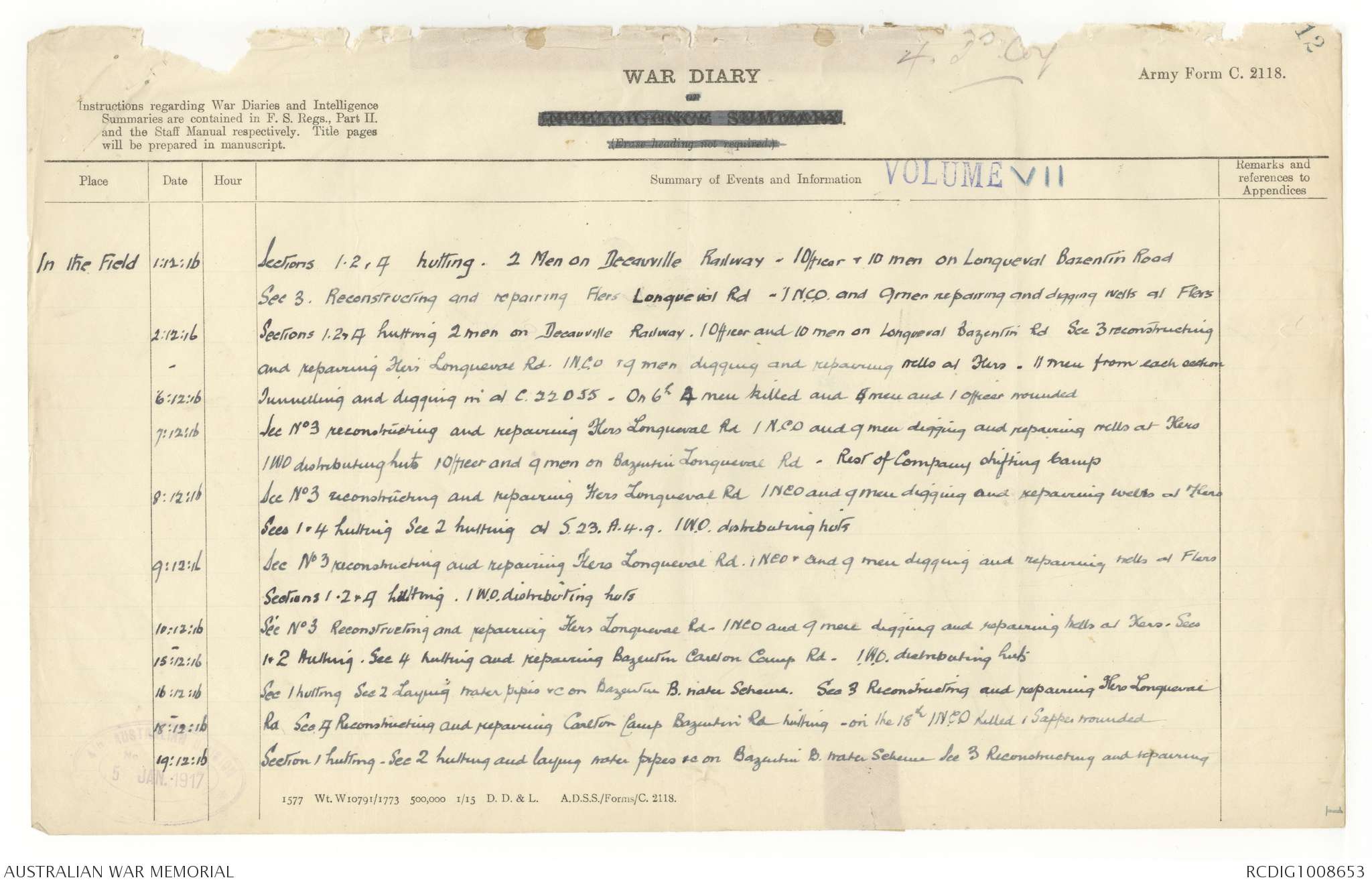
After her son James died Mary moved to Marrickville and then to a cottage at the foot of the Blue Mountains. By the early 1920's she received, regarding her eldest son:
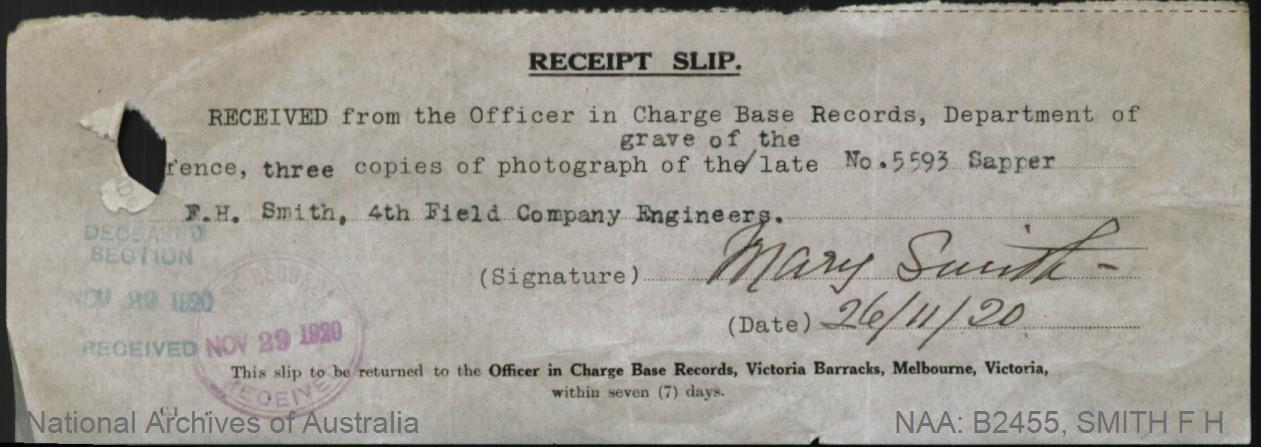
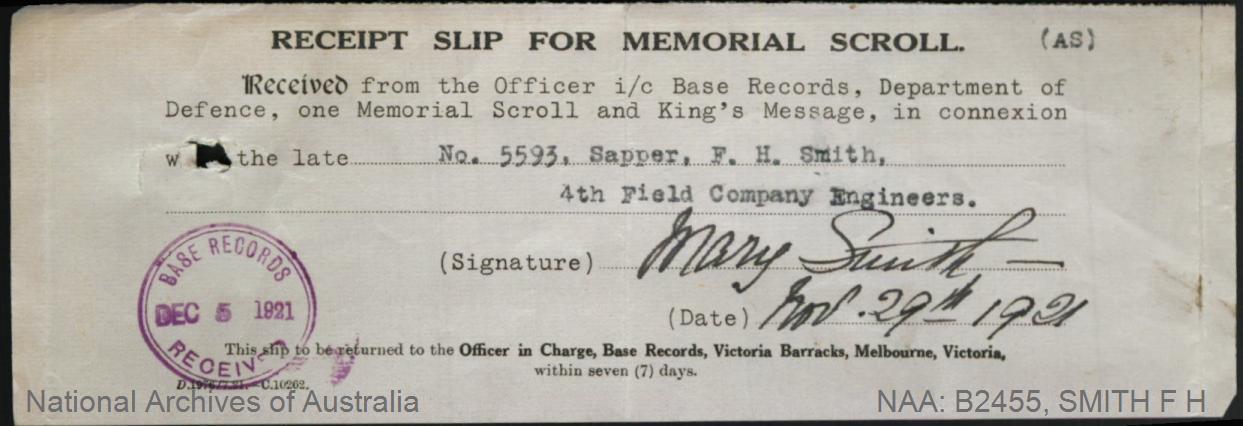
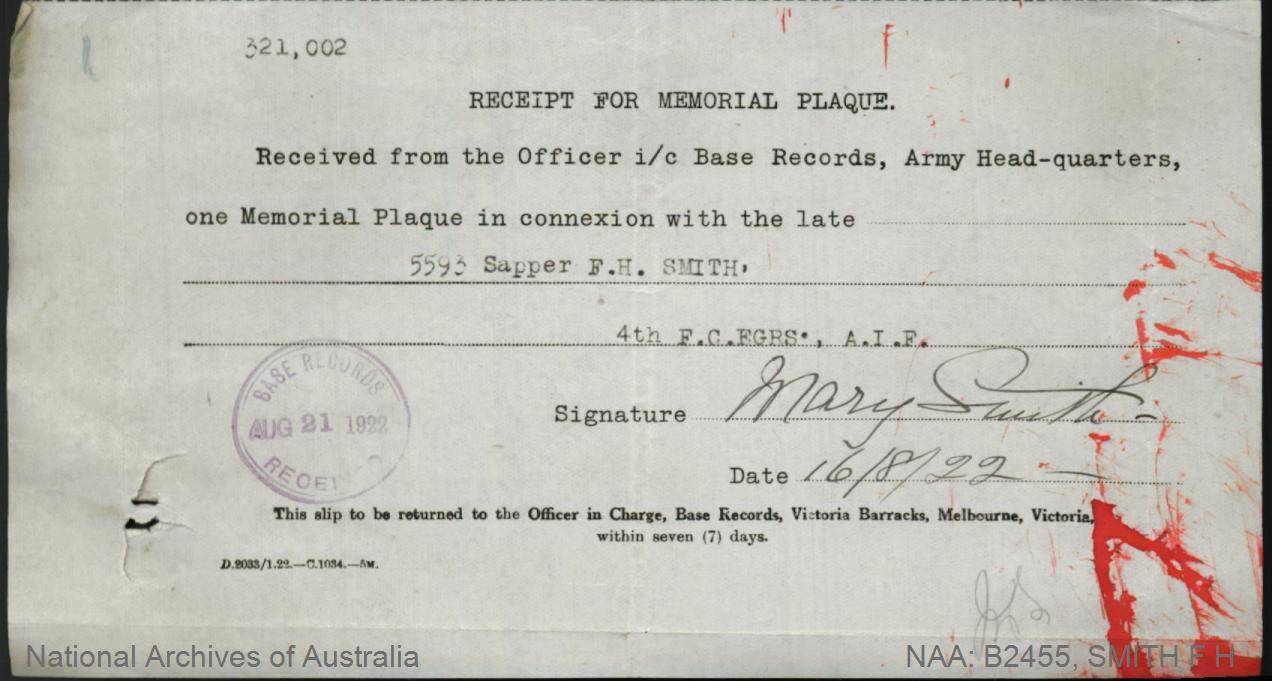
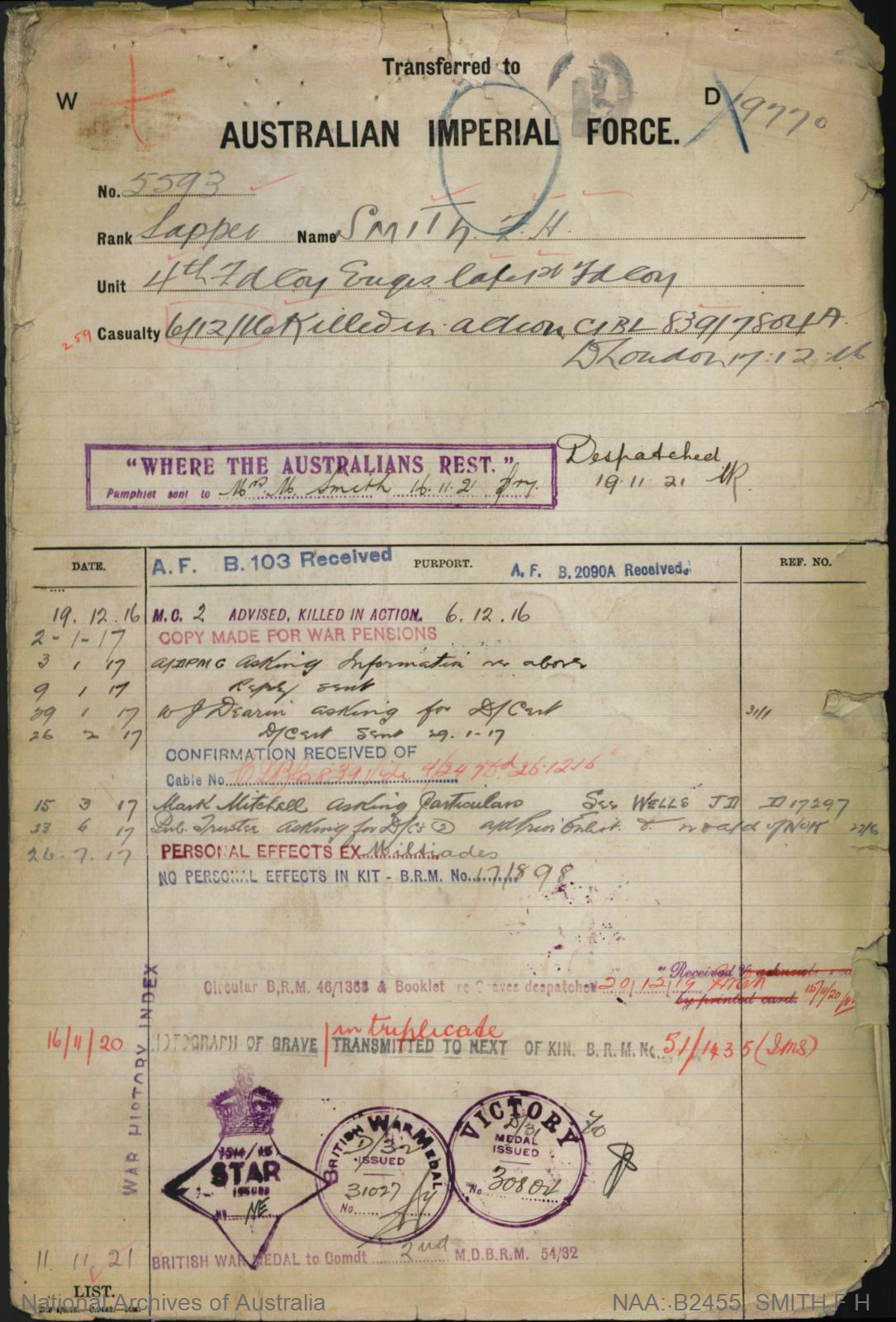
His remains were interred in the Bernafay Wood British Cemetery, Montauban, Picardie, France. Frederick Haynes Smith's name is located at panel 25 in the Commemorative Area at the Australian War Memorial in Canberra as well.
The Bernafay Wood British Commonwealth War Graves Commission Cemetery (also known as the Bernafay Wood British Cemetery) is a cemetery located in the Somme region of France commemorating British and Commonwealth soldiers who fought in the Battle of the Somme and against the German 1918 spring offensive in World War I. The cemetery contains mostly those who died between July 1916 and April 1917 and March-August 1918.
On 1 July 1916, Montauban was captured by the British 30th and 18th Divisions. The heavily fortified Bois de Bernafay (Bernafay Wood) was taken by the 9th Scottish Division on 4 July 1916. Both the village and the wood were lost by the British in the German spring offensive of 1918, with the wood captured by the Germans in March-April 1918. However, the village was retaken by the 7th Buffs and 11th Royal Fusiliers of the 18th Division on 25 August and the wood by the 9th Scottish on the 27th.
The cemetery was formally begun by an area dressing station in August 1916, with casualties beginning to be buried on 8 July. It was used as a front line cemetery until April 1917. At the end of the war, the cemetery contained a total of 284 burials. After the reinternment of casualties from the Bernafay Wood North Cemetery and battlefields to the east of the wood, the cemetery now contains a total of 945 burials, of which 529 are identified and 417 are unidentified. Special memorials are dedicated to 11 British soldiers believed to be buried among the unknown and 12 soldiers whose Bernafay Wood North Cemetery graves were destroyed by shell fire.
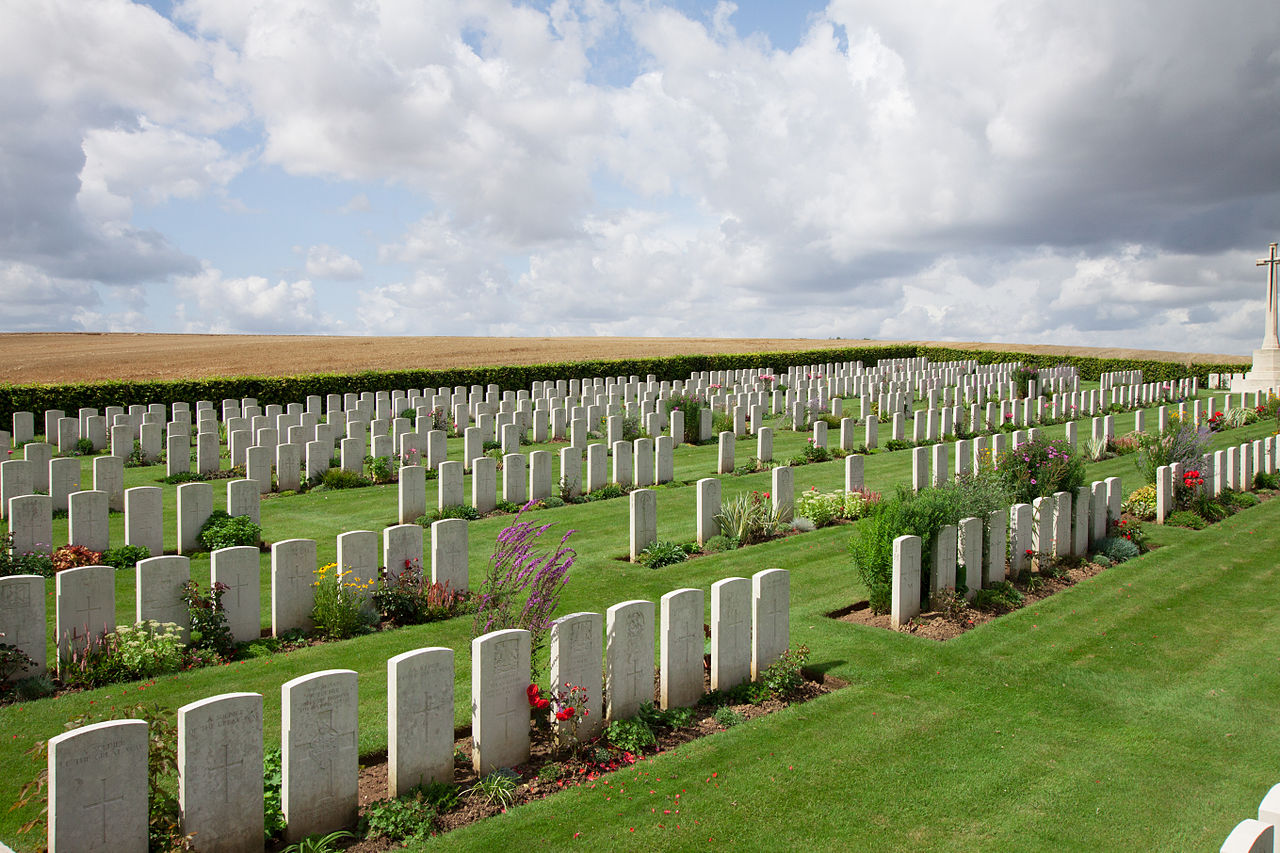
Bernafay Wood British Cemetery. Photo courtesy: Wernervc
The modern day cemetery was designed by Sir Herbert Baker and Arthur James Scott Hutton.
James Bradford Hales Smith, who enlisted on March 15th, 1915, became part of the 20th Battalion. The Australian War Memorial states the 20th Battalion was raised at Liverpool in New South Wales in March 1915 as part of the 5th Brigade. A sprinkling of the 20th's original recruits had already served with the Australian Naval and Military Expeditionary Force (AN&MEF) in the operations to capture German New Guinea in 1914. The 20th left Australia in late June, trained in Egypt from late July until mid-August, and on 22 August landed at ANZAC Cove. Arriving at Gallipoli just as the August offensive petered out, the 20th's role there was purely defensive. From 26 August, until its withdrawal from the peninsula on 20 December, the 20th Battalion was responsible for the defence of Russell's Top.
After further training in Egypt, the 20th Battalion proceeded to France. It entered the trenches of the Western Front for the first time in April 1916 and in the following month had the dubious honour of being the first Australian battalion to be raided by the Germans. The 20th took part in its first major offensive around Pozieres between late July and the end of August 1916. After a spell in a quieter sector of the front in Belgium, the 2nd Division, which included the5th Brigade, came south again in October. The 20th Battalion provided reinforcements for the attack near Flers between 14 and 16 November, launched in conditions that Charles Bean described as the worst ever encountered by the AIF.
In 1917, the 20th was involved in the follow-up of German forces after their retreat to the Hindenburg Line, and was one of four battalions to defeat a counter-stroke by a German force, almost five times as strong, at Lagnicourt. The Battalion took part in three major battles before the year was out, second Bullecourt (3-4 May) in France, and Menin Road (20-22 September) and Poelcappelle (9-10 October) in Belgium.
The spring of 1918 brought a major German offensive. The 20th Battalion was one of many Australian battalions rushed to stop it, and it encountered some particularly severe fighting when ordered to attack at Hangard Wood on 7 April. With the German Army's last desperate offensive defeated, the 20th participated in the battles that pushed it ever closer to defeat: Amiens on 8 August, the legendary attack on Mont St Quentin on 31 August, and the forcing of the Beaurevoir Line around Montbrehain on 3 October. Montbrehain was the battalion's last battle of the war. It was disbanded on 20 April 1919.
James Hales Smith, a Jeweller with Hardy Brothers prior to his enlistment. He embarked at Sydney on the HMATA '35' Berrima on the 26th of June 1915, was transferred from Monte Video to Weymouth on August 28th 1916, was promoted to Lance Sergeant on October 11th, 1915, and was admitted to the hospital ship near the Gallipoli peninsula on October 18th with Influenza, the disease that killed so many during and after this conflict, and subsequently transferred to Malta.
He rejoined the 20th Battalion on August 9th in France but was again sent to hospital, still ill, this time with enteric fever. By November 13th, 1916 he was being sent to England per the 'Morea' from Malta and was admitted into the 3rd Southern General Hospital in Oxford, England.
He rejoined his unit and was wounded on February 5th, 1917 - a gunshot wound to the face. On June 2nd 1917 he was released from hospital and rejoined the 20th on the 9th of June.
On August 18th he was promoted to Temporary CSM. On October 2nd he was promoted to second Lieutenant. On January 29th 1918 he was promoted to Lieutenant. He had leave in Paris on February 23rd, 1918.
On April 15th he was wounded in action again, a shrapnel wound to his thigh, and another to his abdomen. He was in Rouen at the time. They patched him up, and sent him to England on the 19th and by the 20th Wandsworth Hospital were attending to the shrapnel and another gunshot wound to his thigh - his third wound - no explanation is in his record how he sustained this gunshot wound.
He rejoined his unit on July 6th, 1918. On July 31st he was wounded again, his 4th occasion, again with shrapnel, severely this time. He was transferred by the 6th Australian Field Ambulance admitted to the 5th Casualty Clearing Station where he died of his wounds on August 2nd, 1918.
SMITH.—Died of wounds, August 2, 1918, Lieut. James Bradford Hales Smith, dearly loved youngest son of Mrs. Hales Smith, Mona Vale, in his 25th year. His duty done. Family Notices (1918, August 17). The Sydney Morning Herald (NSW : 1842 - 1954), p. 12. Retrieved from http://nla.gov.au/nla.news-article15798616
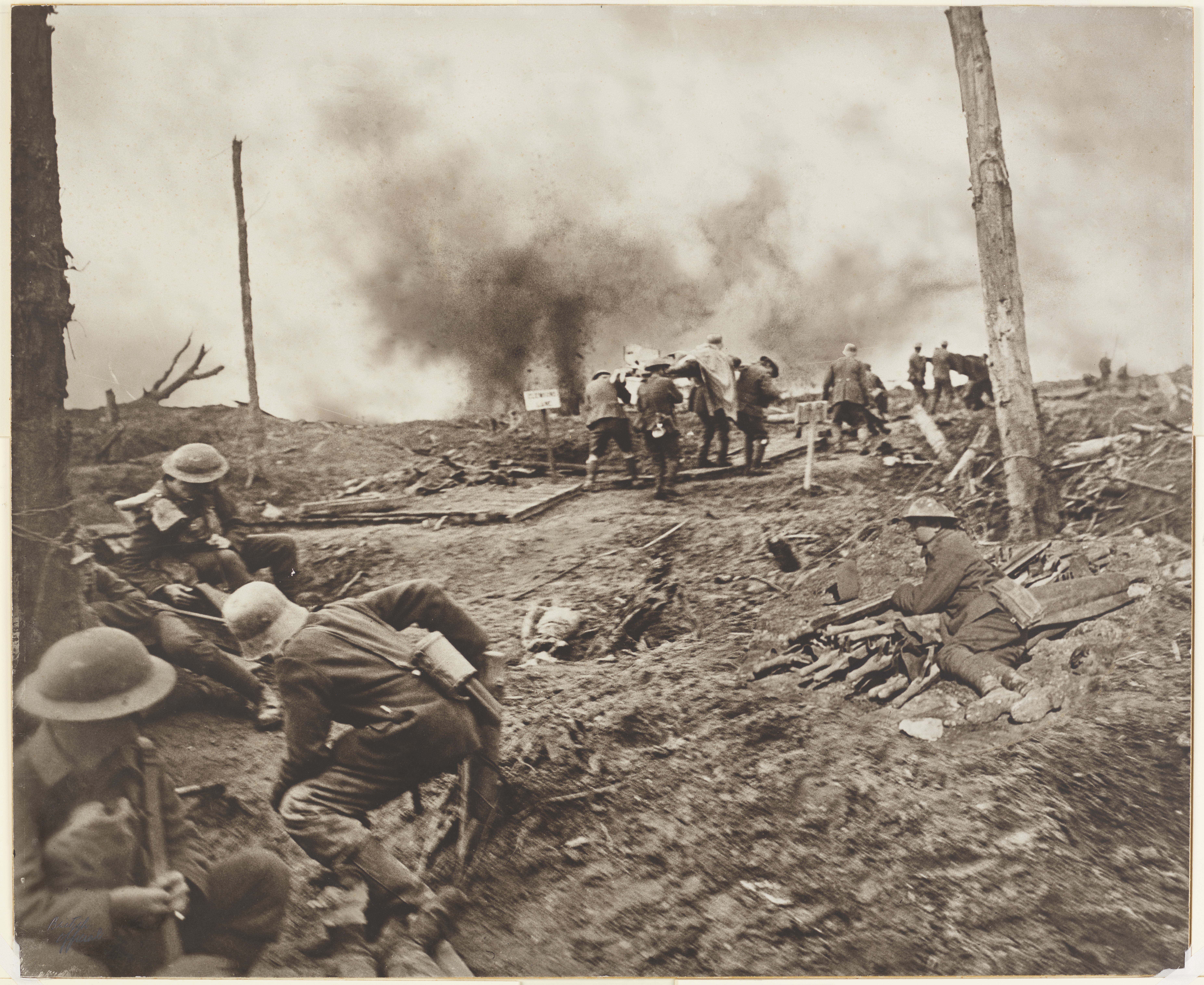
Carrying in the wounded during the height of battle. (located at XV*/Wor W 1/3). From Exhibition of war photographs / taken by Capt. F. Hurley, August 1917- August 1918, courtesy State Library of New South Wales.
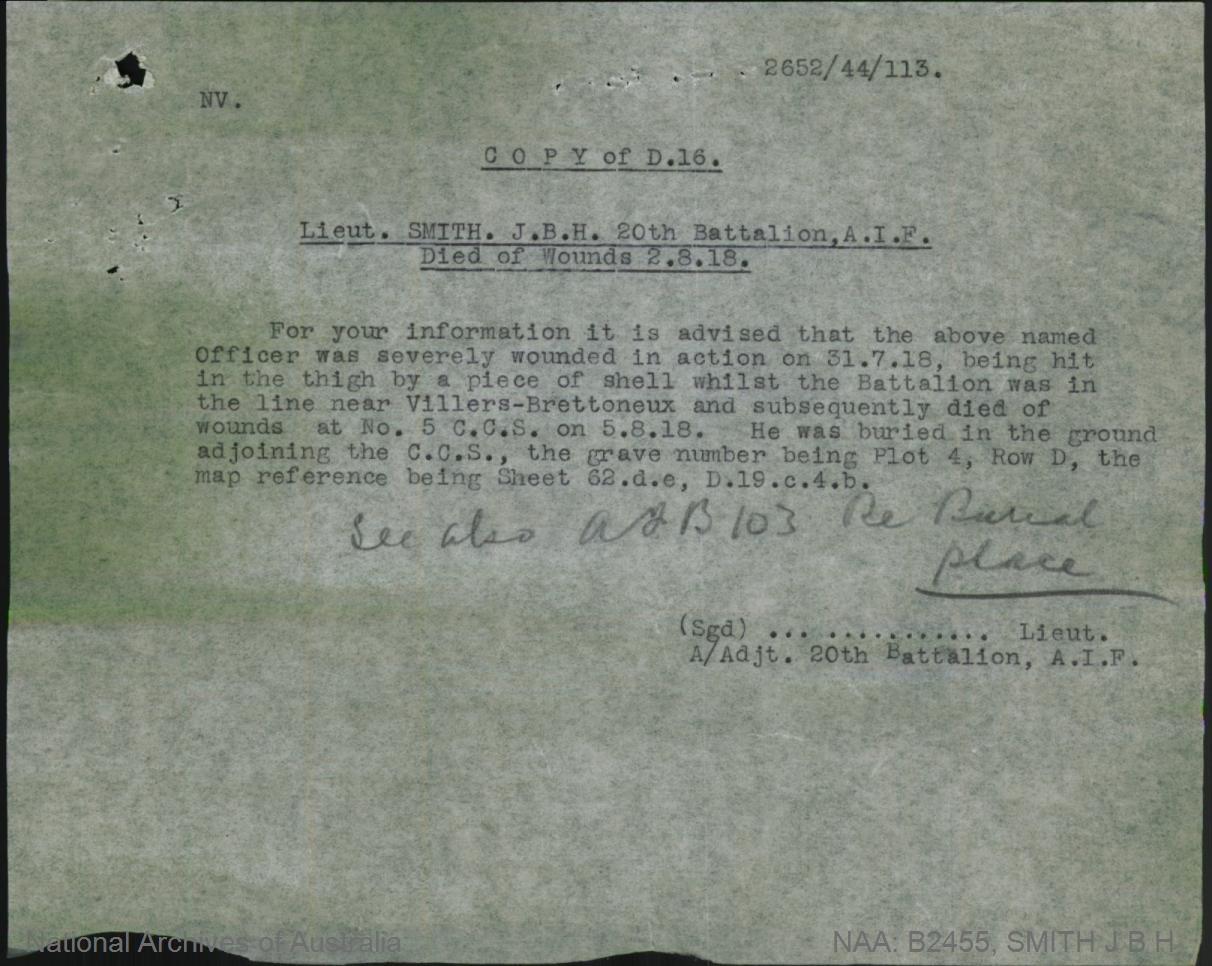
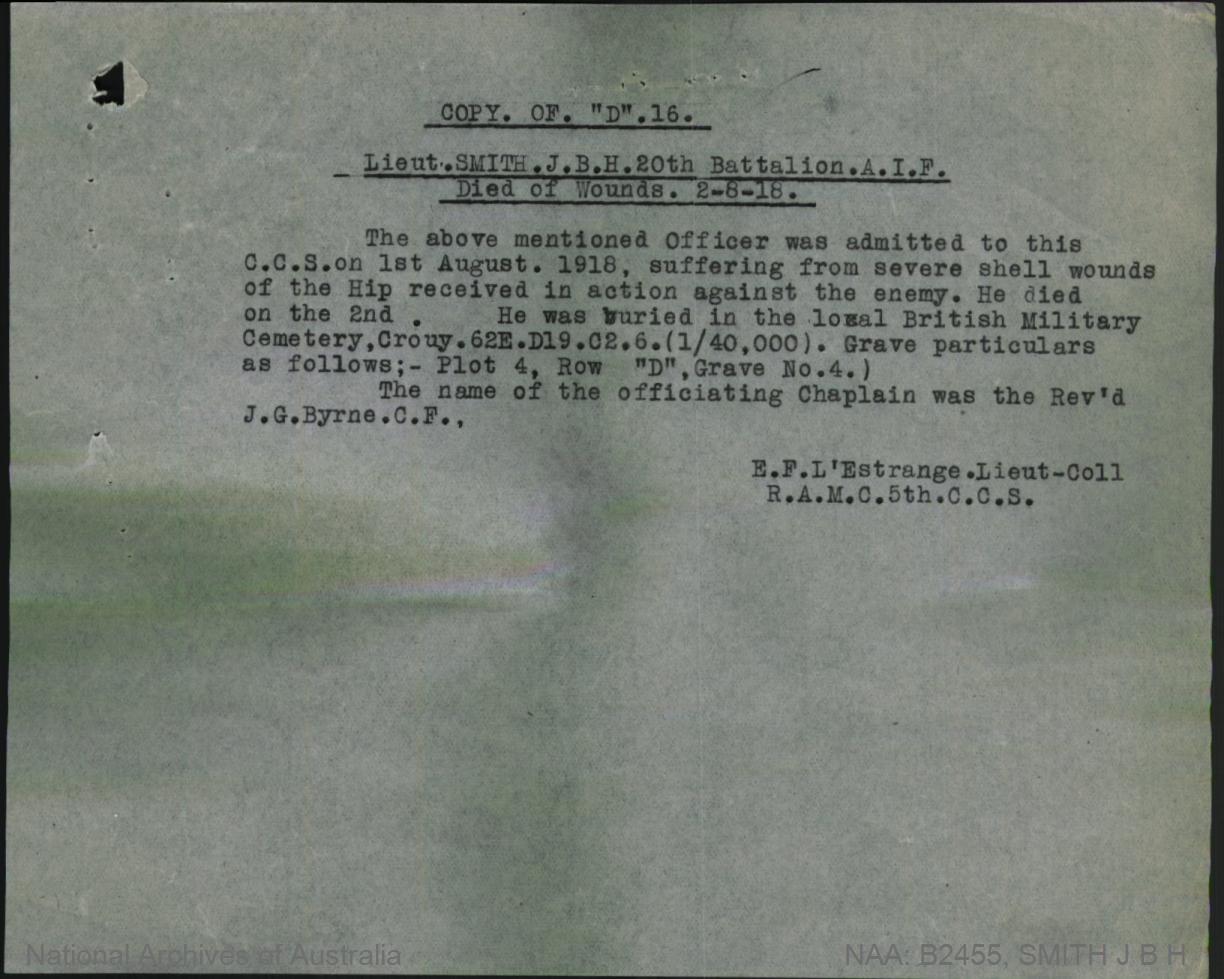
Mary Hales Smith received back effects that may have still had the smell of her son on them:
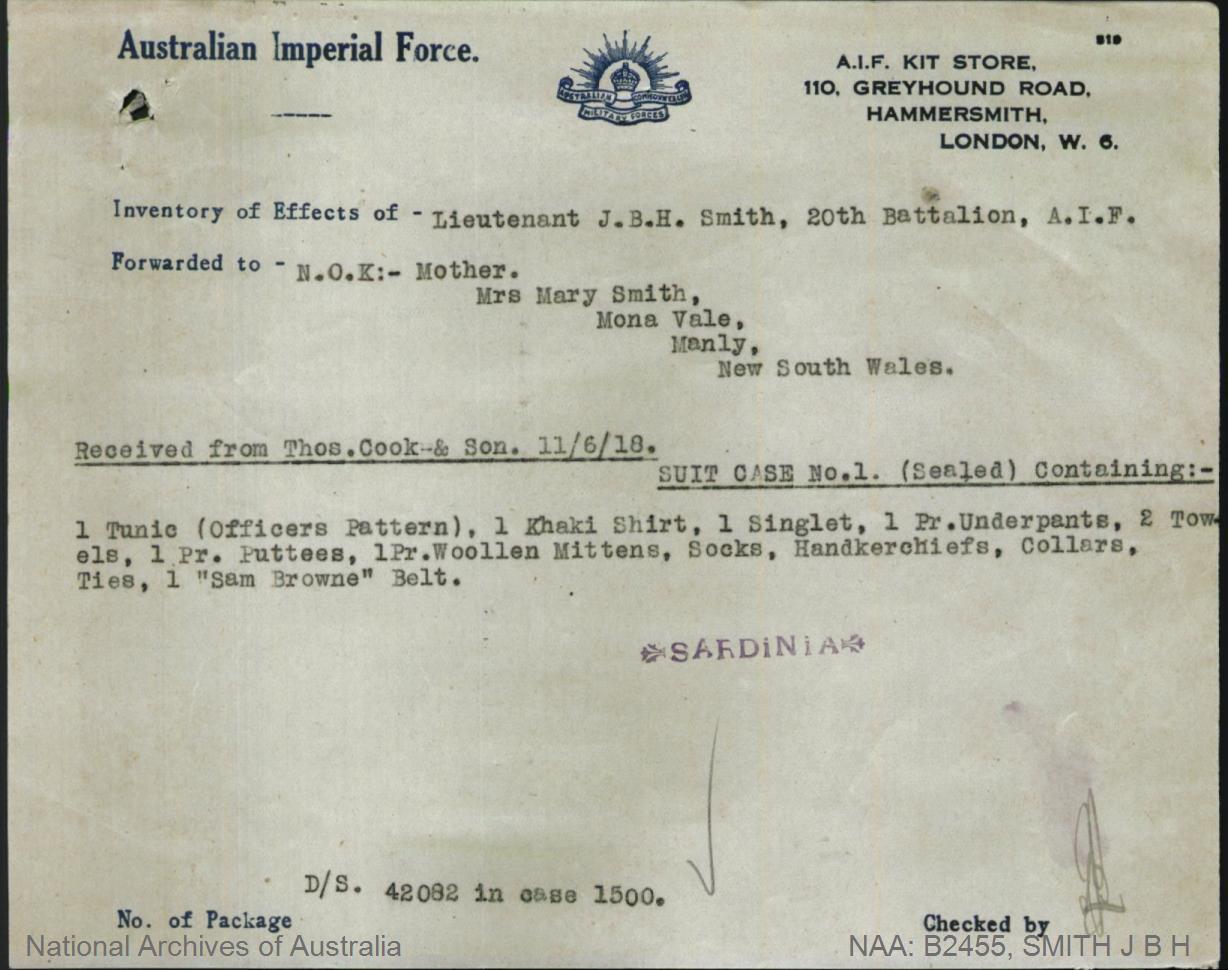
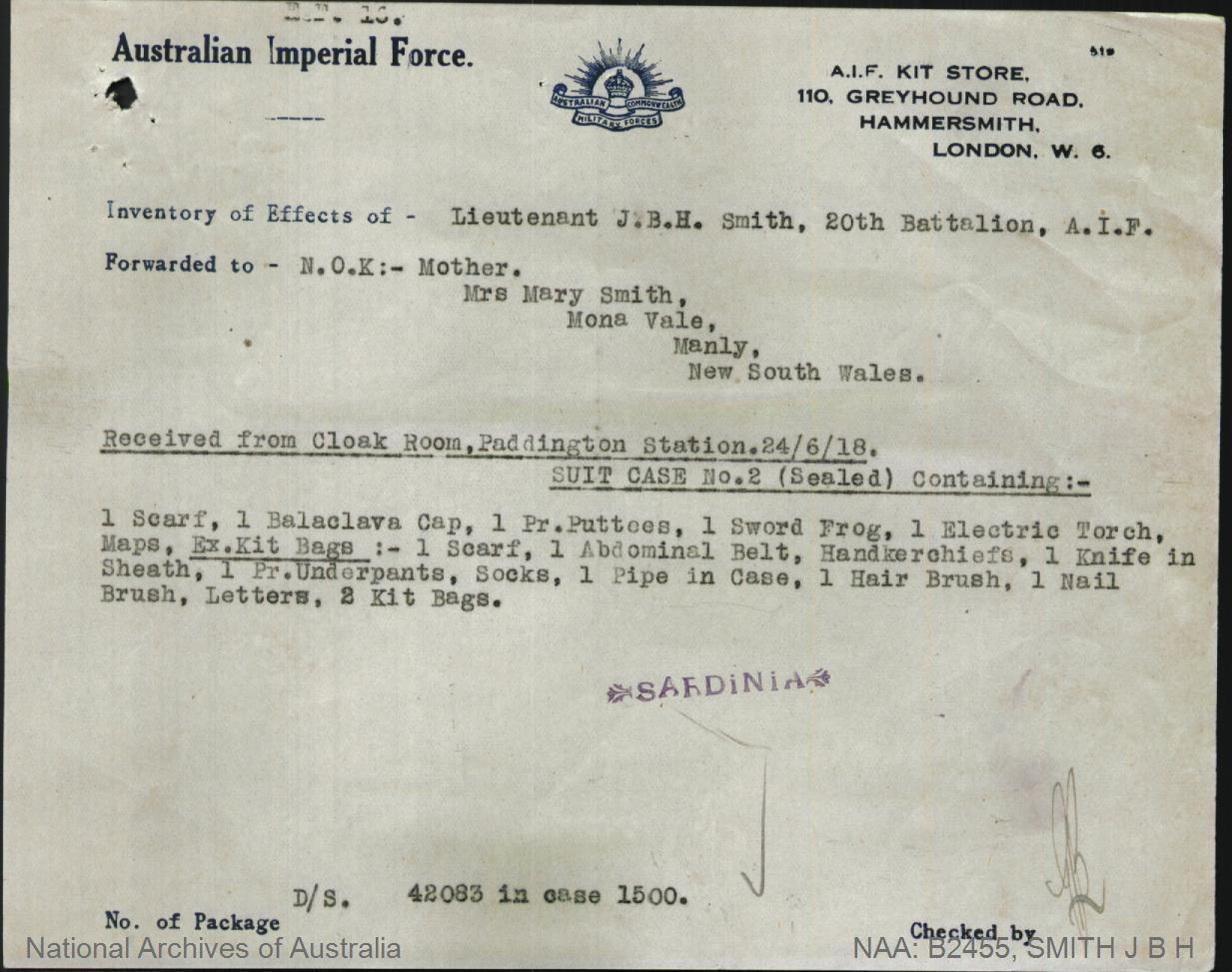
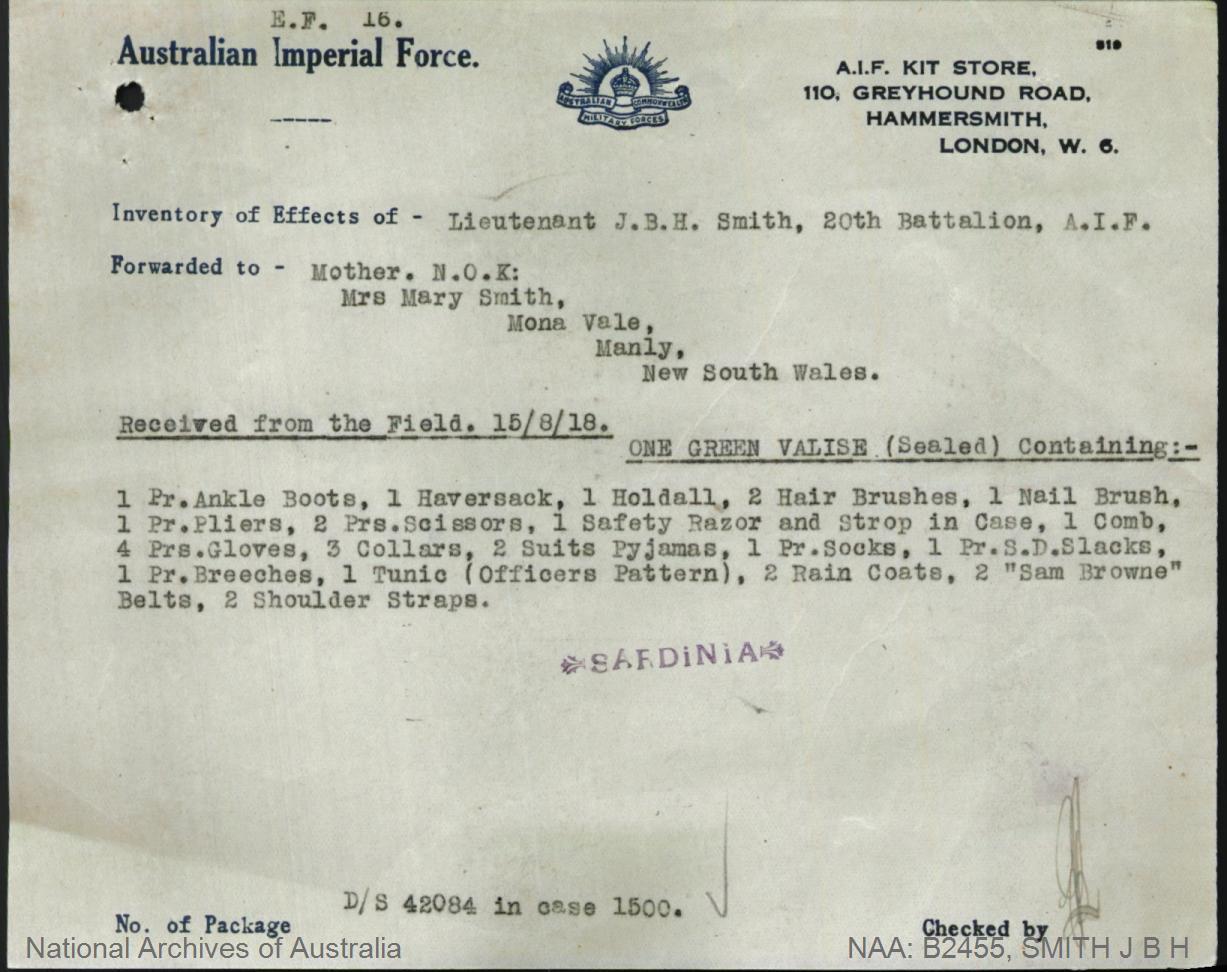
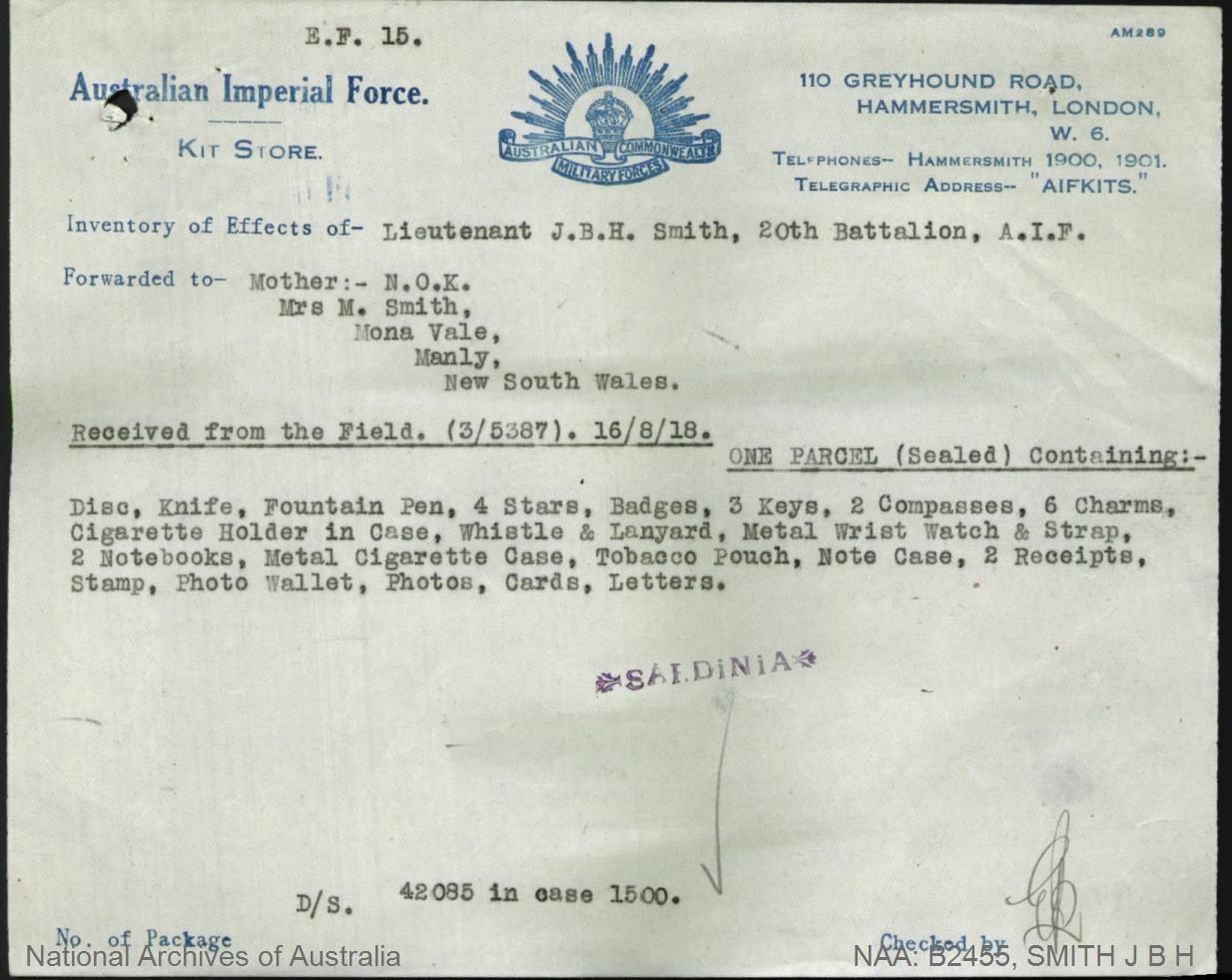
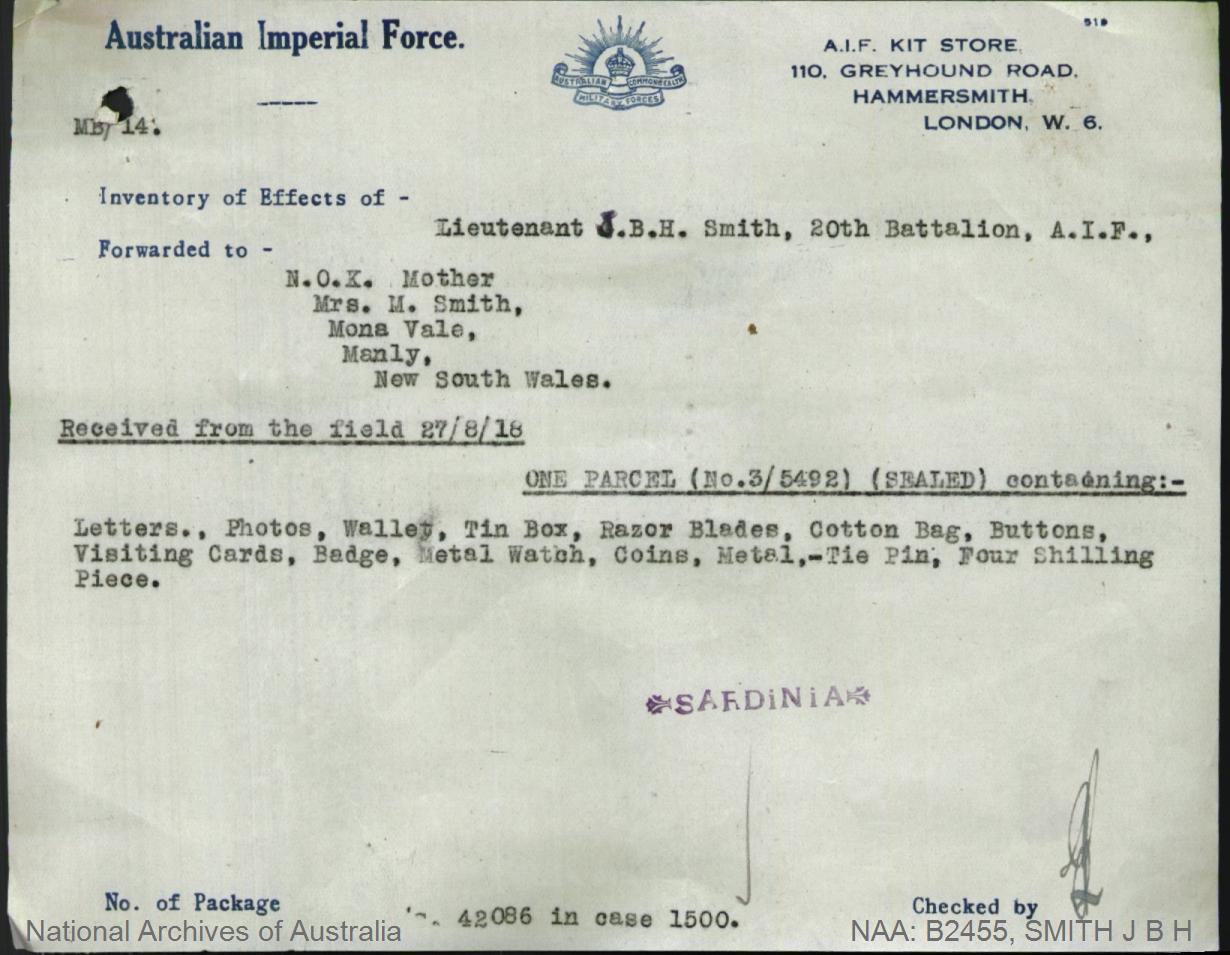
Mary applied for what her youngest son had left her in January 1919 - James' records tell the story:
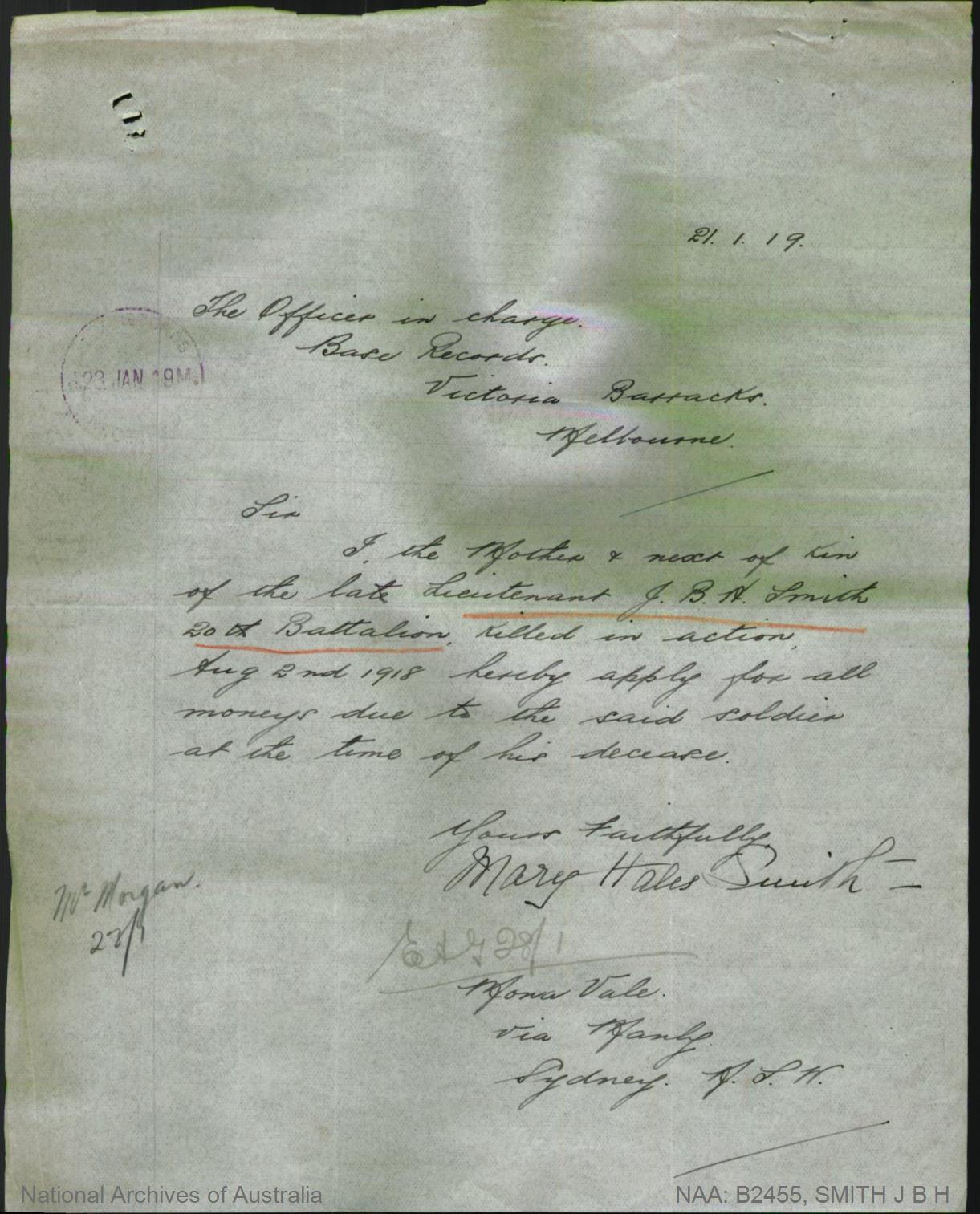
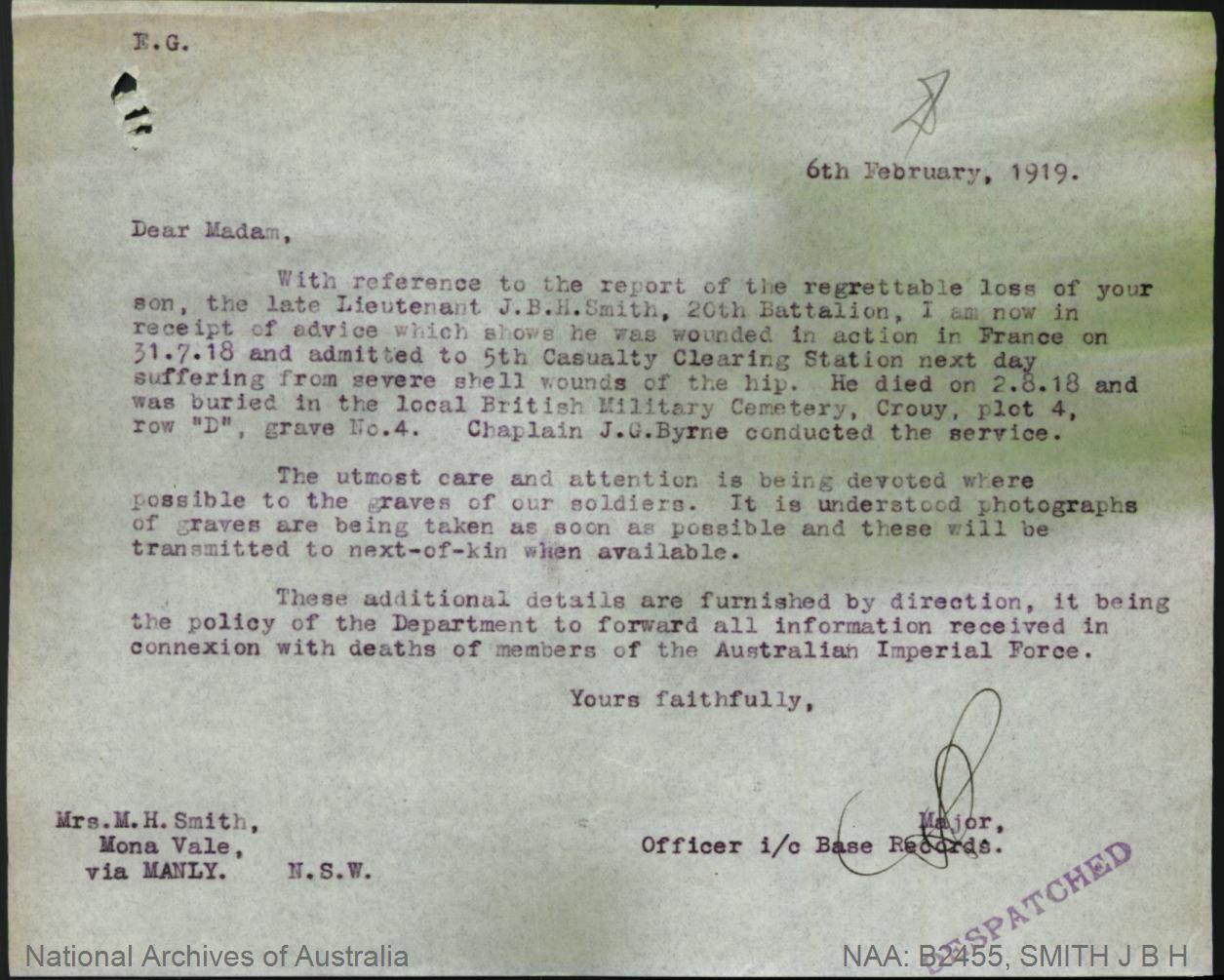
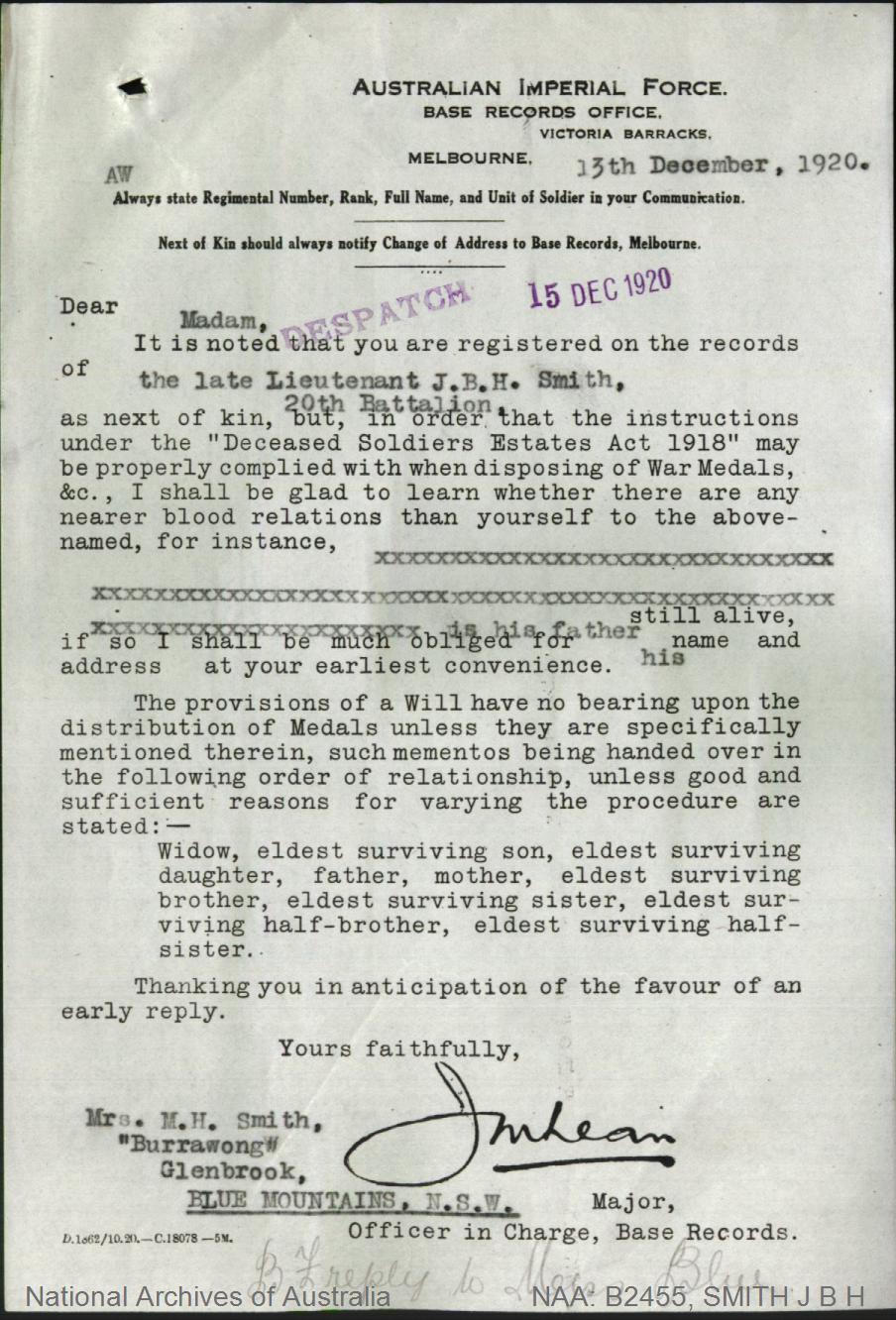
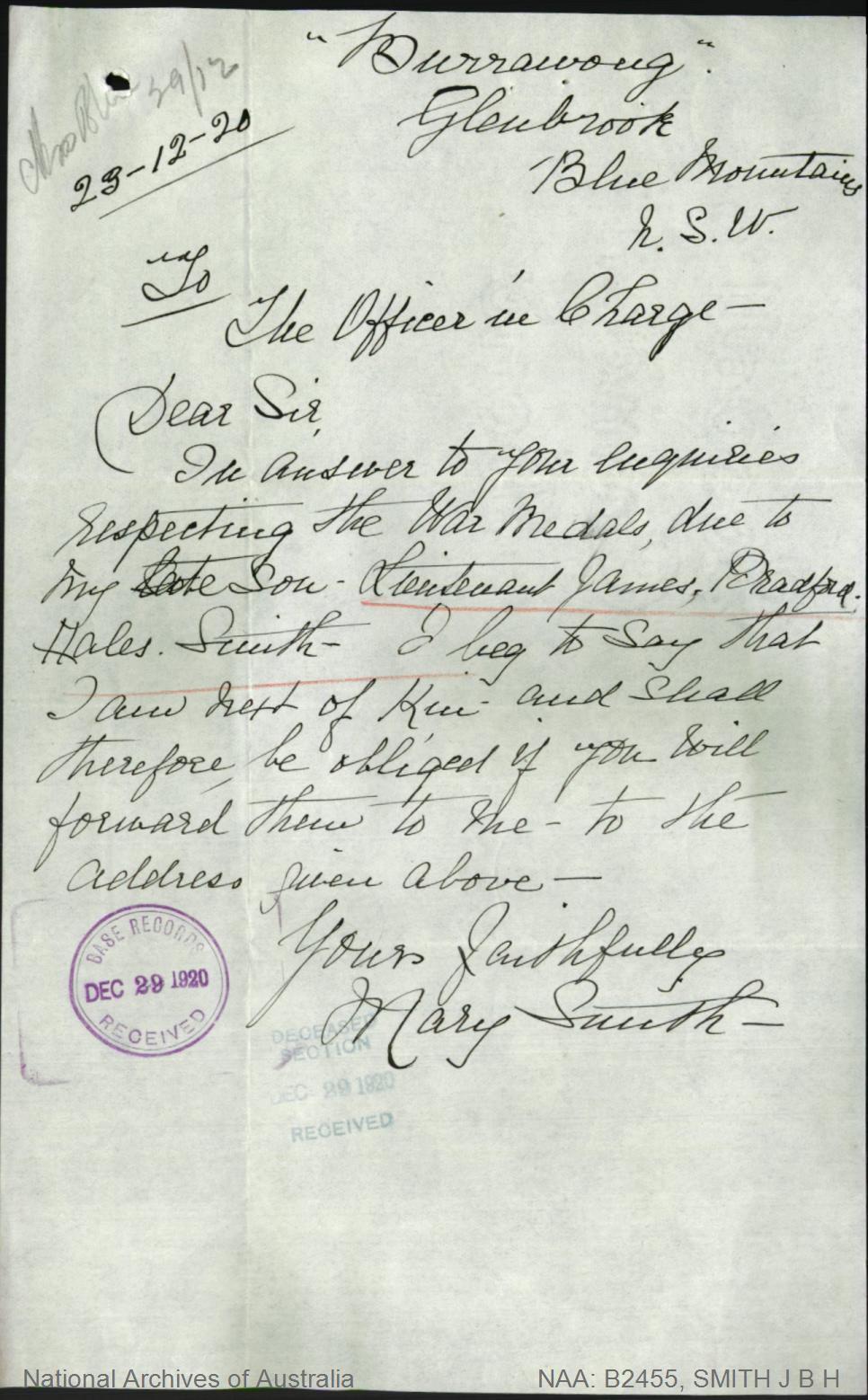
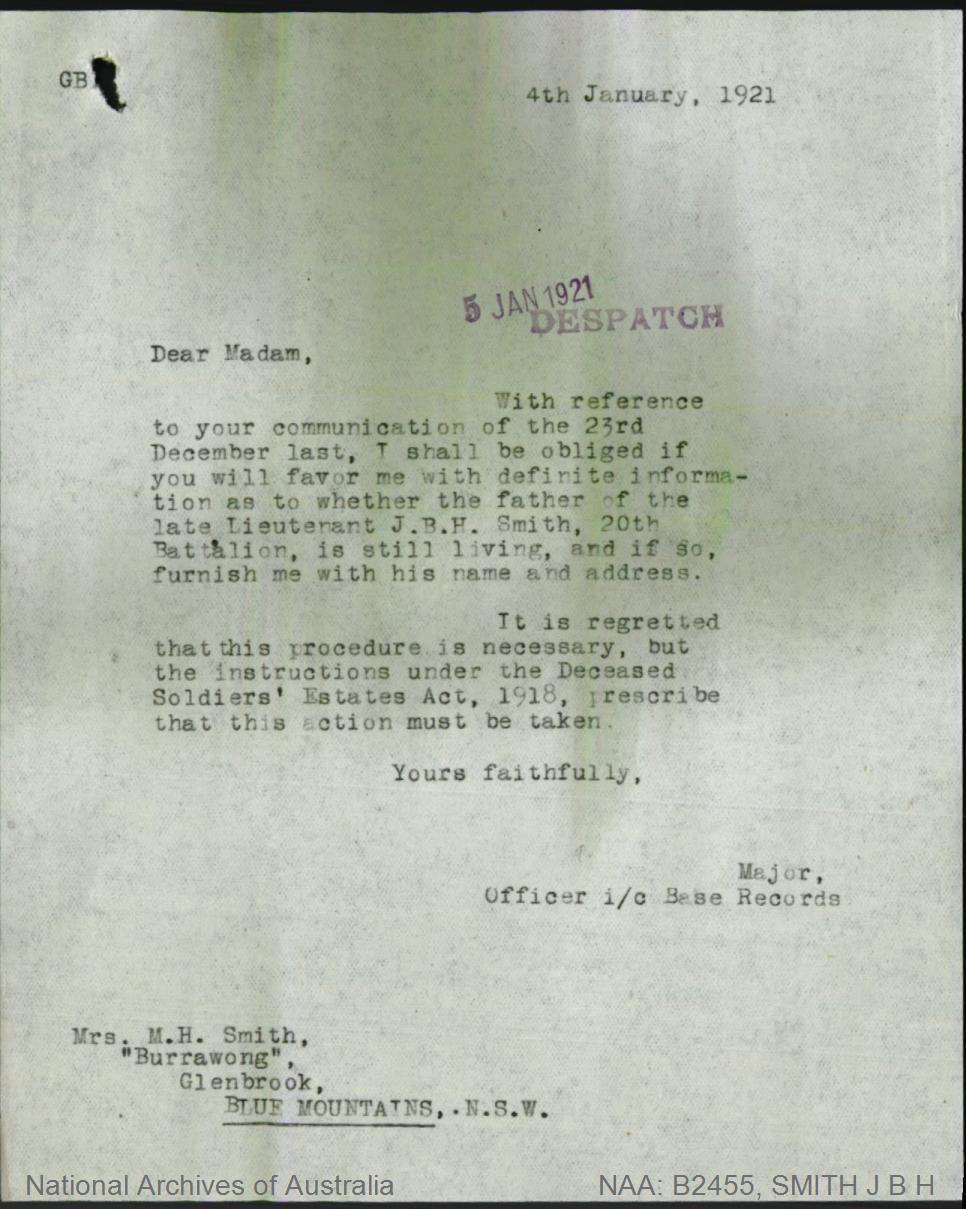
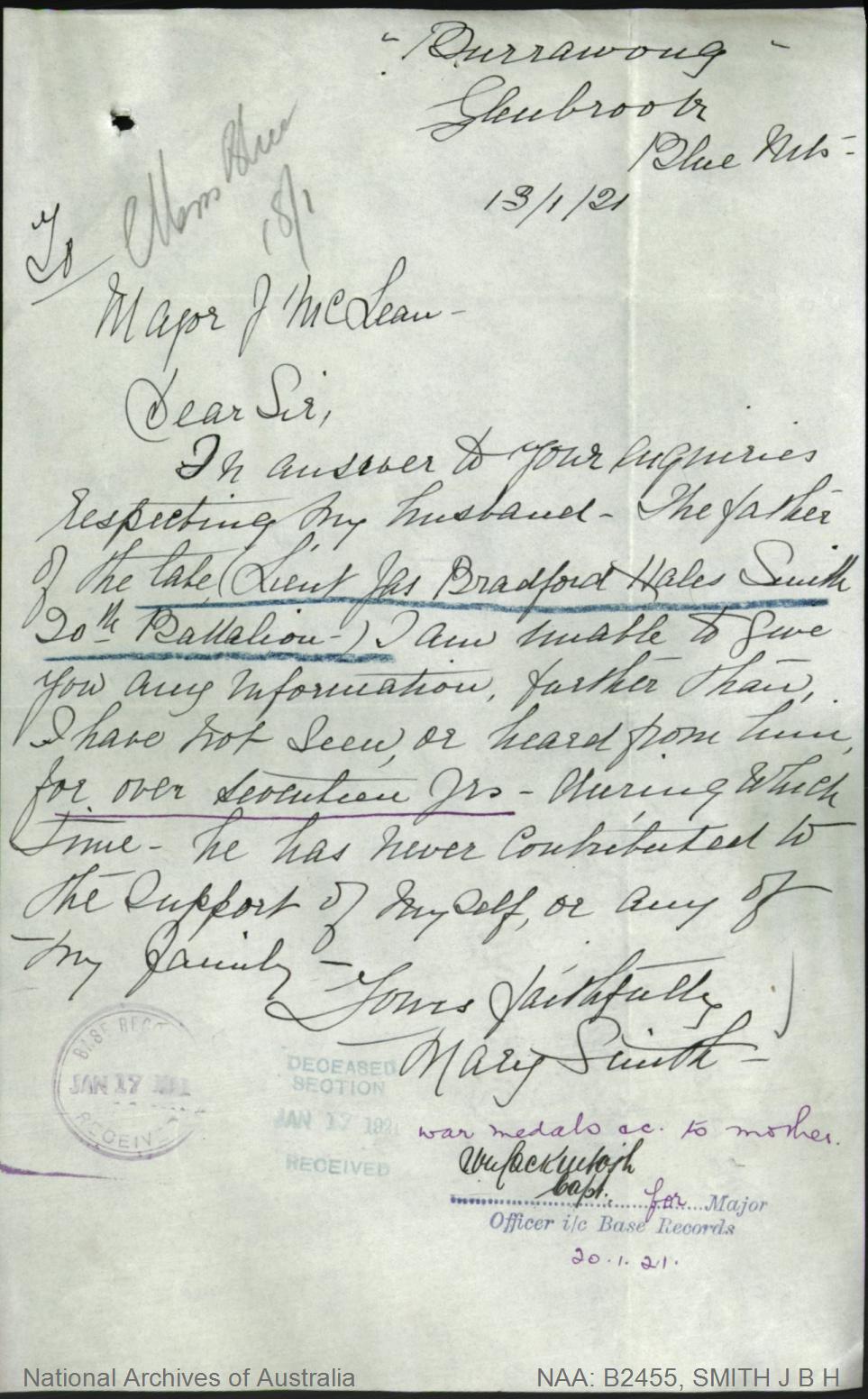
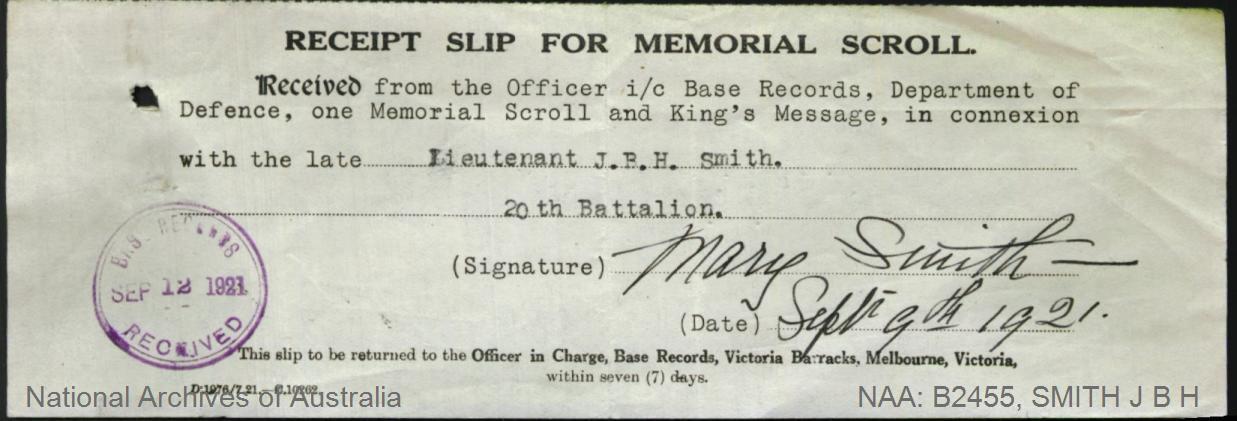
Mary may have been been anxious to move from where she was at that stage, 9 Park street, Marrickville. By December 1920 she was living where she would spend the rest of her life:
GLENBROOK, GLENBROOK, ON THE WESTERN LINE, BURRAWONG.
A Comfortable Well-built and Convenient Cottage, of weatherboards, on brick piers, lined instile, iron roof, good verandahs on three rides and rear, and contains wide hall, 5 rooms and kitchen, in basement is lounge. The whole would make two good self-contained Flats, having separate entrances.
THE LAND has a frontage to Leslie-street of 133ft, by a depth of 275ft.
RICHARDSON AND WRENCH, LTD. (in conjunction with RANDOLPH H. NOTT and
SON), will sell by Public Auction, at the Rooms, 92 Pitt-street, on FRIDAY, 13th February, at 11.30 a.m.
The above Cottage is furnished with ample well laid out grounds in flower, vegetable, and fruits, within easy distance from railway station, and in an elevated position._(5924). Advertising (1920, January 28). The Sydney Morning Herald (NSW : 1842 - 1954), p. 4. Retrieved from http://nla.gov.au/nla.news-article15868820
As an 80 year old she experienced another theft, although it is not specified what was taken:
Sheens and Abbott pleaded guilty to stealing paper bags valued at 5/-, from William Leslie Ellison, and also to stealing property valued at £5 from Mary Hales Smith. STEALING (1931, May 9). Nepean Times (Penrith, NSW : 1882 - 1962), p. 1. Retrieved, from http://nla.gov.au/nla.news-article100940925
Mary passed away during the Second World war:
MRS. MARY SMITH.
Mrs. Mary Smith, of "Bunawong," Leslie Street, Glenbrook, died on 17th inst. in her 90th year. The interment took place In the C. of E. portion of Penrith general cemetery on 18th inst„ Rev. R. S. Chapple officiating. MRS. MARY SMITH. (1942, April 23). Nepean Times (Penrith, NSW : 1882 - 1962), p. 5. Retrieved from http://nla.gov.au/nla.news-article117889491
Mary's departure from Mona Vale coincides with the placing on the market of the Winji-Jimmi Estate. Whether the family actually lived in a home near there could not be determined. However, the public spirited and Councillors with a heart in Warringah Shire Council Records provide:
Heydon & Heydon, 14/12/18, further re Winji- Jimmi. Dealt with in Works Committee
CORRESPONDENCE WAS READ, and dealt with as follows ; 1. Heydon and Heydon, 3/1/ 19, forwarding cheque for £190, for Winji- Jimmi Subdivision road construction : Resolved, That the writers be Informed that the Council is prepared to carry out the work in accordance with the letter so far as the money will go, but that it will probably not be able to start the work before the 26th inst., and that it will not object to the selling of the allotments before the subdivision road is constructed, It was decided to suggest that the new street be called Hale-Smith Street.
J. K. Heydon, 24/4/19,, (1) re construction of roads in Winji- Jimmi Estate, (2) further re removal of gravel from his land - That he be informed that the construction of the Winji-Jimmi Estate Roads will be carried out very shortly
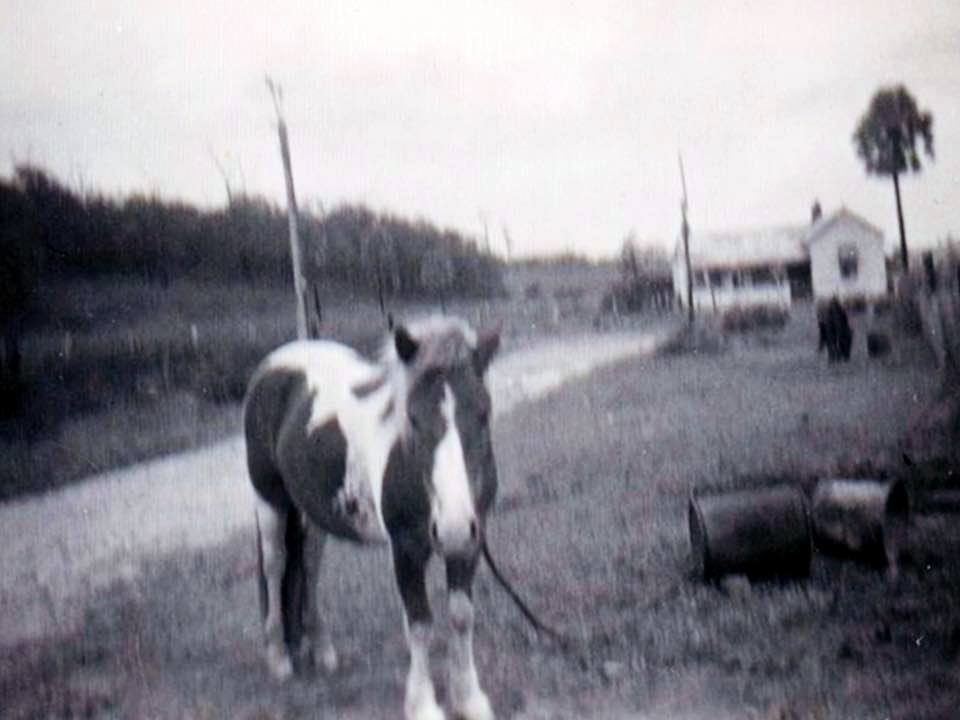
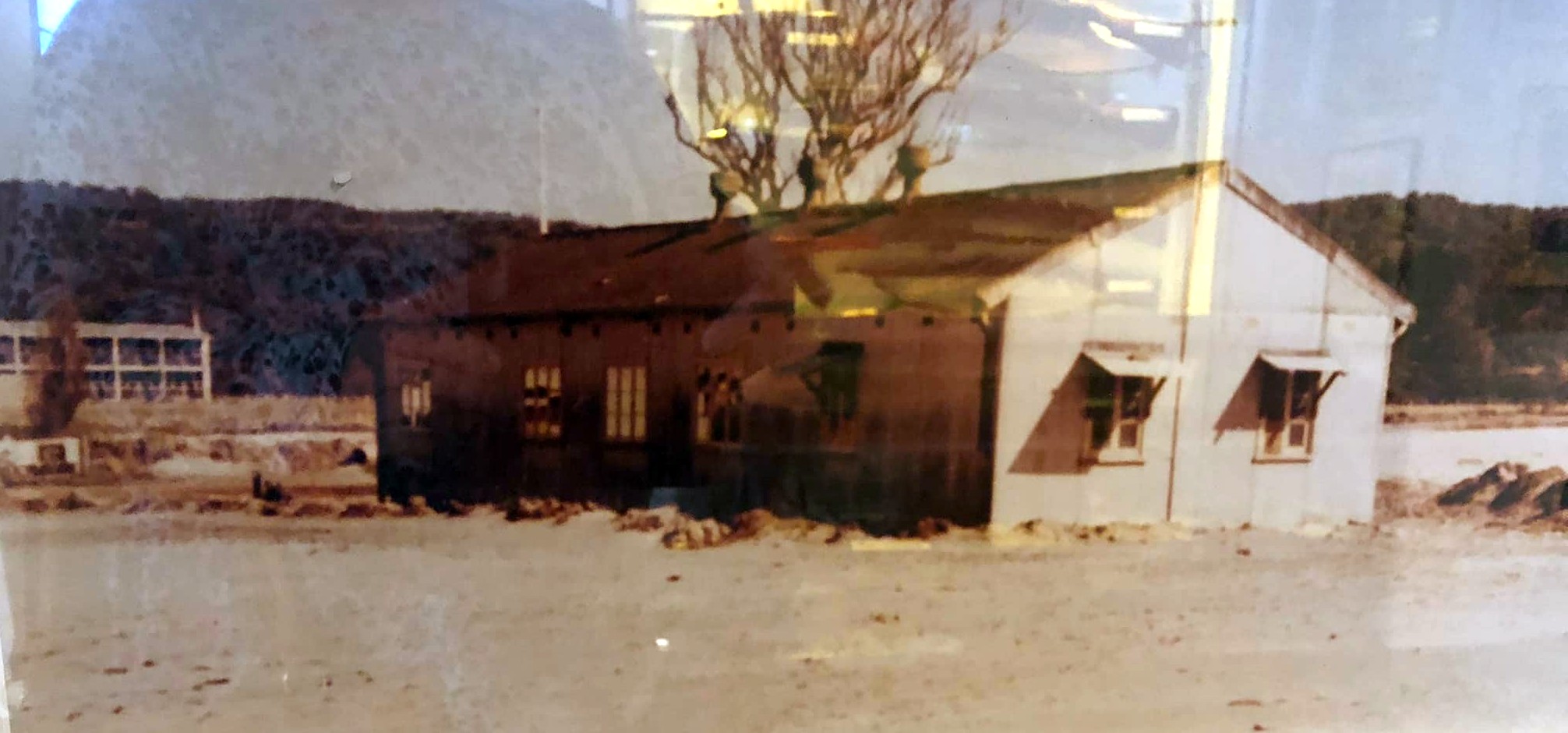
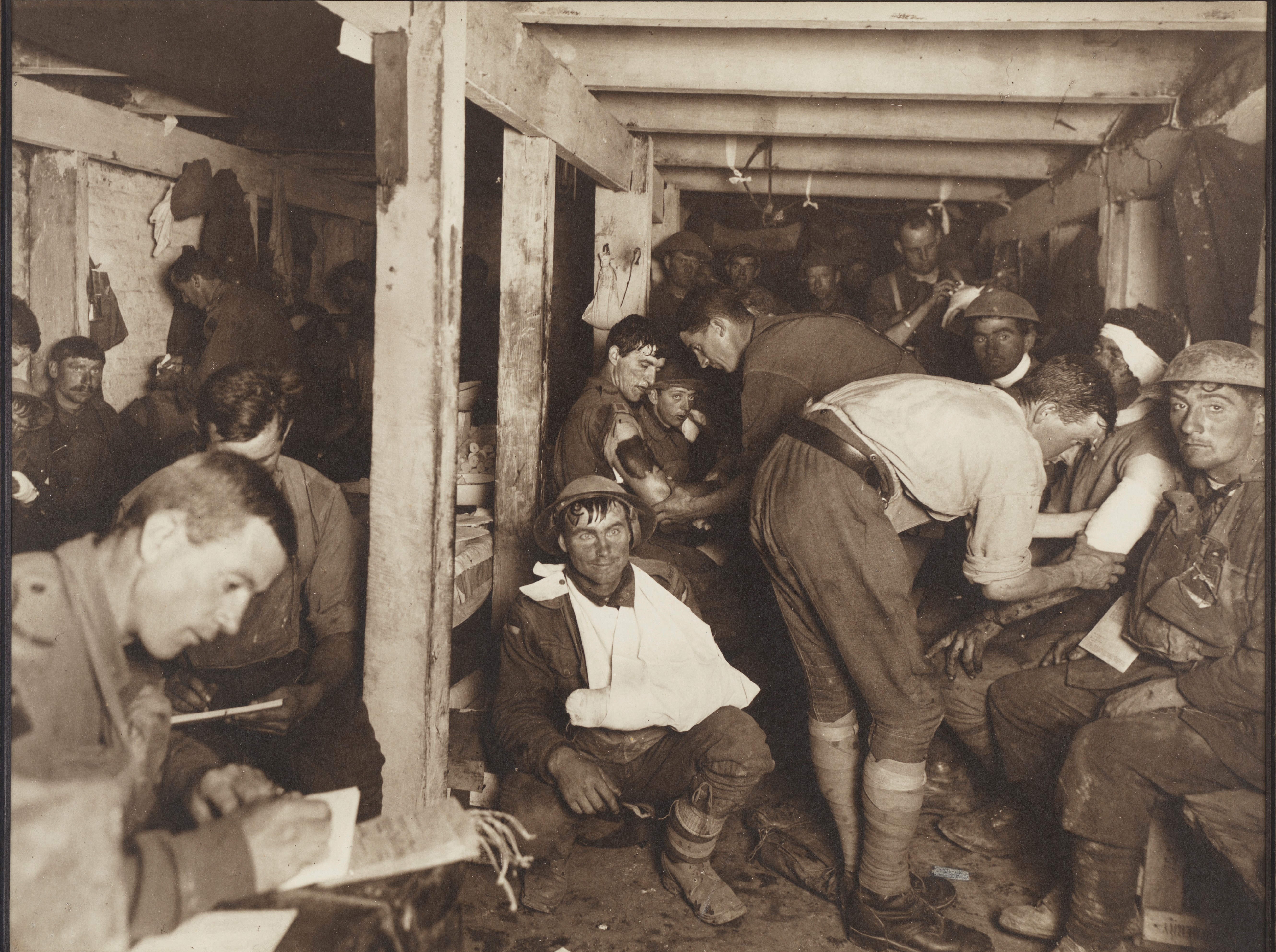
John Charles Holding
John Charles Holdings’ name is listed on the Mona Vale Village Park cenotaph. He is also commemorated by name at panel 91 in the Commemorative Area at the Australian War Memorial, and the Menin Gate Memorial, Ypres, Flanders, Belgium.
He had lost his father just months prior to enlisting - John William Holding had been a Mona Vale stalwart who would go to the rescue of others:
John William Holding, Ernest William Oliver, and Charles Henry Wilcox.— On July 29th, 1908, a message was sent to the Mona Vale Police Station that a boat with two men in it was in a helpless condition off Little Reef, near Barranjoey, N.S.W. Mr. Holding, on hearing of the occurrence, with great promptitude put off In a small boat to the rescue, accompanied by Messrs. Oliver and Wilcox, although the constable on duty endeavoured to dissuade him from doing so on account of the heavy sea running. The three, men, however, pulled through the breakers, but on reaching the scene found the object was only old wharfage with two posts standing at the ends, and with great difficulty succeeded in getting the boat back across the bar.
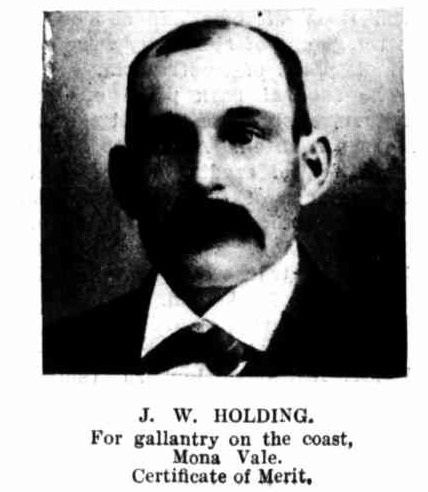
HEROES OF THE YEAR. (1909, August 18). The Sydney Mail and New South Wales Advertiser (NSW : 1871 - 1912), p. 27. Retrieved from http://nla.gov.au/nla.news-article164338996
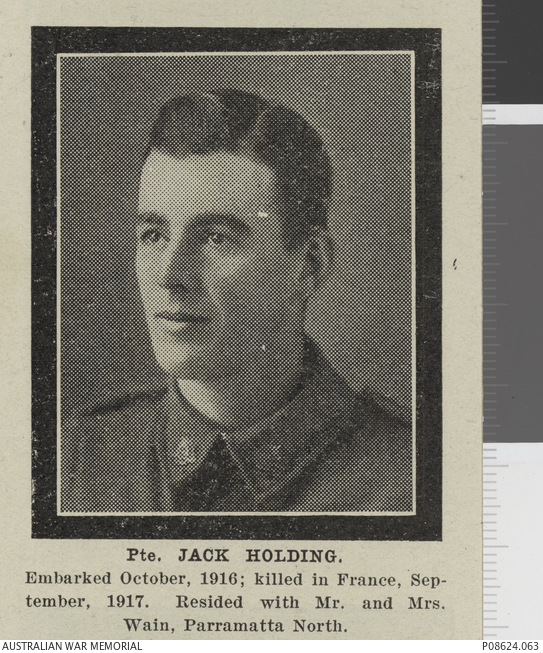
.jpg?timestamp=1636250820415)
.jpg?timestamp=1636250890833)
.jpg?timestamp=1636250436191)
.jpg?timestamp=1636250490462)
.jpg?timestamp=1636250556853)
.jpg?timestamp=1636250584817)
.jpg?timestamp=1636250755360)
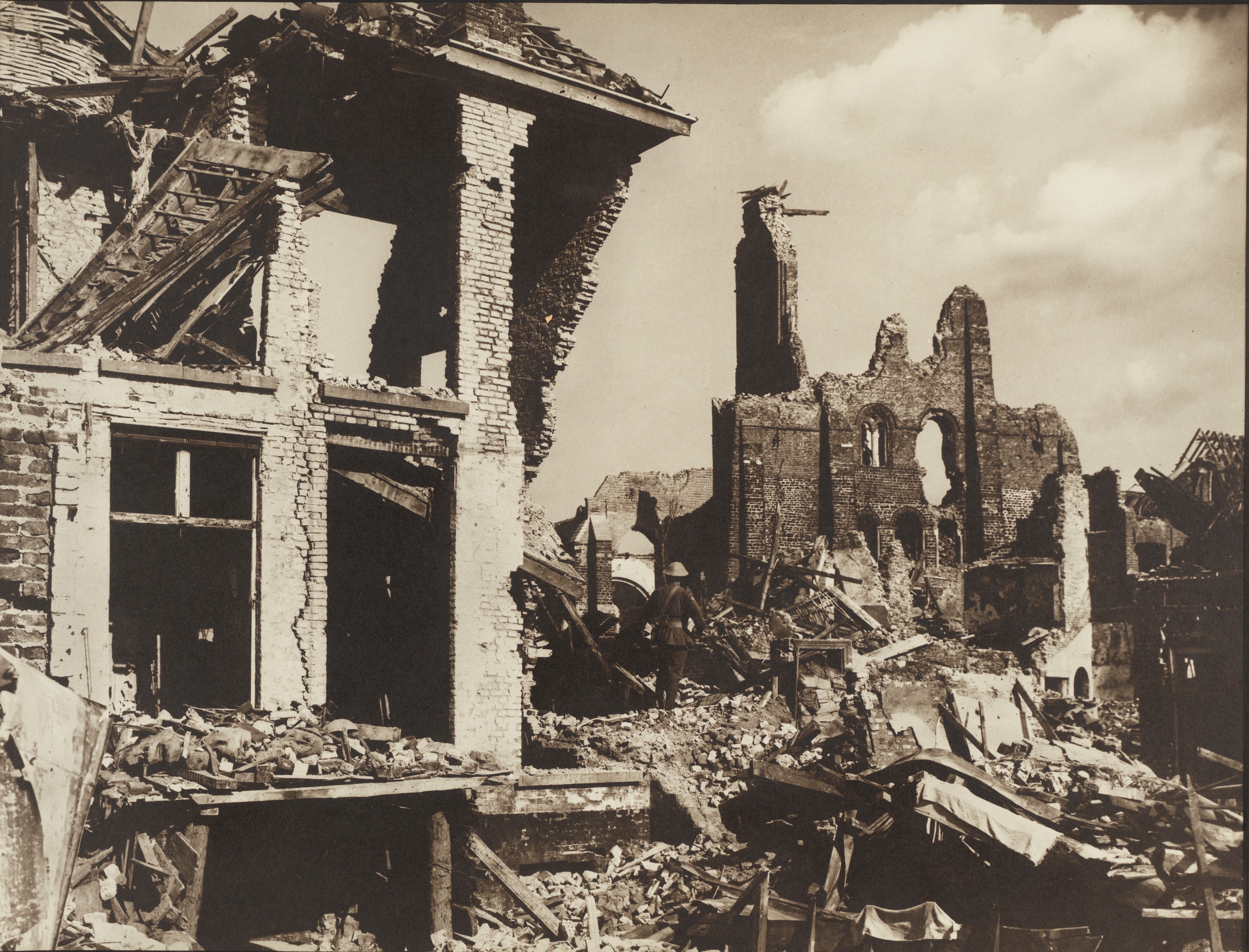
Other Mona Vale devotees lost:
.jpg?timestamp=1636221790005)
PRIVATE W. S. JOHNS, who fought at Lonesome Pine and also in West Egypt, and has now been wounded In France. He was captain of the first Mona Vale Life-Saving Club, and also a member of the Manly Cycling Club.
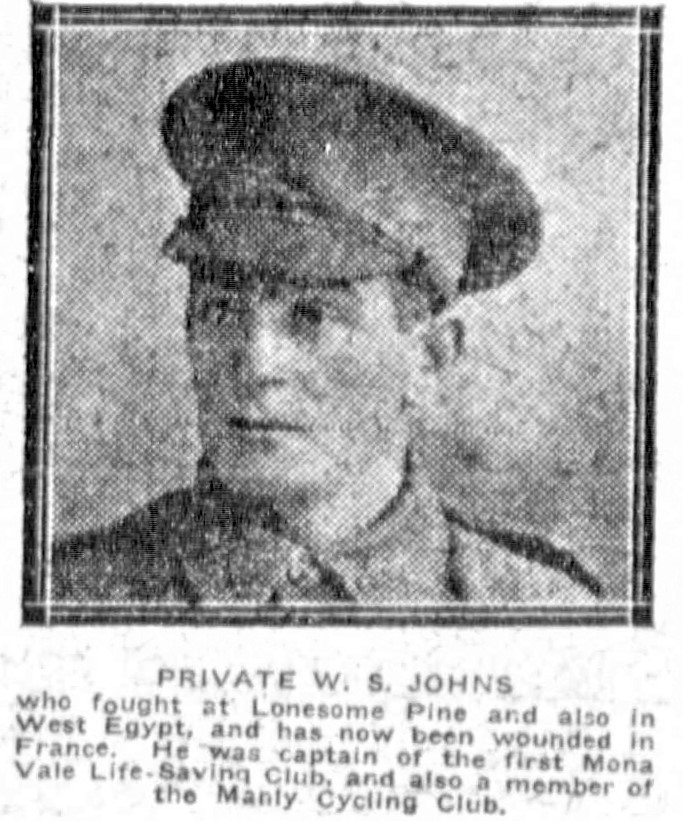
The arrival of hospital ships with Australian wounded Is becoming almost a regular weekly event. Our. picture shows last Saturday's batch of returned men leaving the transport at Sydney. — (Special 'Mirror' photo.)
GUNNER SMITH AND HIS TWO SOLDIER BROTHERS.
.jpg?timestamp=1636221859073)
Here are photographs of Gunner Smith (In centre), the Imperial soldier who has received such scurvy treatment at the hands of the- N.S.W. Government, and his two brothers, both of whom are serving at the front. Particulars of an entertainment that Is being arranged on behalf of Gunner Smith will be found on another page. "THE MIRROR'S" WEEKLY GALLERY OF INTERESTING' AUSTRALIAN WAR-TIME PICTURES. (1916, August 19). The Mirror of Australia (Sydney, NSW : 1915 - 1917), p. 16. Retrieved from http://nla.gov.au/nla.news-article105137481
CEREMONY AT MONA VALE.
The Warringah Shire Council is intent on encouraging surf-bathing. Great improvements have been made on the various beaches during the past two years. On Saturday afternoon, in the presence of a large number of people, including several prominent surf-bathing representatives, the president of the Warringah Shire Council (Mr. E. W. Quirk) performed the ceremony of opening the new club-house erected for the life-savers and surfers at Mona Vale. The council also have a number of lifeboats in course of construction. The first of these was launched at Mona Vale during the afternoon. When the remainder are completed they will he placed at Narrabeen, Curl Curl, Freshwater, and other prominent beaches in the shire. Mr. A. Lord (president of the Surf-bathing Commission) and Mr. J. J. K. Taylor (instructor to the district life-saving clubs) referred to the good work the life-saving clubs were doing on the beaches. CEREMONY AT MONA VALE. (1915, February 1). The Sydney Morning Herald (NSW : 1842 - 1954), p. 12. Retrieved from http://nla.gov.au/nla.news-article15554799
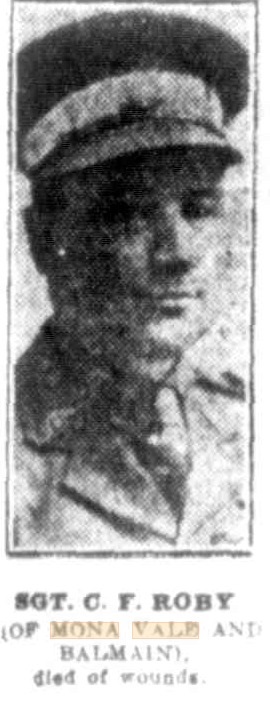
SGT. C. F. ROBY (OF MONA VALE AND BALMAIN), died of wounds. N.S.W. HONOR ROLL. (1918, October 7). Evening News (Sydney, NSW : 1869 - 1931), p. 4. Retrieved, from http://nla.gov.au/nla.news-article114271969
Charles Frederick Roby, Service Number - 545, was born at Lithgow NSW and Enlisted at Liverpool NSW. He had a wife, Ella.
ROBY.— Died- of wounds in France; September 4, 1918, Sergeant Charles Frederick Roby, M.M., 84th (late 30th): Battalion; late of Lithgow, aged- 39. Family Notices (1918, September 20). Lithgow Mercury (NSW : 1898 - 1954), p. 5. Retrieved from http://nla.gov.au/nla.news-article218469040
He was wounded within days of arriving on the field and then again a few weeks later, with gunshots to the arm, wrist and head - fatally this time.
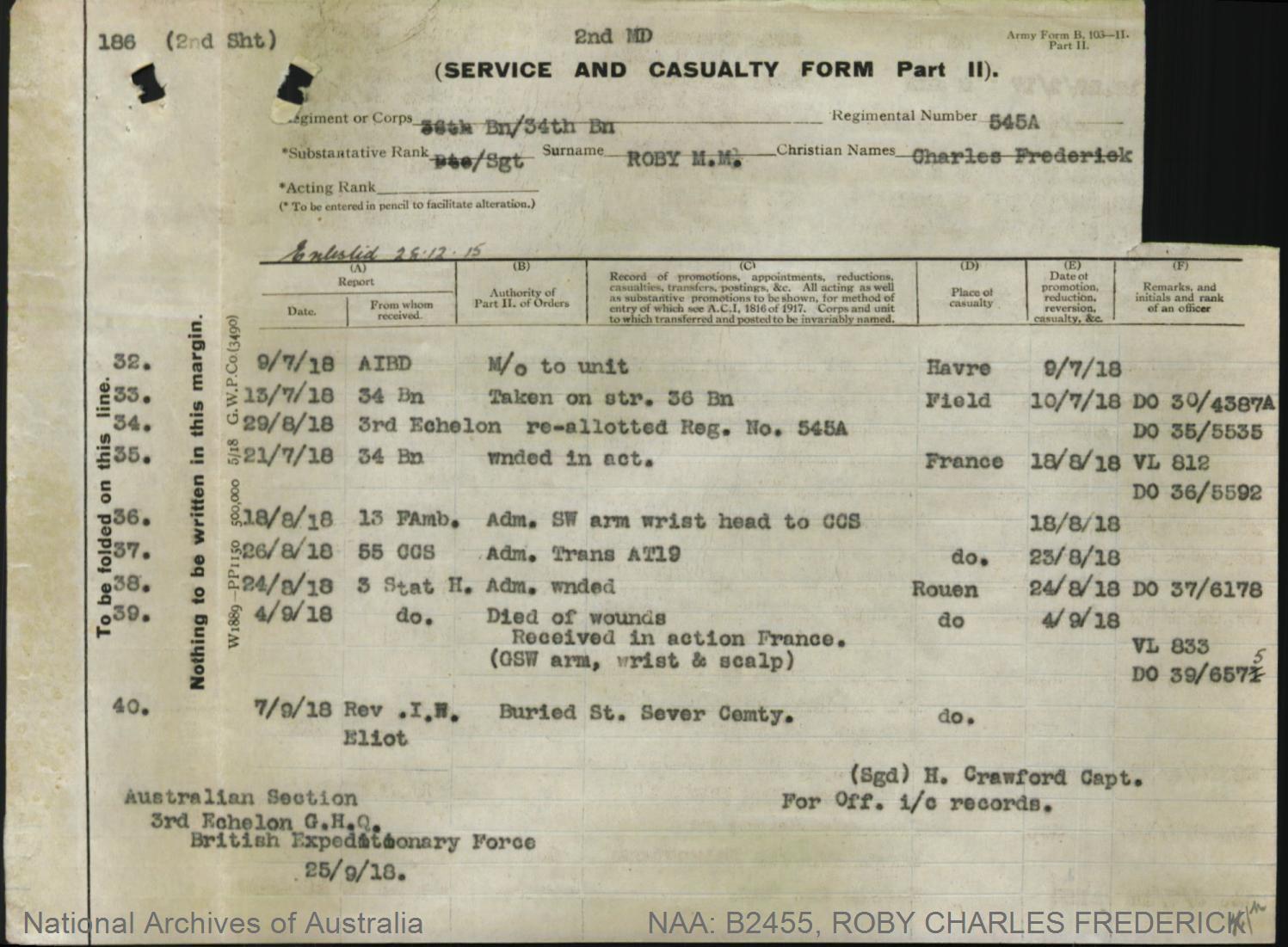
Brentnall Family
George Vivian Brentnall enlisted on October 25th, 1915, his occupation being Saddler. He had ben born in Myrtleford Victoria, and enlisted at Dubbo NSW, his next of kin was his mother Emily Ann Brentnall, of Mona Vale. His father had passed away decades prior to this, leaving his mother to do the best she could by her children:
BRENTNALL.-March 13, at his residence, Glebe-road, William Brentnall, C.E., in his 51st year. Family Notices (1889, March 15). The Sydney Morning Herald (NSW : 1842 - 1954), p. 1. Retrieved from http://nla.gov.au/nla.news-article13717555
Their son of the same name was placed in Randwick Asylum for Destitute Children and not discharged until October 2nd 1889.On November 4th, 1896, Emily Ann, occupation Milliner, was made a bankrupt.
[Notice under Section 11 of the Bankruptcy Act, 1887.]
In the Supreme Court of New South Wales. (11,438)
IN BANKRUPTCY.
Re Emily Anne Brentnall, of 49, Mount Yernon-street, Forest Lodge, milliner.
NOTICE is hereby given that a Sequestration Order has this day been made against the abovenamed bankrupt, on her own petition.—Dated at Sydney, this 4th day of November, a.d. 1896. ARTHUR HENRY, Registrar in Bankruptcy. IN BANKRUPTCY. (1896, November 13). New South Wales Government Gazette (Sydney, NSW : 1832 - 1900), p. 8146. Retrieved from http://nla.gov.au/nla.news-article222829205
Emily also lost all her children bar her two remaining and serving in the AIF sons:
BRENTNALL.—September 17, at Kogarah, Adelaide A. Buly, daughter of the late William Shardlow, Brentnall, surveyor, N.Z., in her 30th year. Family Notices (1909, September 18). The Sydney Morning Herald (NSW : 1842 - 1954), p. 12. Retrieved from http://nla.gov.au/nla.news-article15113051
BRENTNALL.—December 31, at Brewarrina William Shardlow (Shard), second son of late William S. Brentnall, surveyor, N. Zealand, aged 29 years. Family Notices (1911, January 3). The Sydney Morning Herald (NSW : 1842 - 1954), p. 6. Retrieved from http://nla.gov.au/nla.news-article15225159
Killed in Action. Sergt. BRENTNALL, G. V. (Mona Vale), 21/5/18, gas. N.S.W. Casualties. (1918, June 19). Australian Town and Country Journal (Sydney, NSW : 1870 - 1919), p. 16. Retrieved from http://nla.gov.au/nla.news-article263622473
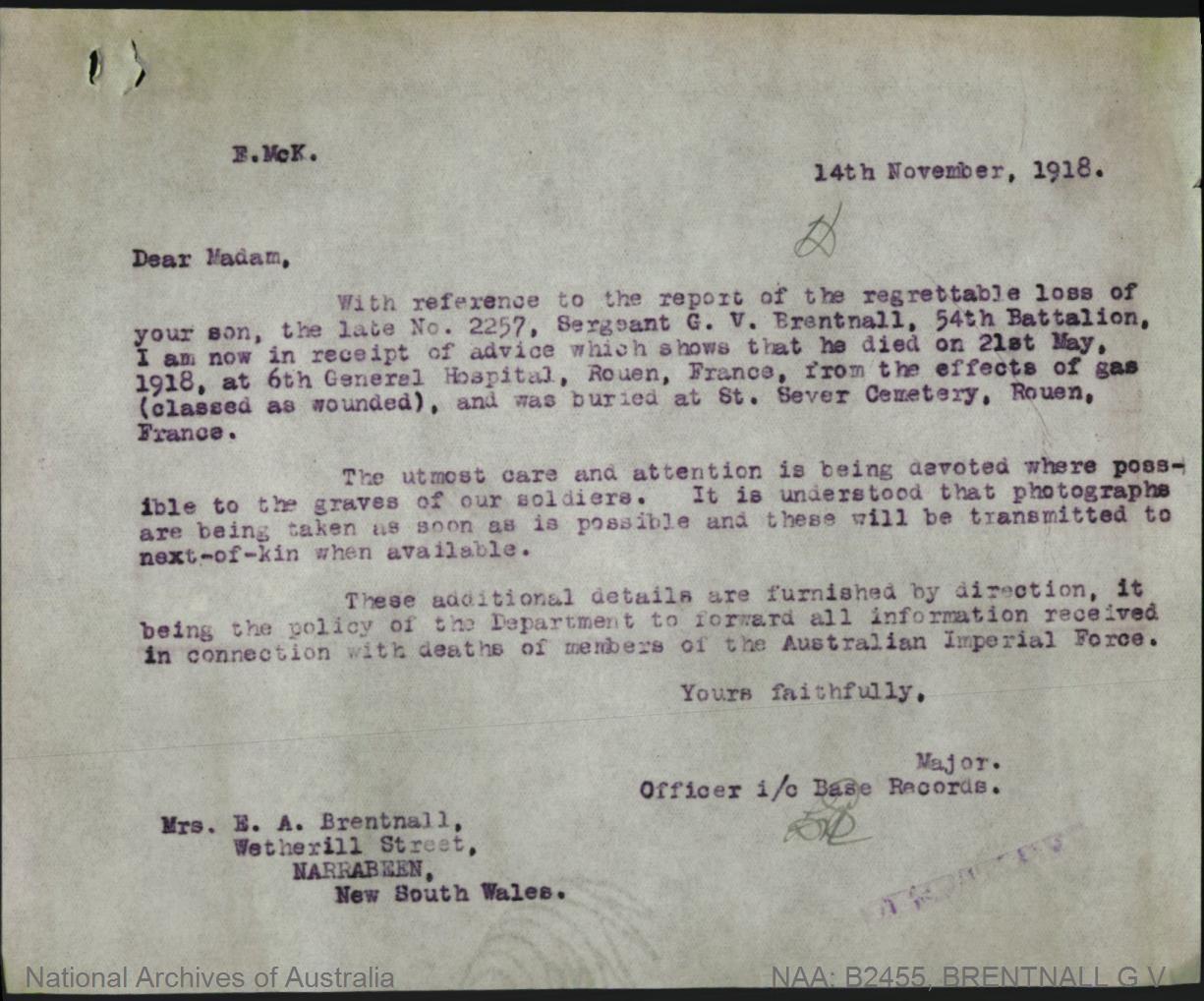
Listed among the returned effects are photos, again:
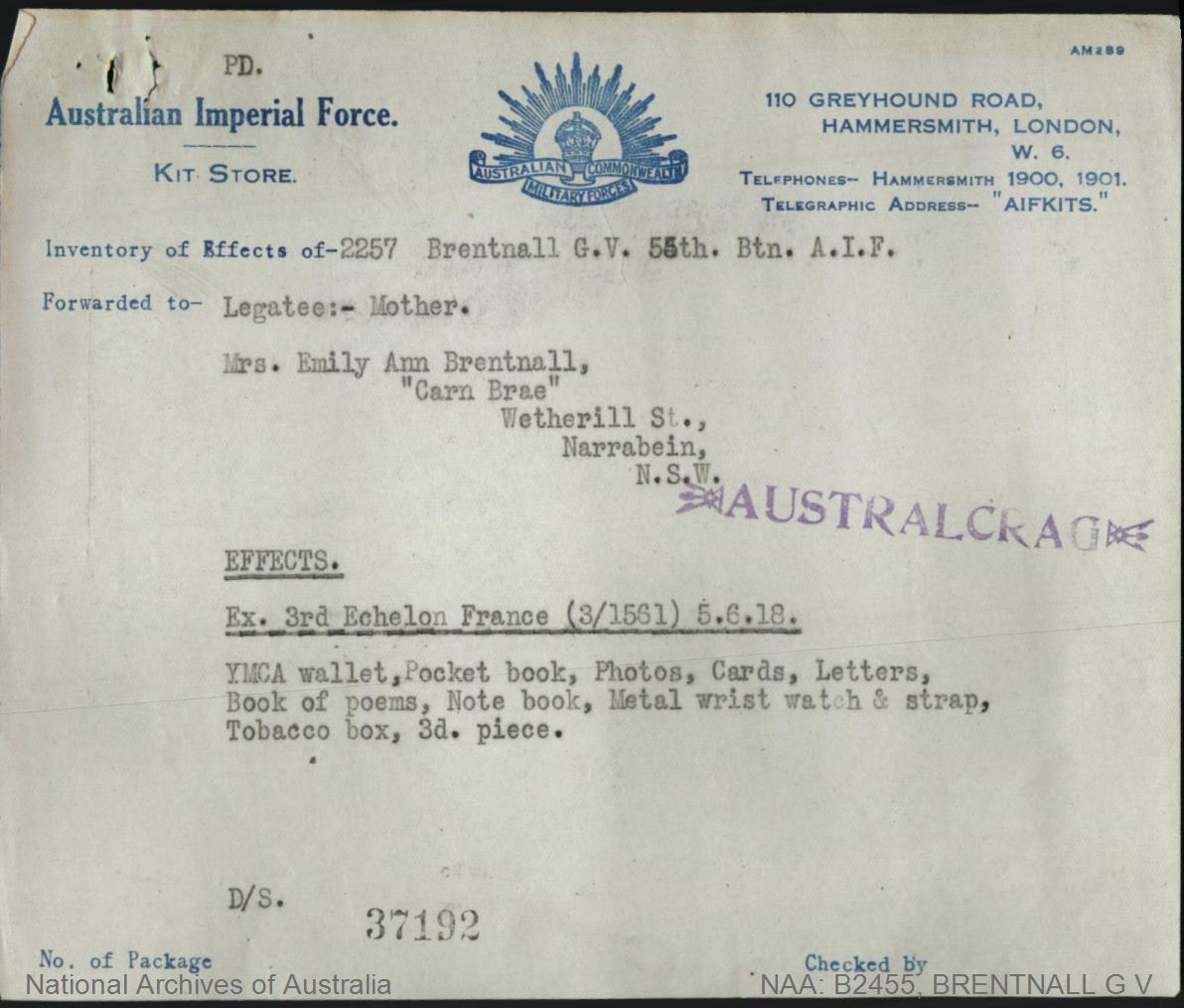
Her son Charles Frederick Brentnall, SERN 457, was born Hokitika New Zealand : POE Townsville QLD – occupation was forwarding clerk and was almost aged 40 when enlisted. He bequeathed all his property to Frederick Satini, Assistant Mercantile Manager, North Queensland, described throughout his records as his ‘Friend’. His enlistment papers listed him, on first form, as his next of kin – of Victoria Bridge Hotel, South Townsville. His mother received a pension of £2 however, from 1918, along with the same for her son George.
Charles served with the 23rd Australian Machine Gun Company. He died October 5th 1917 – field station, Belgium.
His Friend was a yachtsman according to this post WWI report:
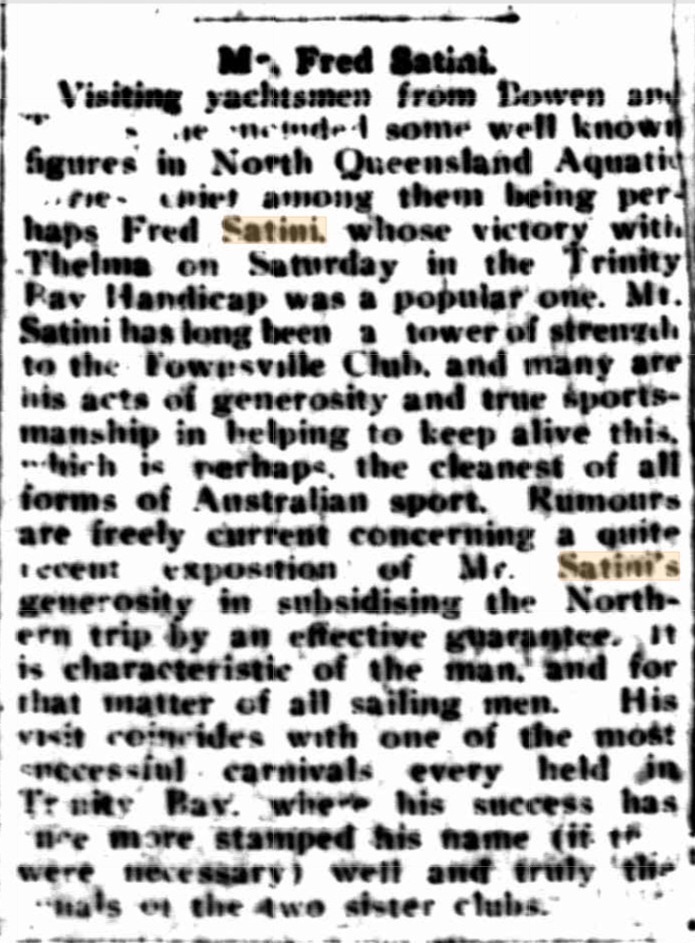
Mr. Fred Satini. (1923, April 2). Cairns Post (Qld. : 1909 - 1954), p. 4. Retrieved from http://nla.gov.au/nla.news-article40177460
DEATH OF FRED SATINI
TOWNSVILLE, Thursday— The death occurred suddenly to-day of Fred Satini, 66, well known North Queensland sailing enthusiast. He was connected with Samuel Allen and Sons, Ltd., and from office boy rose to assistant manager. He became a director in 1933, and retired in 1937. On Wednesday night he was re-elected commodore for the Townsville Flying Squadron for the 27th year. DEATH OF FRED SATINI (1943, July 16). The Courier-Mail (Brisbane, Qld. : 1933 - 1954), p. 5. Retrieved from http://nla.gov.au/nla.news-article42031759
BRENTNALL.-Died of wounds in France, October 5, 1917, Charles Frederick, eldest son of late W. S. Brentnall (New Zealand), and of Mrs. E. A, Brentnall (Narrabeen), and brother of late Addie, Shard, and Viv. Family Notices (1918, October 5). The Sydney Morning Herald (NSW : 1842 - 1954), p. 11. Retrieved from http://nla.gov.au/nla.news-article15805293
BRENTNALL.--Died of wounds and gas in France, May 21, Sgt, George Vivian (Viv), son of the late William Shardlow and Mrs. E. A. Brentnall, of Narrabeen, and brother of late Shard and Addie: also Charlie (died of wounds in France, Oct. 6, 1917). Family Notices (1918, June 8). The Sydney Morning Herald (NSW : 1842 - 1954), p. 12. Retrieved from http://nla.gov.au/nla.news-article15783714
Frederick Satini received the remaining effects of Charles - he had apparently 'left home' years before:
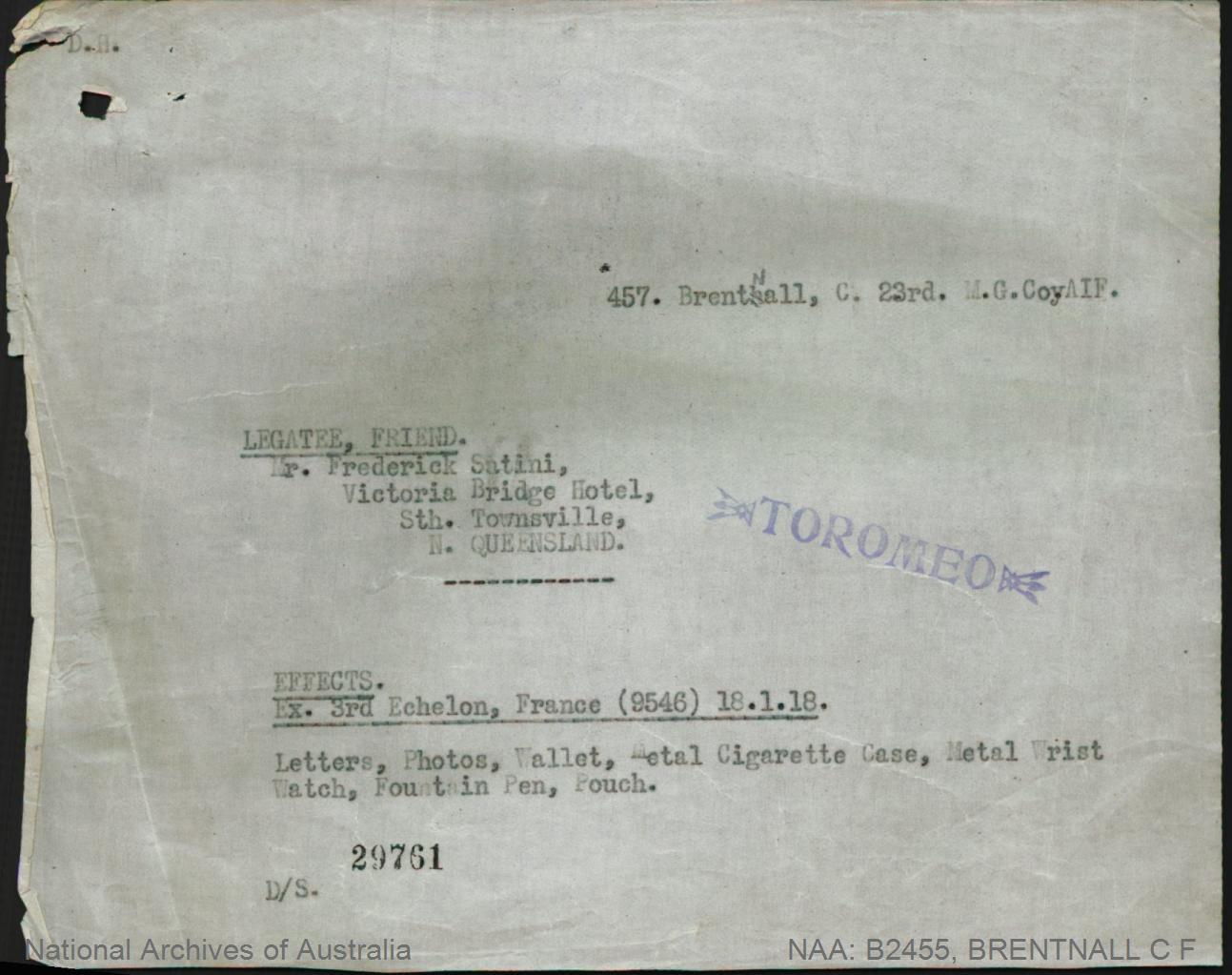
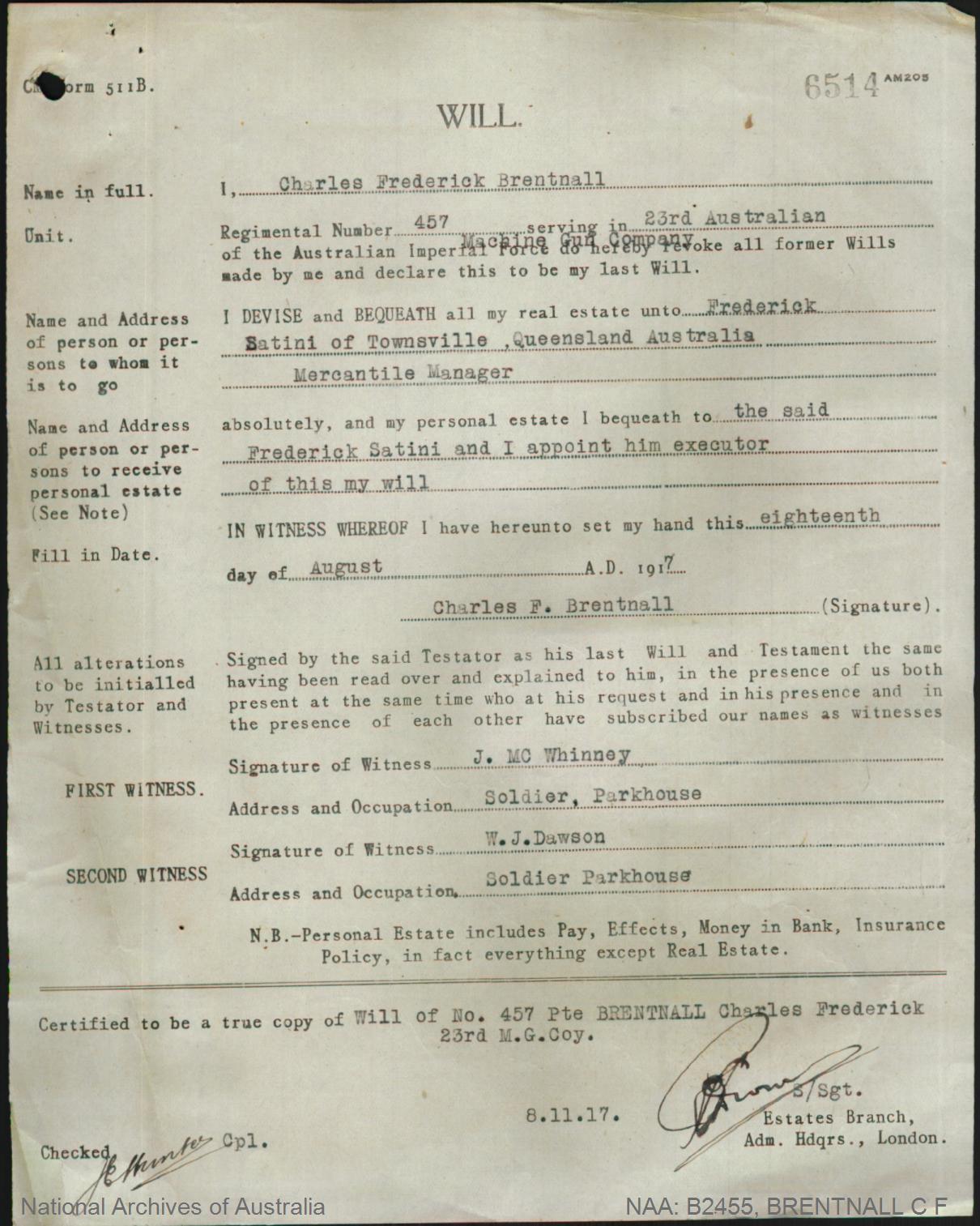
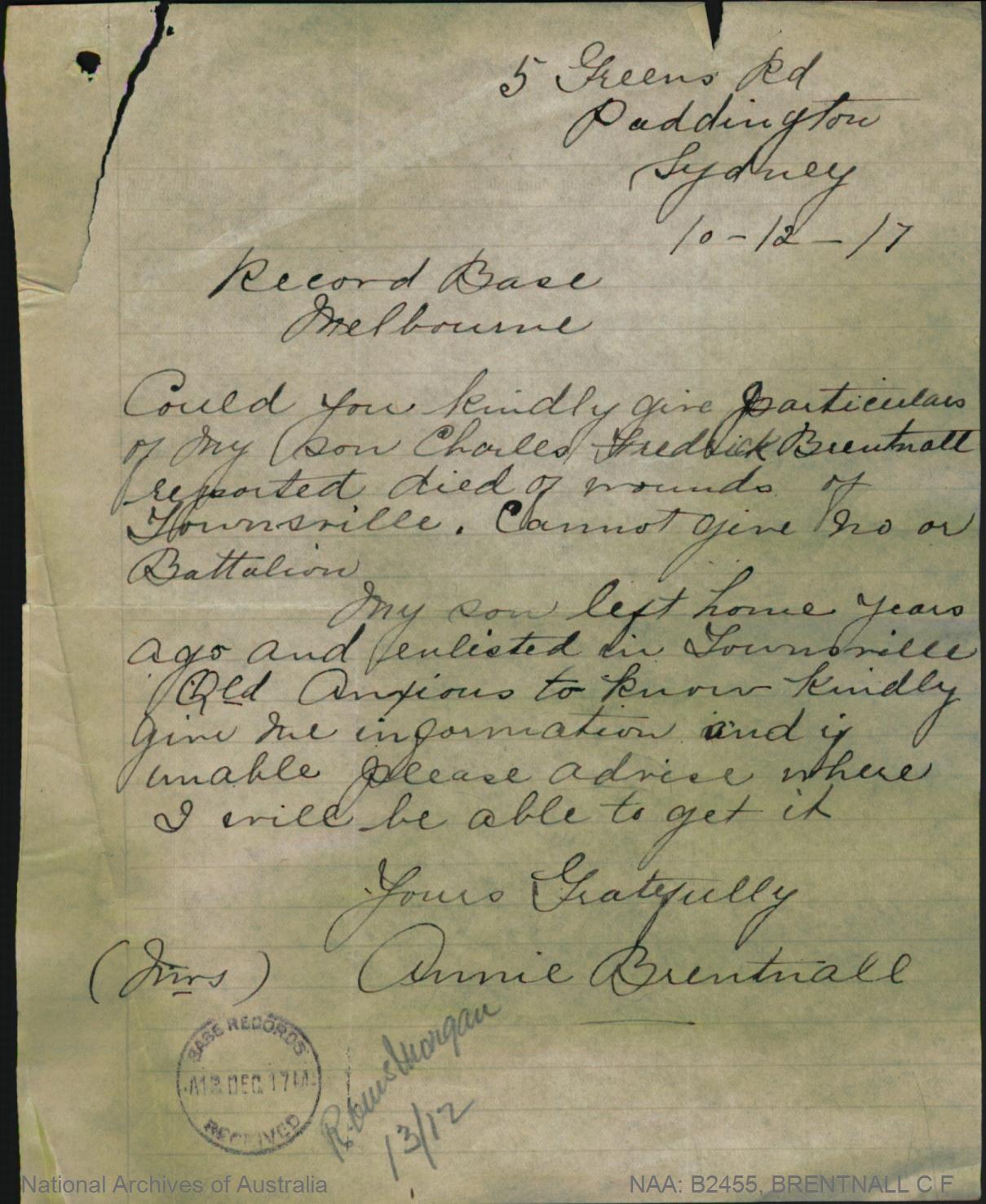
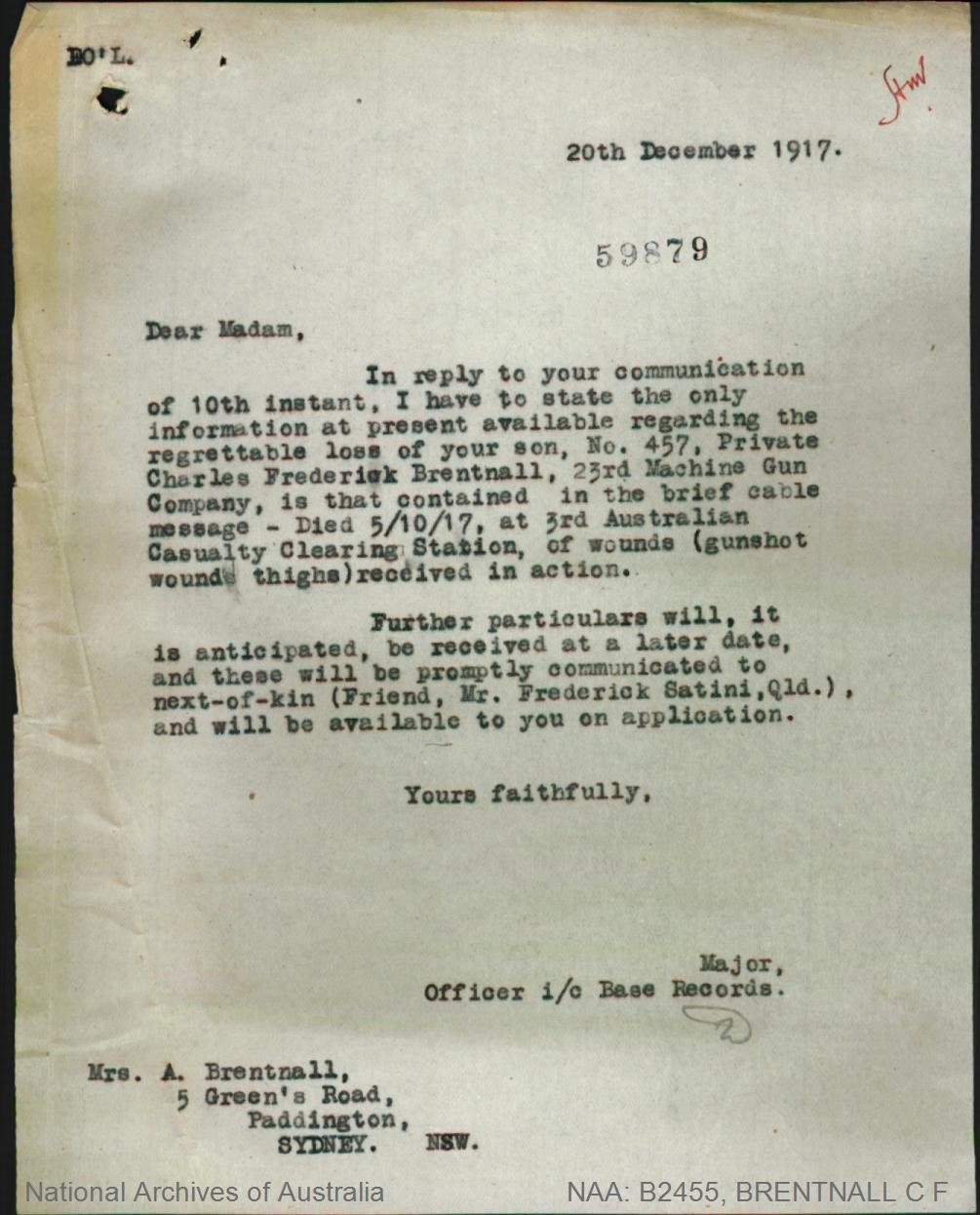
Emily passed away during the Second World War too:
BRENTNALL.-July 27, 1941, at Warriewood, Emily Ann Brentnall, widow of the late William Shardlow Brentnall, of New Zealand, aged 92 years. By request no flowers. Family Notices (1941, July 28). The Sydney Morning Herald (NSW : 1842 - 1954), p. 10. Retrieved from http://nla.gov.au/nla.news-article17758724
At the other end of the peninsula a Manly born son Charles George Brentnall
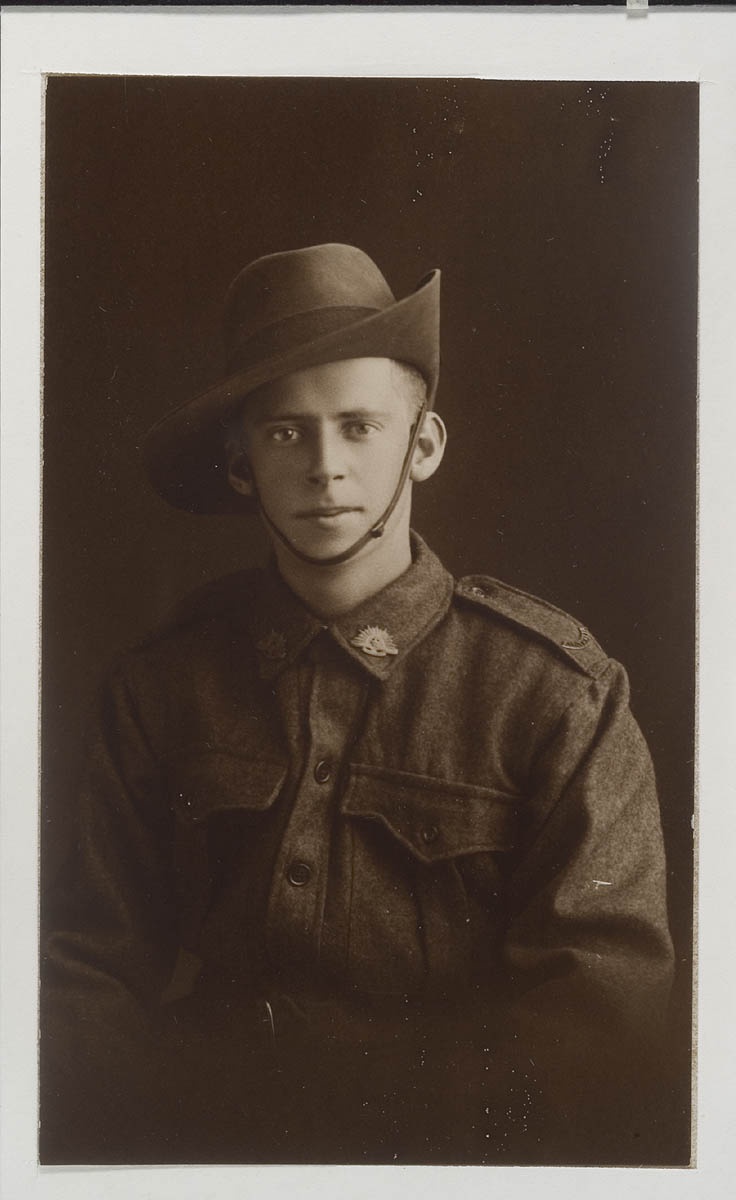
Date of Birth: 5.12.1899
Date of Enlistment: 8.5.1918
Trade or Calling: Plumber
Born in or near what Town: Darlinghurst
Address prior to Enlistment: 22 Carey St, Manly
Rank, Number, Battalion, Distinctions: [59234] Private F Coy [Sapper, Eng. Dtls.]
Casualities and where:
Name & Address of Next of Kin: Mrs Harriet Brentnall, 22 Carey St, Manly
Name and last address of Father: Percy Shardlow Brentnall
Percy Shardlow Brentnall, his father, was a relative to William, husband of Emily.
Charles enlisted mid 1918 as an teenager – 18 years 6 months, and was sent into France to bury the dead – on Grave Duties, until September 1919 – when he was sent home.
He died at an early age – records would indicate that some of the Brentnall men died around 50 years of age – often of cancer which had been fought against for years - although, as all records indicate, many of the men who did not fall on the battlefield or return wounded in body, mind and spirit, did not survive into old age – newspaper reports are numerous stating they took their own lives or drank excessively to cope, in silence, with what they had been through. Many a local RSL started in a shed or boatshed simply as a place where these gentlemen c ould gather with their fellow service people for a quiet drink and talke to people of similar experiences.
MR. CHARLES GEO. BRENTNALL.
The death occurred at his home at 156 Condamine St., Balgowlah, on October 15, of Charles George Brentnall, eldest son of the late Mr. P. S. Brentnall and Mrs. W. J. Brentnall, who were residents of Moorland. Mr. Brentnall was born in Manly in 1900. The funeral moved from St. Matthew's Church, Manly, on October 17, and proceeded to the Northern Suburbs' Crematorium, where a further service was held. Deceased is survived by his wife and son, of Manly; Mother (Taree), and three brothers: Marshall (Laurence), Bert (Burwood), Frank, of Taree. He was a member of the AIF in World War I and his funeral was carried out with military honours. MR. CHARLES GEO. BRENTNALL. (1950, October 21). The Manning River Times and Advocate for the Northern Coast Districts of New South Wales (Taree, NSW : 1898 - 1954), p. 2. Retrieved from http://nla.gov.au/nla.news-article172828919
BRENTNALL.-The Relatives and Friends of the late CHARLES GEORGE BRENTNALL. of 156 Condamine Street, Balgowlah, are kindly Invited to attend his Funeral: to leave St. Matthew's church, The Corso, Manly, after Service commencing at 2.13 o'clock, This (Tuesday) Afternoon, for the Northern Suburbs Crematorium.
T. WAUGH and CO.. Funeral Directors, Manly. Tele., XU111B.
BRENTNALL.-Masonic.-The Officers and Brethren of Lodge Port Jackson, No. 387, U.G.L. of N.S.W., and sister Lodges, are invited to attend the Funeral of their late Brother,. .CHARLES Family Notices (1950, October 17). The Sydney Morning Herald (NSW : 1842 - 1954), p. 20. Retrieved from http://nla.gov.au/nla.news-article27571538
His father had a furniture business with a John Spencer on Manly Corso and was big contributor to community in Manly, in commerce, s[ports and politics. A few notes from the pages of the past:
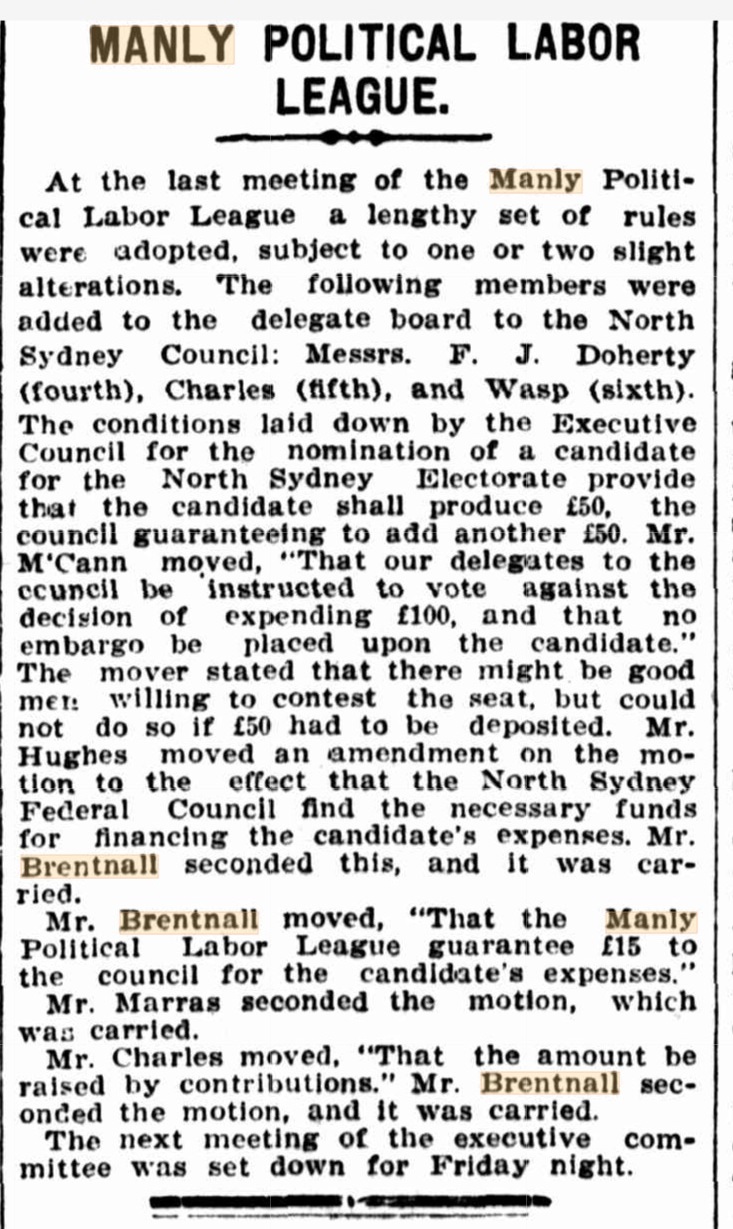
MANLY POLITICAL LABOR LEAGUE. (1909, December 15). The Star (Sydney, NSW : 1909 - 1910), p. 4. Retrieved from http://nla.gov.au/nla.news-article230487376
MANLYS SHOPPING FAIR
Yesterday's Carnival A COMMUNITY SERVICE
Manly was en fete yesterday. It is no longer "the Village by the Sea," but a town of importance that carries a regular population of nearly 24,000, which is increased during the surfing season to any-
thing up to 50,000 persons. This Is not taking into account the hundreds of thousands of people who are casual visitors. The business people of Manly are quite alive to the fact that a big trading Influence is associated with such a number of people. They are also conscious that too frequently it is the last consideration with a vast section of the people who make Manly their abiding place. It was to drive home the realisation that Manly Is a really progressive commercial town, as well as a health-giving, seaside resort, that the Manly and District Chamber of Commerce decided to make an effort to arouse a dosing for shopping support among the people. -The opening ceremony of a 16-day carnival, designated "Manly's Big Shopping Fair," was performed yesterday. The committee of tills body comprises: — President, Ald, A. T. Keirle; vice-presidents, Mr. E. Bennetts, Cr. A. G. Parr (president, Warringah Shire), Mr, W. Cooper; hon. secretary, Mr. Herbert N. Gorfin; hon. treasurer, Mr. It. E. Adrian; committee, Messrs. V. S. Brentnall, A. 1. Campbell, F. N, Dobbs, P. Lazarus, R. Pearce, W. Stewart, D. Briggs, D. Cooper, A. Little, E. Oaten, R. Price, W. Tebbutt, and J. Trennery; with Mr. G. H. Childers as organising secretary. The threatening weather did not prevent many thousands of persons assembling on the East Esplanade, where the ceremony had been arranged. Over 100 gaily bedecked vehicles, mostly motor-driven, were gathered in the vicinity for a procession. The acting-president of the chamber (Mr. E. Bennetts) Introduced the Mayor of Manly (Ald. A. C. Samuels), who expressed his pleasure at being associated with the progressive body of men who constituted though Manly and District Chamber of Commerce. They hoped to demonstrate to the people that they were able to render a community service which had not been recognised to the extent that it should have been in the past. The bussnismen of Manly were citizens at heart, who had invested their money to aid the progress of the district where their business efforts were centred. No settled area had more enterprising men than Manly. The Mayor then officially declared the fair open.
THE PROCESSION.
Headed by the Pipers' Band, the procession moved ffl through the principal avenues of Manly, and it was a pageant worthy of the occasion. It was marshalled by Mr. T. Nimmo, and several hnntfs took their part in. enlivening its passage. The principal streets of Manly were paraded to the Manly Oval, where a programme of athletic and other sports had been arranged. The Mayor, garbed in the attire of the Stewart clan, together with the Mayoress, judged the exhibits as follow: — Trade display, Dobbs Bros. 1, Farrington and ??? 2; group display, Cooper Bros.; business turnout, Fresh Food and Ice Co.; most comical, Palace; ladies' most comical, "Sweet Nell;" industrial display, Tebbutt. The sports programme was so big that five or six events were proceeding simultaneously. Many Scots lassies danced to the pipes, cycles raced to varying distances, Scouts and Girl Guides went through evolutions, shop girls and male employees did their part, and juveniles had a big part assigned to them. Another big crowd assembled in the evening, when the procession re-formed, and open-air concerts off the Esplanade, Steyne, and Corso reminded the people of the objects of the big fair, There was a crowd of about 2500 to witness the first heat of the Inter-State dancing competition at the Palais Hotel last night. Miss D. Culnune and Mr. ,T. Mender (Sydney) beat Miss Mario Tait and Mr. F. Murray (Melbourne). Miss Jansen and Mr. Clonnio were judges. The second heat will be danced on Monday, and the third and final on Wednesday.
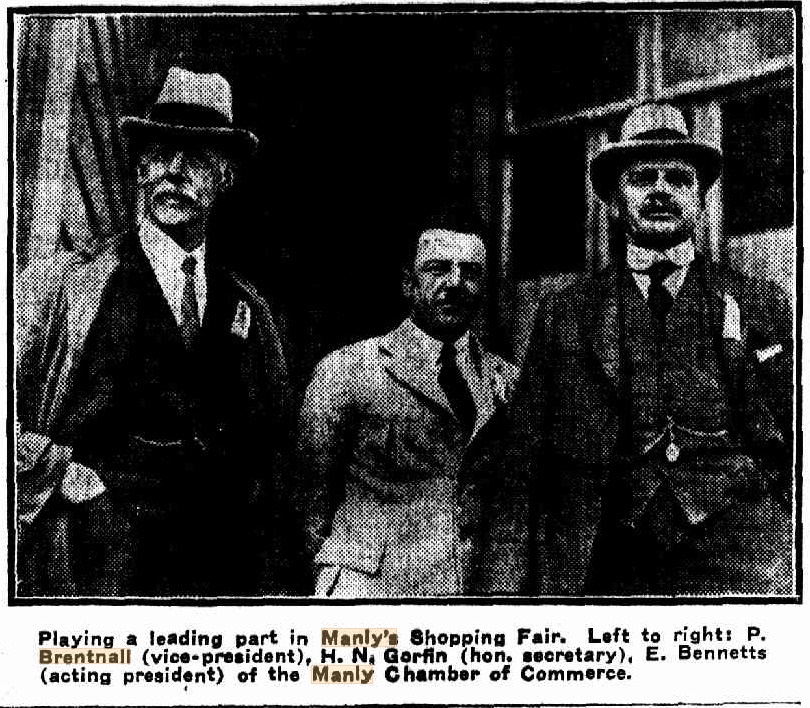
Playing a leading part in Manly's Shopping Fair. Left to right: P. Brentnall (vice-president), H, N Garfin (hon. secretary), E. Bennetts (acting president) of the Manly Chamber of Commerce.
.jpg?timestamp=1636254701919)
.jpg?timestamp=1636254746856)
ALD. A. C. SAMUELS, Mayor of Manly, was in Heilan costume yesterday for the opening of Manly's Shopping Fair. MRS. A. C. SAMUELS, Mayoress of Manly, who has taken a lively interest in the arrangements for Manly's Shopping Fair.
.jpg?timestamp=1636254783217)
"Sweet Nell of Manly" — one of the character sketches In the procession at the opening of the Manly Shopping Fair yesterday. MANLYS SHOPPING FAIR (1924, September 4). The Daily Telegraph (Sydney, NSW : 1883 - 1930), p. 9. Retrieved from http://nla.gov.au/nla.news-article245207313
These obituaries on Mr. P. Brentnall provide some insights into the family:
MR. PERCY SHARDLOW BRENTNALL.
The death occurred in M.R.D. Hospital on Tuesday night, about 11 o'clock, of Mr. Percy Shardlow Brentnall, of Moorland, at the age of 78 years. . The late Mr. Brentnall only entered hospital a week previously, although he had not been very well for some time.
He was a son of Mr. and Mrs. Geo Brentnall. of Yorkshire, England, where the subject of this notice was born. He came to Australia 66 years ago, having come out at the age of 12 years, in charge of the captain. His parents left on a later boat, his mother passing away during the voyage. Mr. P. S. Brentnall married Miss Harriet Wells, of Sydney, in 1894. For some time he conducted a general store business at Manly from which he retired in 1926. That year he came to the Moorland district and acquired an orchard property, and had resided there ever since. He was keenly interested in the cultivation of citrus fruits and established a very fine property. His principal relaxation was fishing. He was one of the founders and first secretary of the Moorland Fruitgrowers' Association, and an early member of the Central North Coast Co-op Society at Taree. He had been a member of the Masonic Order for 50 years. Mr. Brentnall is survived by his wife and four sons, viz., Charles George (Manly); Albert (Burwood), Marshall James (Moorland), and Frank Nelson (Taree). Three children predeceased their father. . Mr. Brentnall was a very highly esteemed resident and a good neighbour and many friends will regret his passing. The funeral left Moorland Church of England, after a service conducted by Rev. J. A: Munro, on Thurs day morning, and the interment took place at Moorland cemetery, Rev. R. A. Munro-also conducting the ser vice. In addition a Masonic service was held; Mr. W. T. Howard was the under taker. MR. PERCY SHARDLOW BRENTNALL. (1946, October 26). The Manning River Times and Advocate for the Northern Coast Districts of New South Wales (Taree, NSW : 1898 - 1954), p. 2. Retrieved from http://nla.gov.au/nla.news-article172166161
OBITUARY
Mr. P. S. Brentnall
After a week’s illness Mr. Percy Shardlow Brentnall passed away at the MRD Hospital at 11pm on Tuesday. He was born in Yorkshire, England 78 years ago, and at the age of 12 years came out to NSW. The trip was made under the care f the ship’s captain, his parents following on a later boat, but on the way out his mother passed away and was buried at sea.
His father settled in Sydney where the subject of this notice established a carrying business, which he conducted until 1907, when he moved to Manly and set up in business as a general storekeeper.
This business was carried on by him until l926 when he came to Moorland to engage in the growing of citrus, which has engaged his interest up to the time of his death. The late Mr Brentnall was a firm believer in the future of Moorland as a orchard area and was always anxious to do all in his power to advance the locality, he evinced a keen interest in the Moorland Fruitgrowers' Association, and other public organisations. He was a prominent Freemason, a Justice of the Peace for many years, and an ardent fisherman. Mr Brentnall was a gentleman in every sense of the word. His courteous, kindly manner, and real interest in the welfare of his fellows, endeared him to all sections of the community. It is interesting to recall that Mr Brentnall is the last survivor of a tragedy that occurred on the Sydney Harbour about 60 years ago. As a youth he was then serving in the submarine, mine section of the Royal Australian Engineers, and on the occasion referred to, a demonstration of exploding an under-sea mine was being given for the benefit of the State Governor. However, by some miscalculation, a cutter was blown up by the mine, killing about 12 of the occupants. Mr Brentnall was one of those who were fortunate enough to escape dying. In addition to his widow, deceased is survived by four sons, viz:. Messrs. Charles George Brentnall (Manly),: Albert (Burwood), Marshall James (Moorland) and Frank Wilson (Taree): One son and two daughters (Mesdames Bert Lyne, of Manly, and H. Perkins, Croydon Park) -predeceased him.
On Thursday morning , a service was conducted at the Moorland Church of England, after which the remains were laid to rest in the Moorland cemetery. Rev R. A: Munro conducted the services at the church and graveside, and the Masonic service was conducted by Wor. Bro Thompson. Mr W. T. Howard was the undertaker. OBITUARY (1946, October 26). The Northern Champion (Taree, NSW : 1913 - 1954), p. 2. Retrieved from http://nla.gov.au/nla.news-article160439194
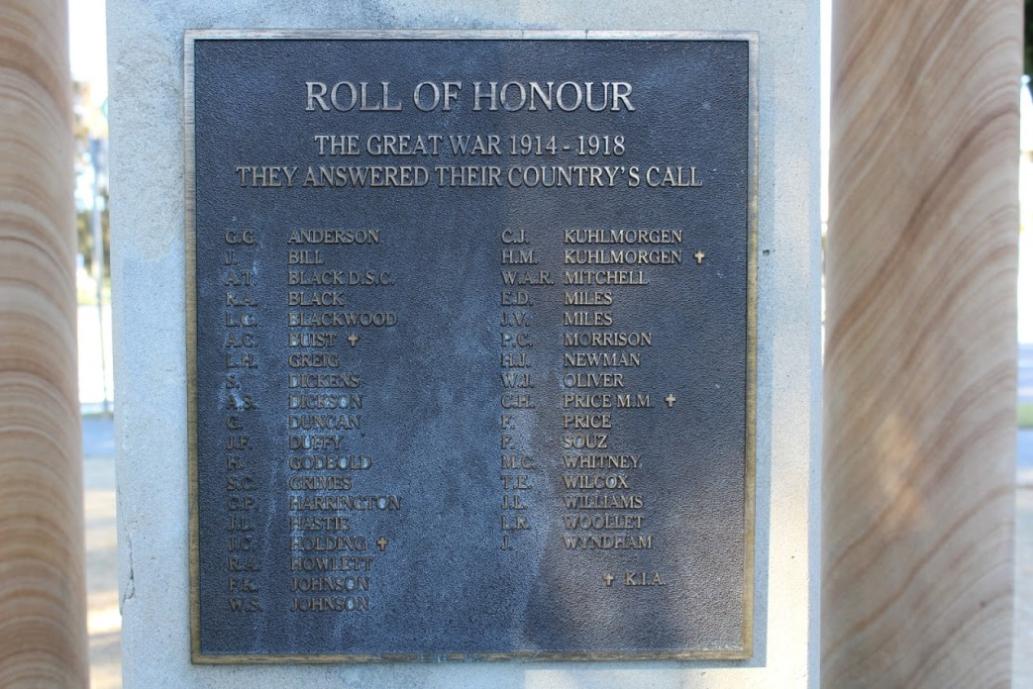
Manly's 1918 enlistments men
George Nelson Hansen
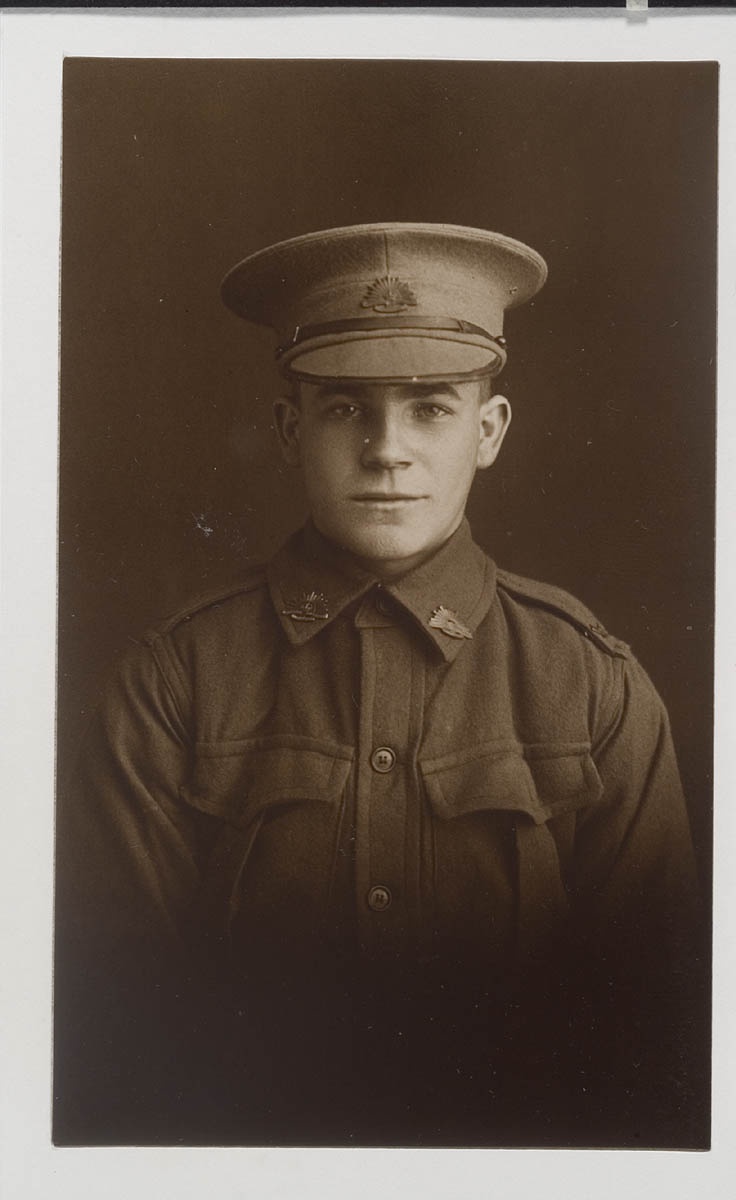
Date of Enlistment: 22.7.1918
Trade or Calling: Groom
Born in or near what Town: Crown St Surry Hills
Address prior to Enlistment: Royal Narrabeen Hotel
Rank, Number, Battalion, Distinctions: Pte 66001 D Recruits 4th Battalion
Casualties and where: RTA 27.9.1919 (RTA: Returned to Australia)
Name & Address of Next of Kin: Dorothy Jane Andrews Macquarie St Chatswood (Mother)
Name and last address of Father:
Leslie Adrian Hook
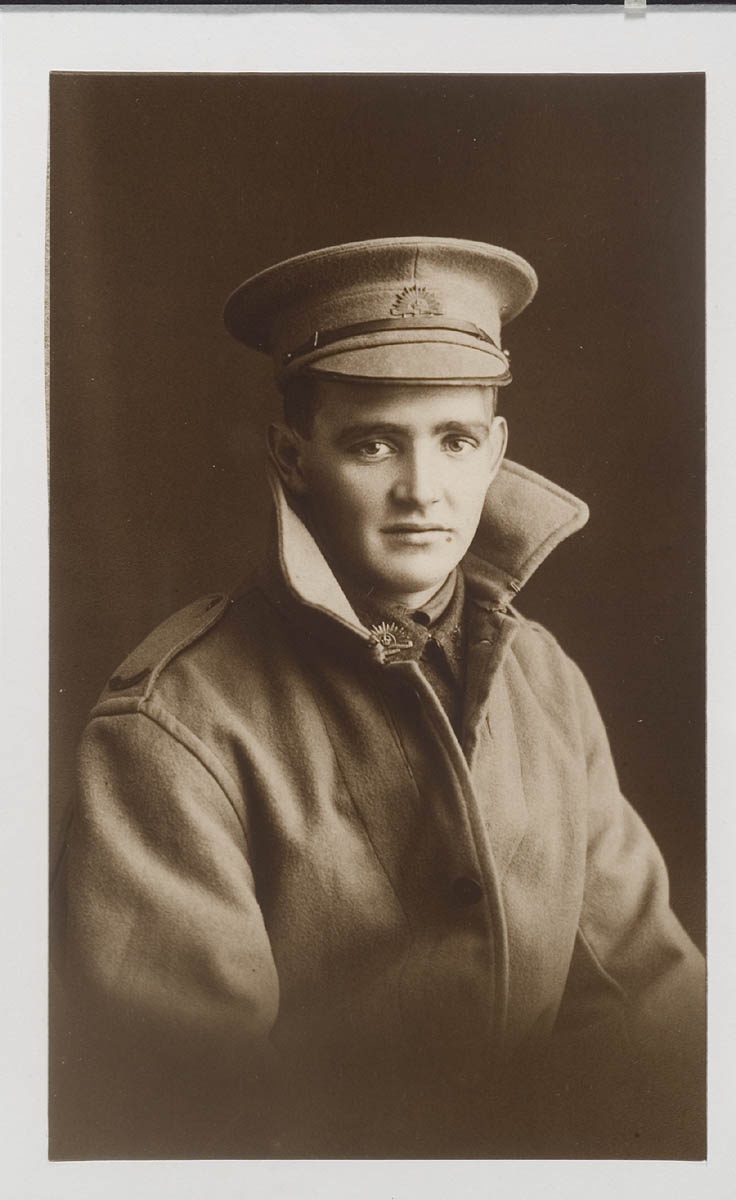
Date of Enlistment: 8.5.1918
Trade or Calling: Plumber
Born in or near what Town: Paddington
Address prior to Enlistment: "Inverness" 40 Quinton Rd Manly
Rank, Number, Battalion, Distinctions: Pte 66318 57th Battalion
Casualties and where:
Name & Address of Next of Kin: Edith Hook "Inverness" 40 Quinton Rd Manly
Name and last address of Father: Thomas Hook "Inverness" 40 Quinton Rd Manly
Edmund Frank Howard
.jpg?timestamp=1636224275175)
Date of Enlistment: 3.1.1918
Trade or Calling: Audit clerk
Born in or near what Town: Parkes
Address prior to Enlistment: 3 Osborne Rd Manly
Rank, Number, Battalion, Distinctions: Pte GS Reinfts
Casualties and where:
Name & Address of Next of Kin: O.J. Howard 3 Osborne Rd Manly
Name and last address of Father: Owen James Howard 3 Osborne Rd Manly
Albert Edward Patison
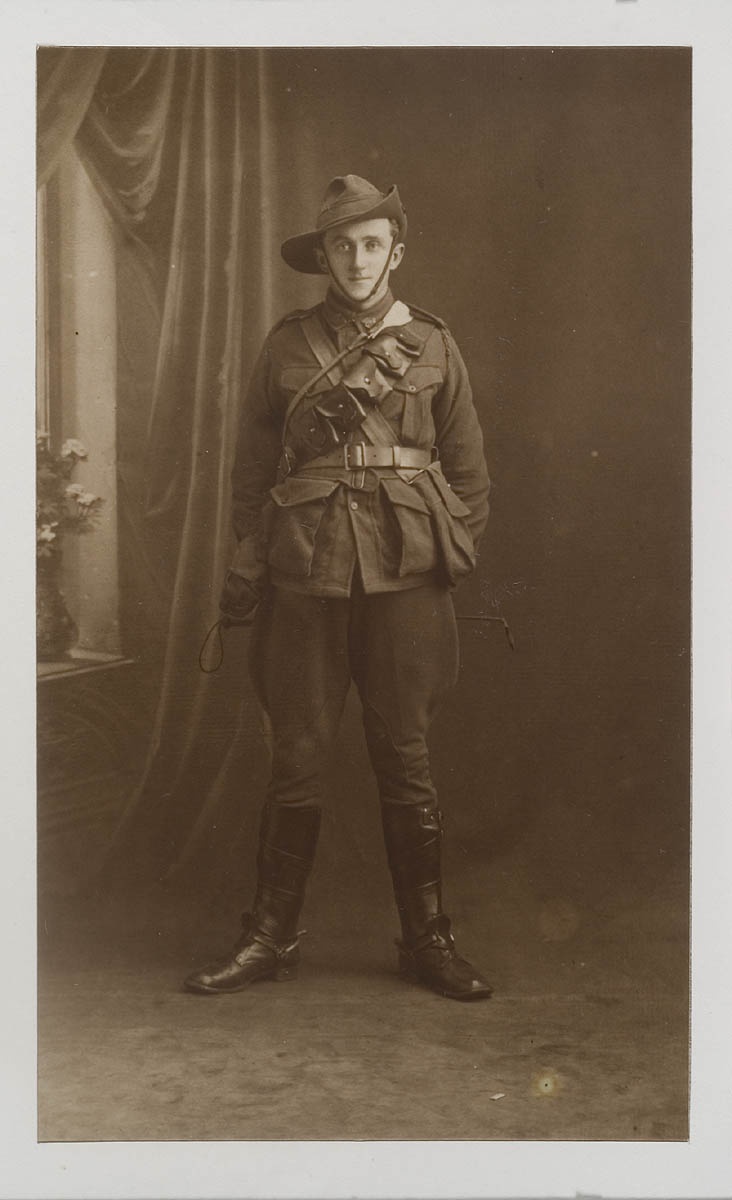
Date of Enlistment: 27.1.1918
Trade or Calling: Clerk
Born in or near what Town: Manly
Address prior to Enlistment: "Athelstane" Clifford Ave Manly
Rank, Number, Battalion, Distinctions: Spr 52735 2nd GS Refts Anzac Mtd Div. Egypt 12th Light Horse
Casualties and where: RTA 20.7.1919
Name & Address of Next of Kin: Mary Ann Patison "Athelstane" Clifford Ave Manly
Name and last address of Father: John Dunmore Laing Patison (address as above)
Reginald William Deane
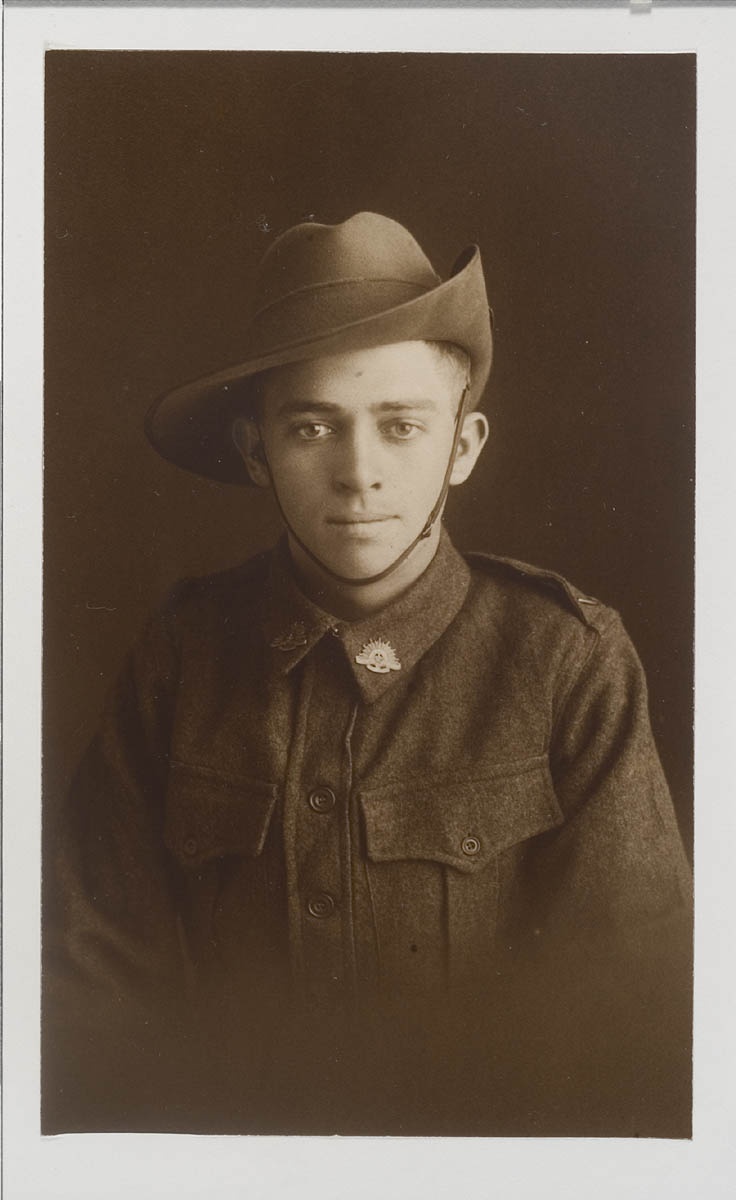
Date of Enlistment: 27.5.1918
Trade or Calling: Warehouseman
Born in or near what Town: Parramatta
Address prior to Enlistment: 14 Denison St, Manly
Rank, Number, Battalion, Distinctions: Pte 60205 E Coy 1st Battalion
Casualities and where: RTA 23.7.1919
Name & Address of Next of Kin: Mrs E.Deane 14 Denison St, Manly (Mother)
Name and last address of Father:
Charles Stanley Nicholson
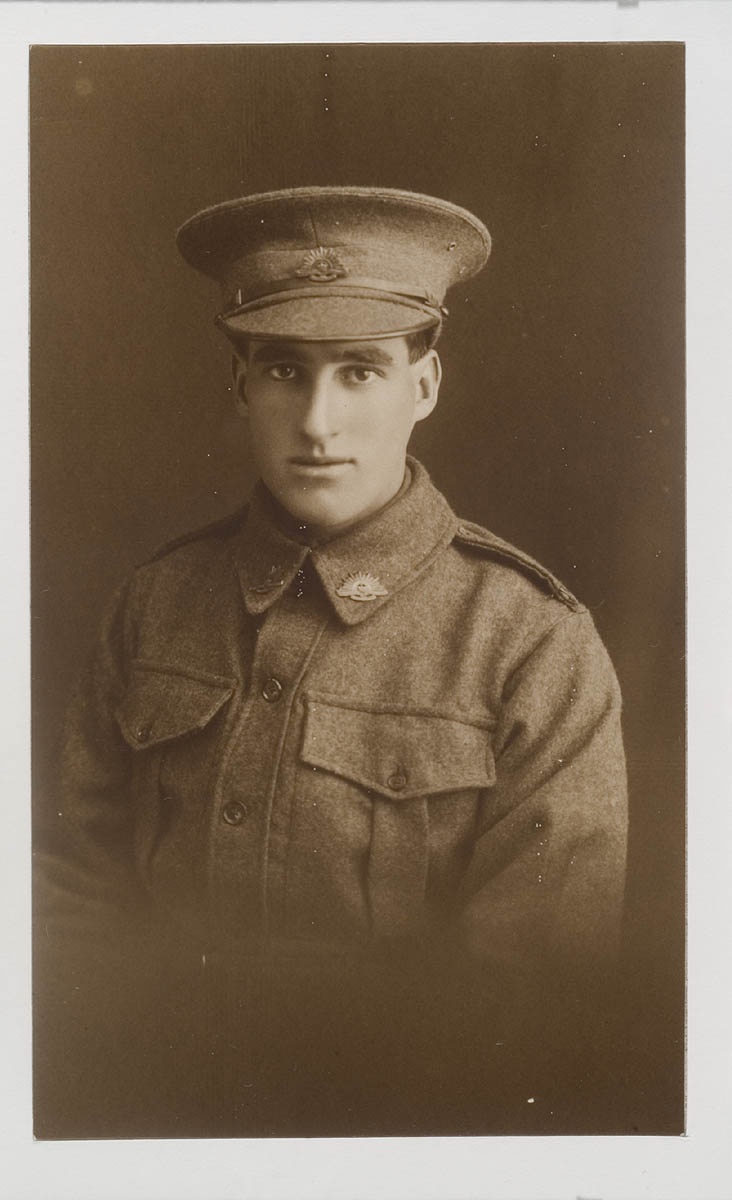
Date of Enlistment: 5.1918
Trade or Calling: Clerk
Born in or near what Town: Sutton Forest NSW
Address prior to Enlistment: 136 Ocean Beach Manly
Rank, Number, Battalion, Distinctions: F Company
Casualties and where:
Name & Address of Next of Kin: Jane A. Nicholson 136 Ocean Beach Manly (Mother)
Name and last address of Father: Chas J. Nicholson 136 Ocean Beach Manly
Horace Eric Heaton
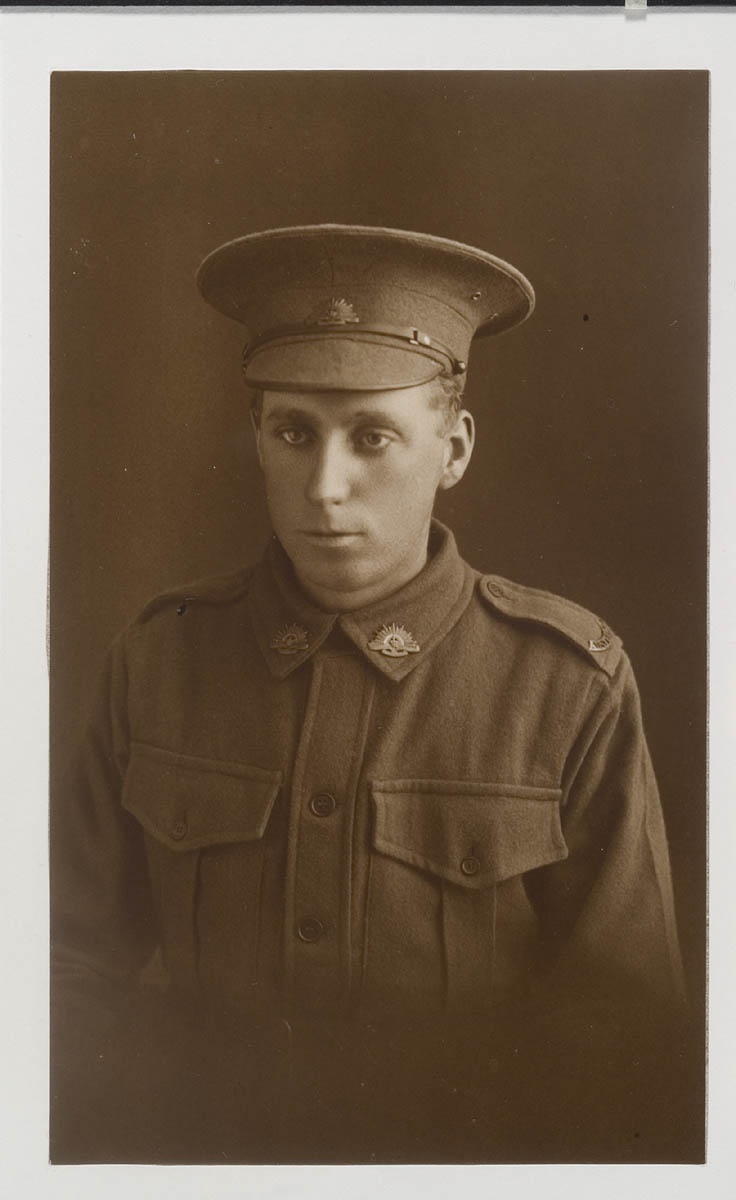
Date of Enlistment: 16.4.1918
Trade or Calling: Motor driver
Born in or near what Town: Manly
Address prior to Enlistment: 136 Pittwater Rd Manly
Rank, Number, Battalion, Distinctions: Pte 54431 Gen Reinfs. 33rd Battalion
Casualties and where: RTA 22.7.1919
Name & Address of Next of Kin: Mrs Heaton 136 Pittwater Rd Manly
Name and last address of Father:
Francis Charles Bailey
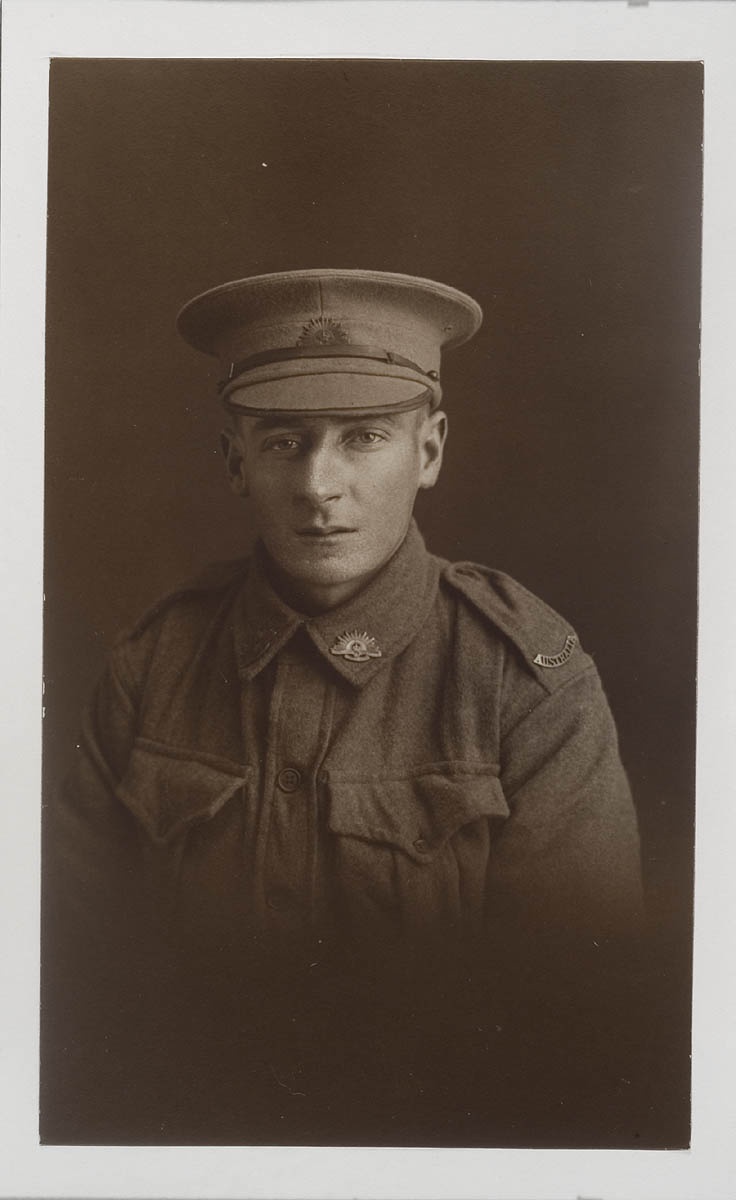
Date of Enlistment: 5.7.1918
Trade or Calling: Painter
Born in or near what Town: Narrabri
Address prior to Enlistment: 4 Whistler Rd, Manly
Rank, Number, Battalion, Distinctions: Private, Composite Batt., C Coy
Casualities and where:
Name & Address of Next of Kin: Mrs E. Bailey, 4 Whistler Rd, Manly
Name and last address of Father:
Stephen Robert Bailey
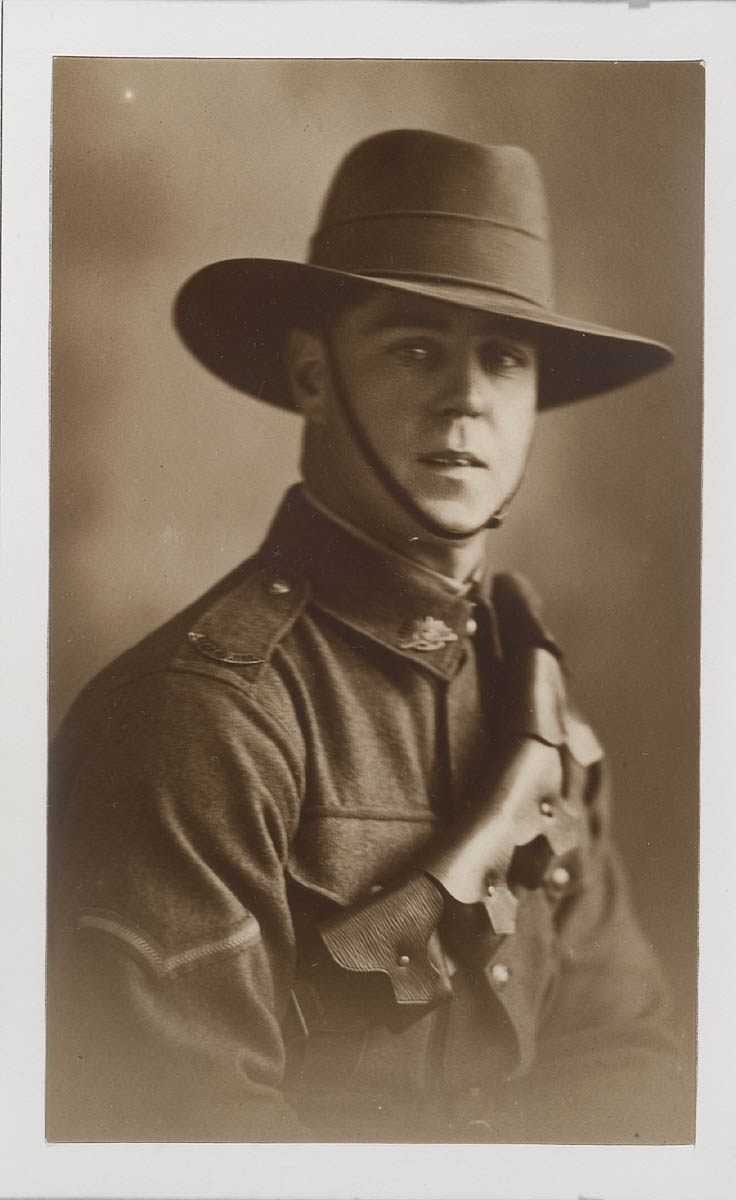
Date of Enlistment: 5.12.1917
Trade or Calling: Electrical fitter
Born in or near what Town: Waverley, NSW
Address prior to Enlistment: Reid St, Waverley
Rank, Number, Battalion, Distinctions: [21446 Sapper] Wireless [1st Sqdn A.F.O.]
Casualties and where: RTA 4.3.1919
Name & Address of Next of Kin: Ethel Bailey, 5 Ashburner St, Manly (Wife)
Name and last address of Father: Edward Henry Bailey, Reid St, Waverley
Gordon Kenrick Hirst
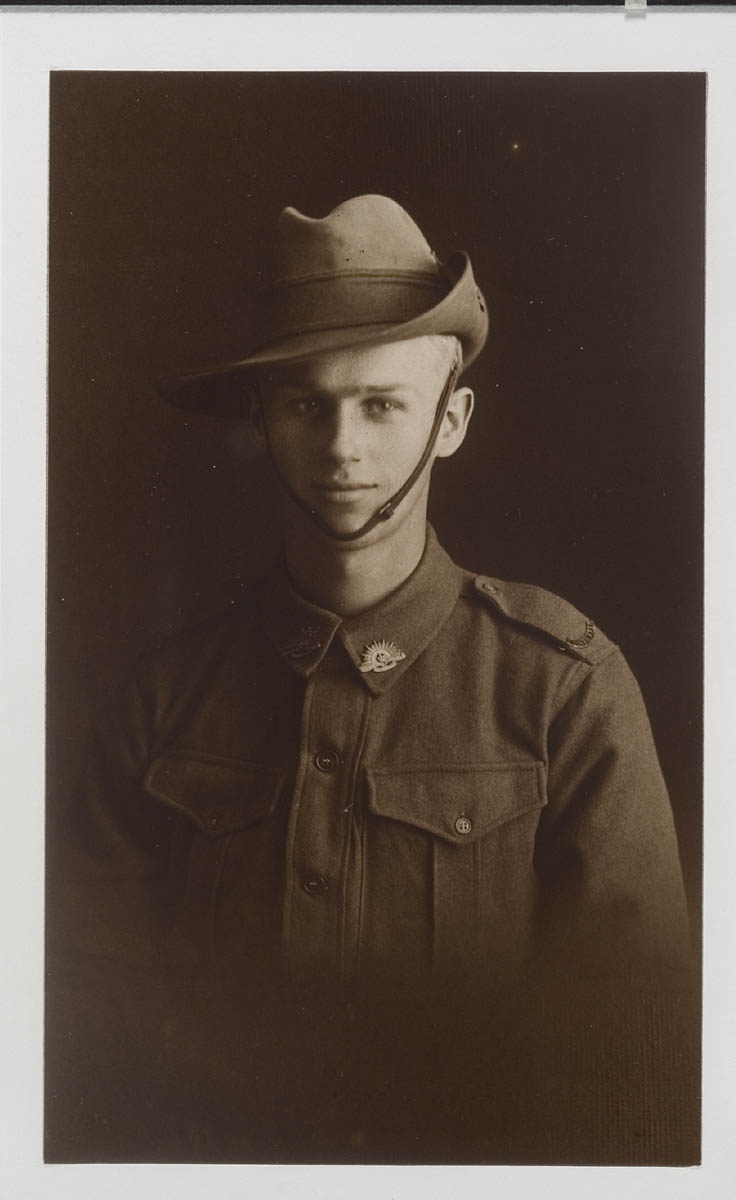
Date of Enlistment: 16.6.1918
Trade or Calling: Clerk
Born in or near what Town: Sydney
Address prior to Enlistment: 46 Muston St Mosman
Rank, Number, Battalion, Distinctions: Pte
Casualties and where:
Name & Address of Next of Kin: Percy Hirst 10 Ward St Manly
Name and last address of Father: Percy Hirst
Charles Augustus Boyd
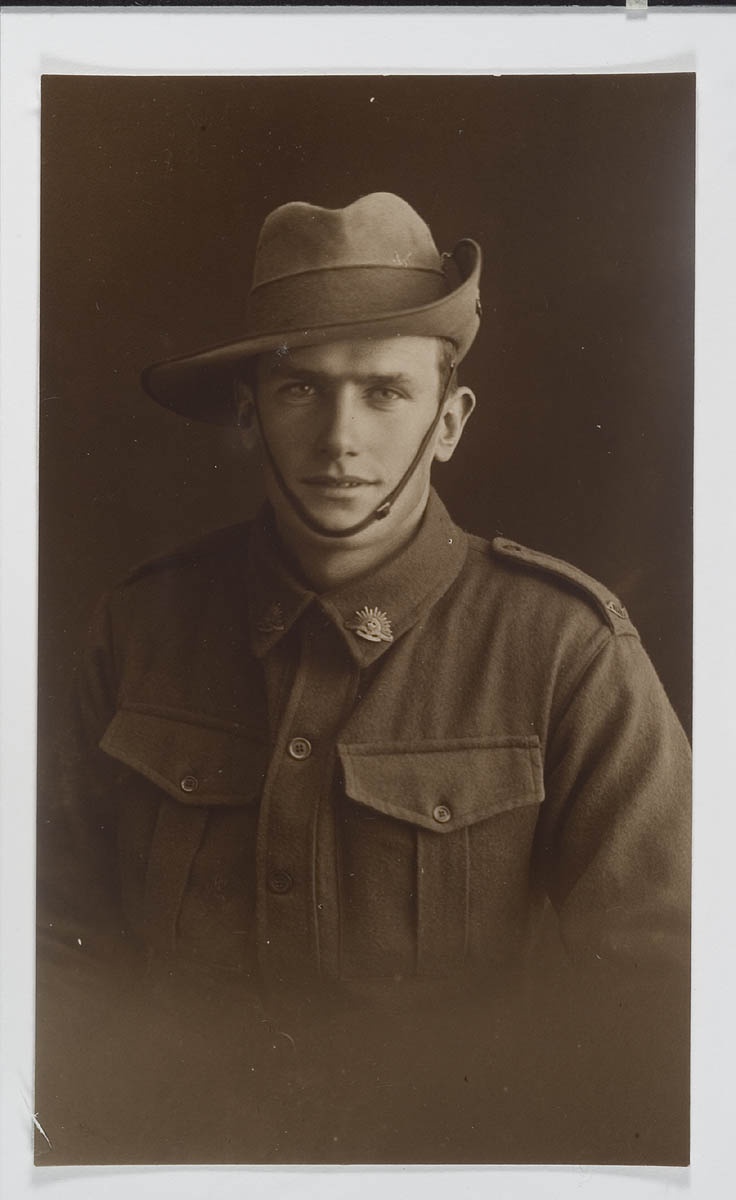
Date of Enlistment: 6.5.[no year] [i.e. 20.5.1918]
Trade or Calling: Miner
Born in or near what Town: Mosman
Address prior to Enlistment: Esplanade, Manly
Rank, Number, Battalion, Distinctions: A Coy Recruits [A.A.M.C.]
Casualties and where:
Name & Address of Next of Kin: Mary Jane Boyd, Esplanade, Manly
Name and last address of Father:
A.L.K. Cooper
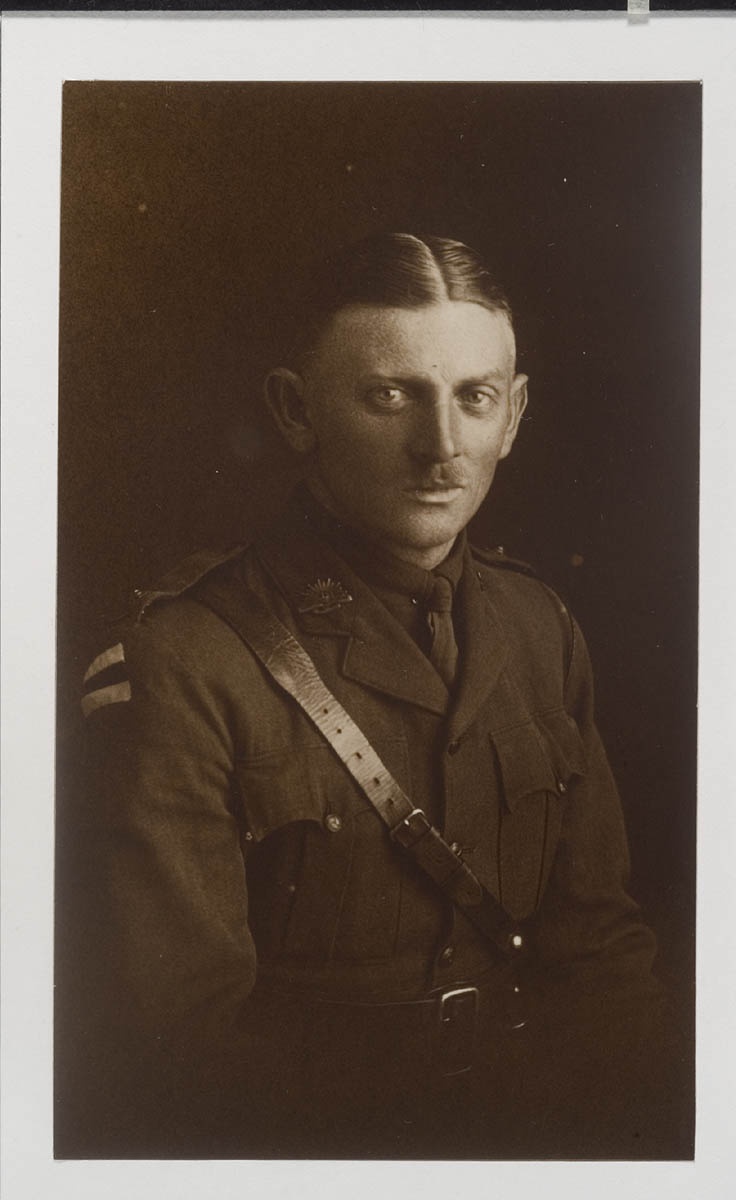
Date of Enlistment: 20.8.1914
Trade or Calling: Engineer
Born in or near what Town: Sydney
Address prior to Enlistment: "Kidston" Fairlight St, Manly
Rank, Number, Battalion, Distinctions: Lieutenant
Casualties and where:
Name & Address of Next of Kin: Miss Keefe, 55 Denison St, Waverley
Name and last address of Father: Joseph Cooper, c/o Dalgety & Co., Millers Pt
William Edwards
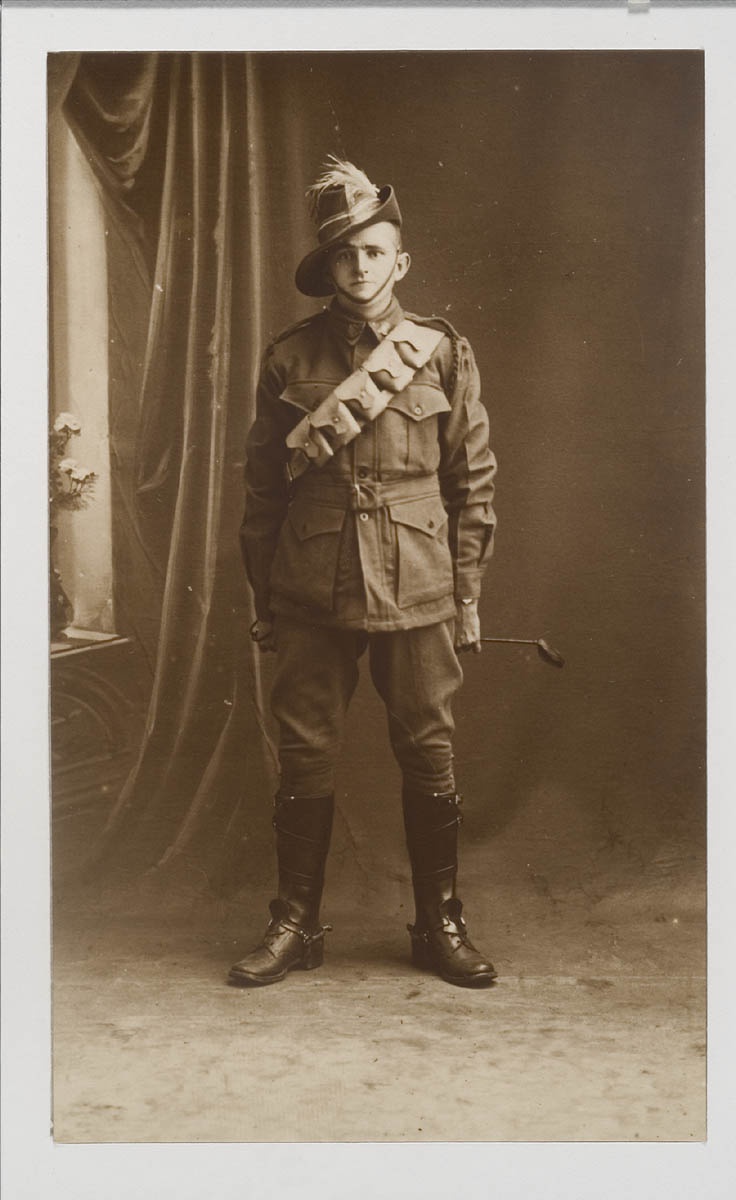
Date of Enlistment: 29.1.1918
Trade or Calling: Grocer
Born in or near what Town: Sydney
Address prior to Enlistment: 159 William St
Rank, Number, Battalion, Distinctions: Pte 52704 1st Light Horse
Casualities and where: RTA 13.3.1919
Name & Address of Next of Kin: Miss V. Patterson, Belmore no. 2, 67 West Esplanade, Manly
Name and last address of Father:
Arthur Edgar Jackson
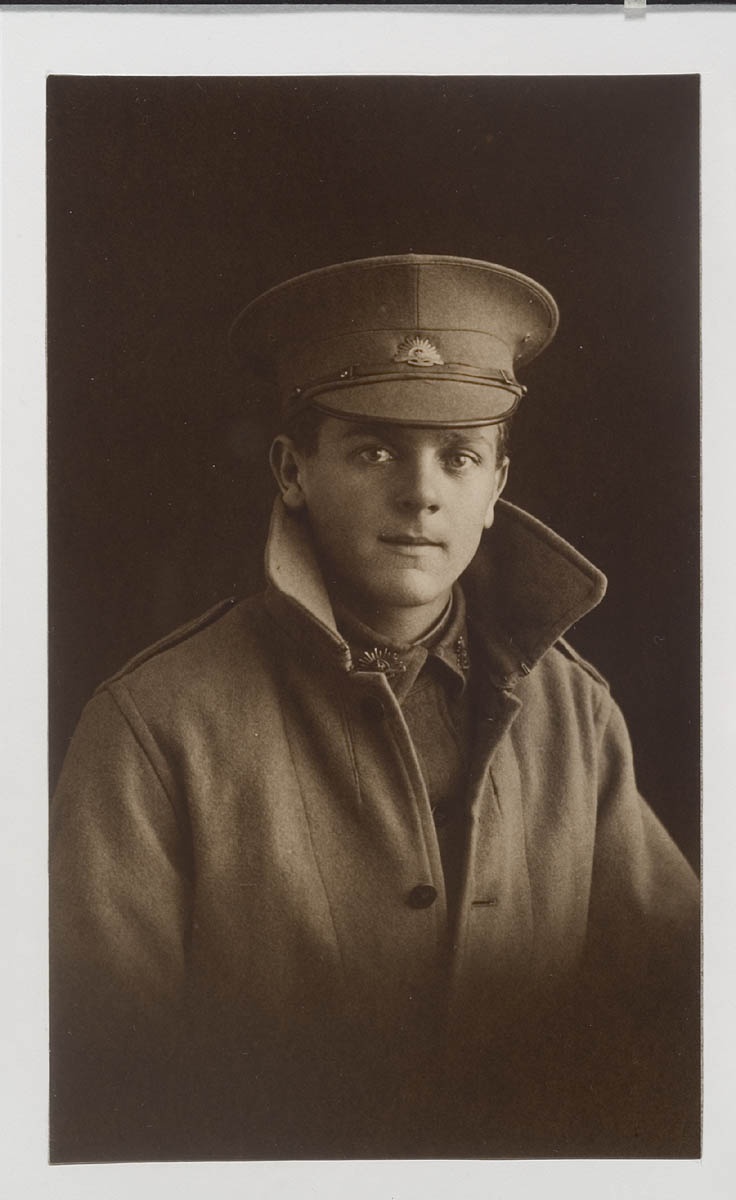
School: Terrace School, Wellington NZ, then Technical Secondary School NZ
Came to Australia aged 16 years
Date of Enlistment: 17.4.1918 (Sydney)
Trade or Calling: Salesman
Born in or near what Town: Wellington NZ
Address prior to Enlistment: "Cecil" Lauderdale St Manly [Fairlight]
Rank, Number, Battalion, Distinctions: Pte 58806 10th GSR
Casualties and where: DOD (appendicitis, died in a London hospital) 4.10.1918
Memorial Panel: 185
Cemetery or Memorial Details: Surrey 1 Brookwood Military Cemetery
Name & Address of Next of Kin: Edith Naomi Jackson 38 Bay St Petone Wellington NZ (Mother)
Name and last address of Father:
Source: AWM145 Roll of Honour cards, 1914-1918 War, Army

References and Extras
- Pittwater Roads II: Where The Streets Have Your Name - Bayview
- TROVE - National Library of Australia
- Remembrance Day 2016: War Memorials - Mona Vale, November 14, 1926
From Pittwater Roads II: Where The Streets Have Your Name - Bayview:
NEWPORT,
Opposite the Newport Hotel and Vogan's Point,
Almost adjoining Allen's Wharf, 5 minutes from Bayview-road, along Mona-street.
WINTERGREEN ESTATE.
30 BEAUTIFUL SITES, NICELY SLOPING TO THE WATER. PRETTILY TIMBERED.
AUCTION SALE ON THE GROUND,
SATURDAY, 23TH OCTOBER, 1913-
Illustrated Plans on Application.
TERMS: 10 per cent. Deposit, Balance
in 12 Quarterly
Payments at 5 per cent. int.
HARDIE AND GORMAN PROPRIETARY, LTD.,
Auctioneers, 183 Pitt-street.
W. E. DREW, Esq.,
14 Moore-street, Solicitor to the Estate. Advertising (1913, September 27). The Daily Telegraph (Sydney, NSW : 1883 - 1930), p. 21. Retrieved from http://nla.gov.au/nla.news-article238908480 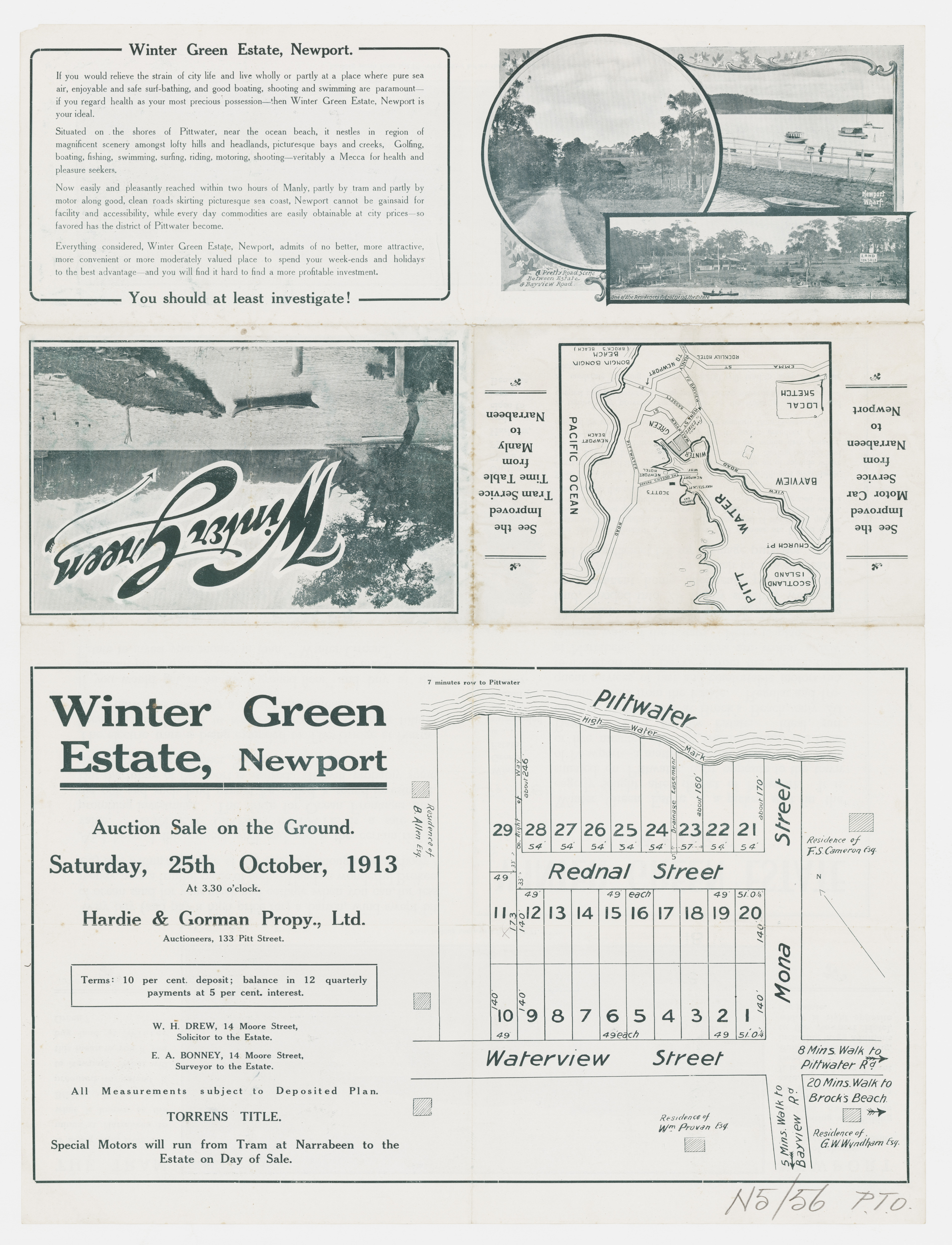
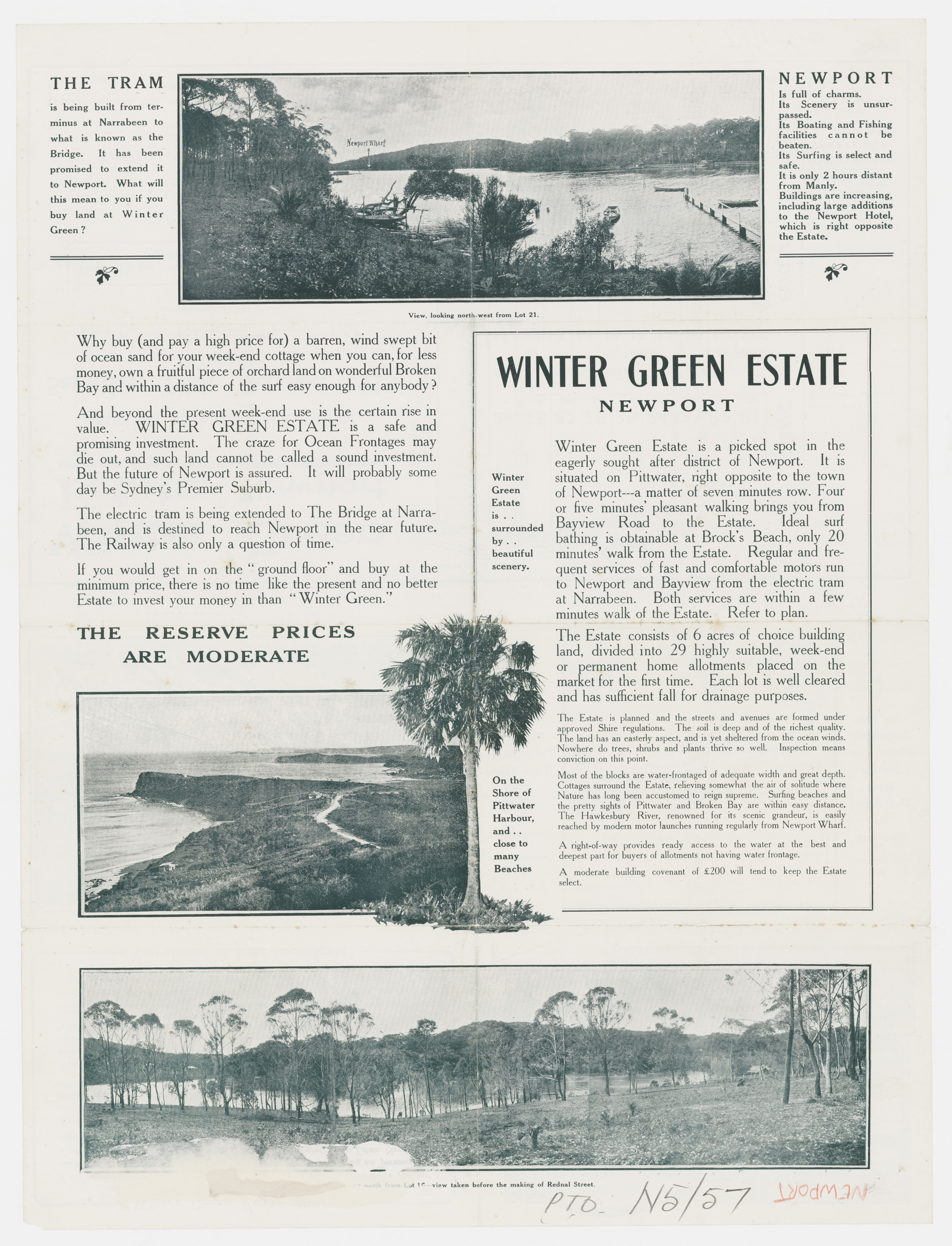
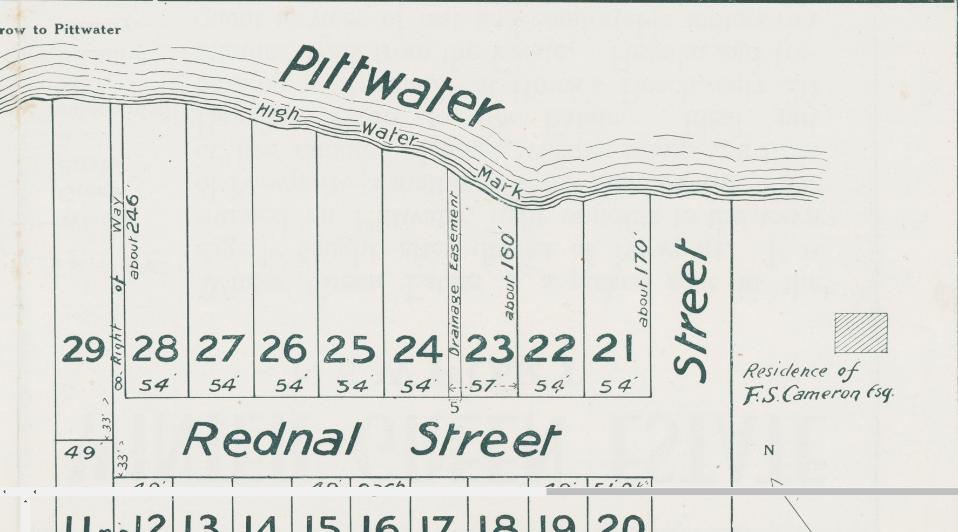

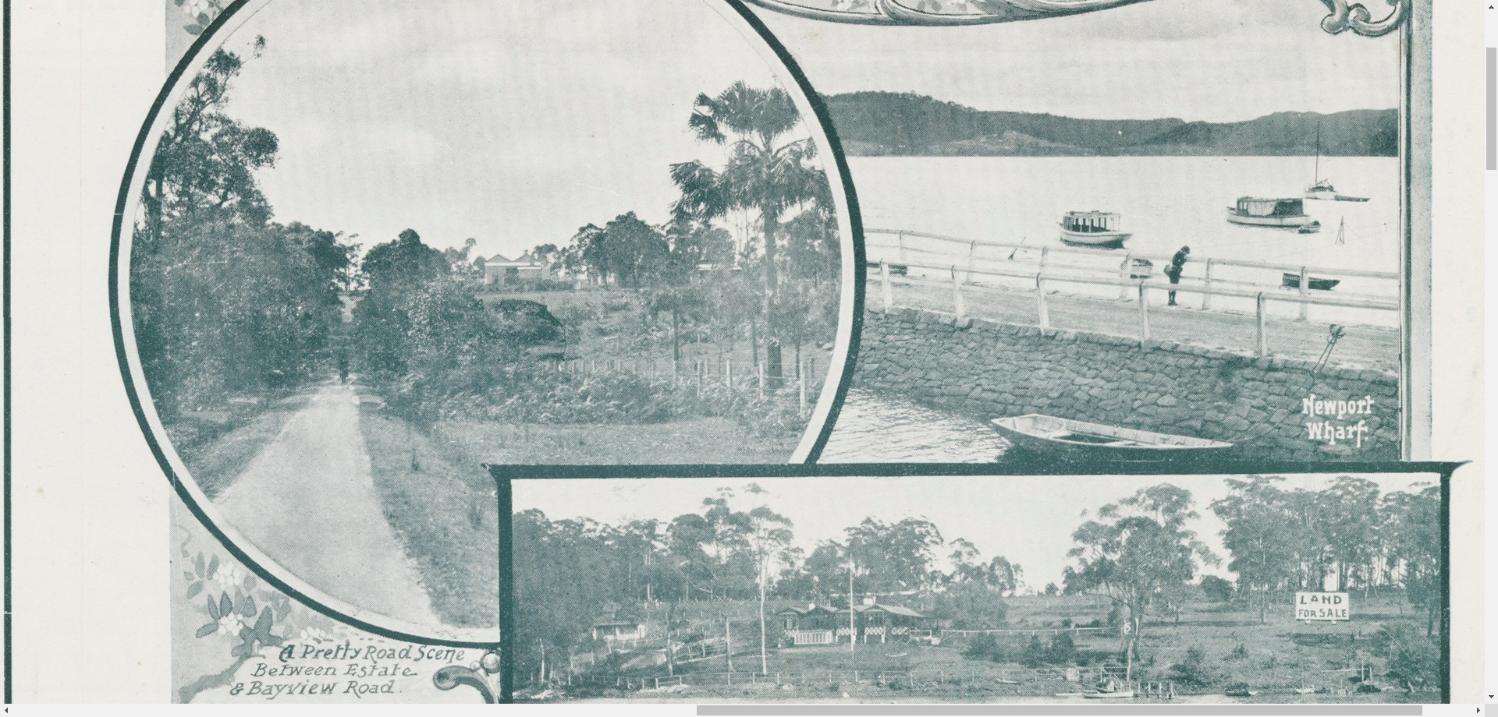
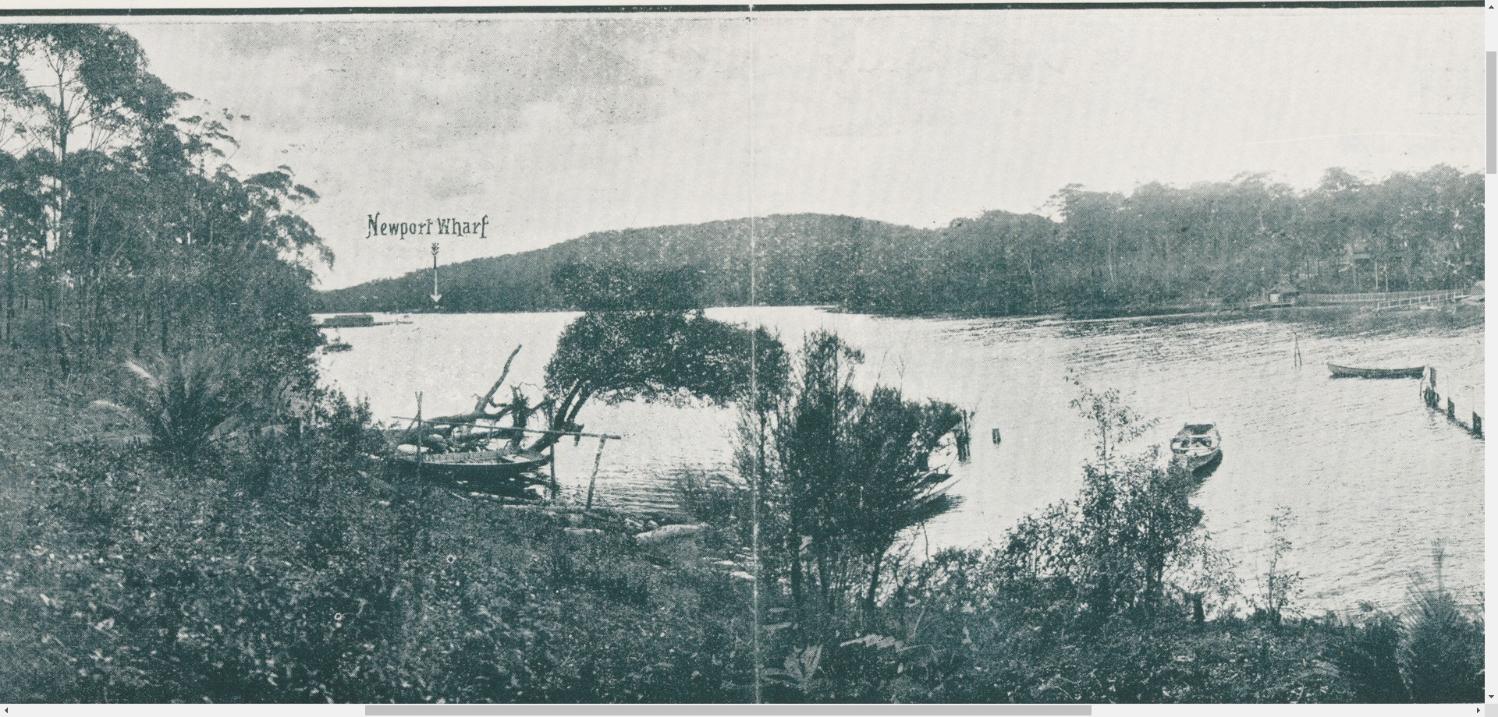
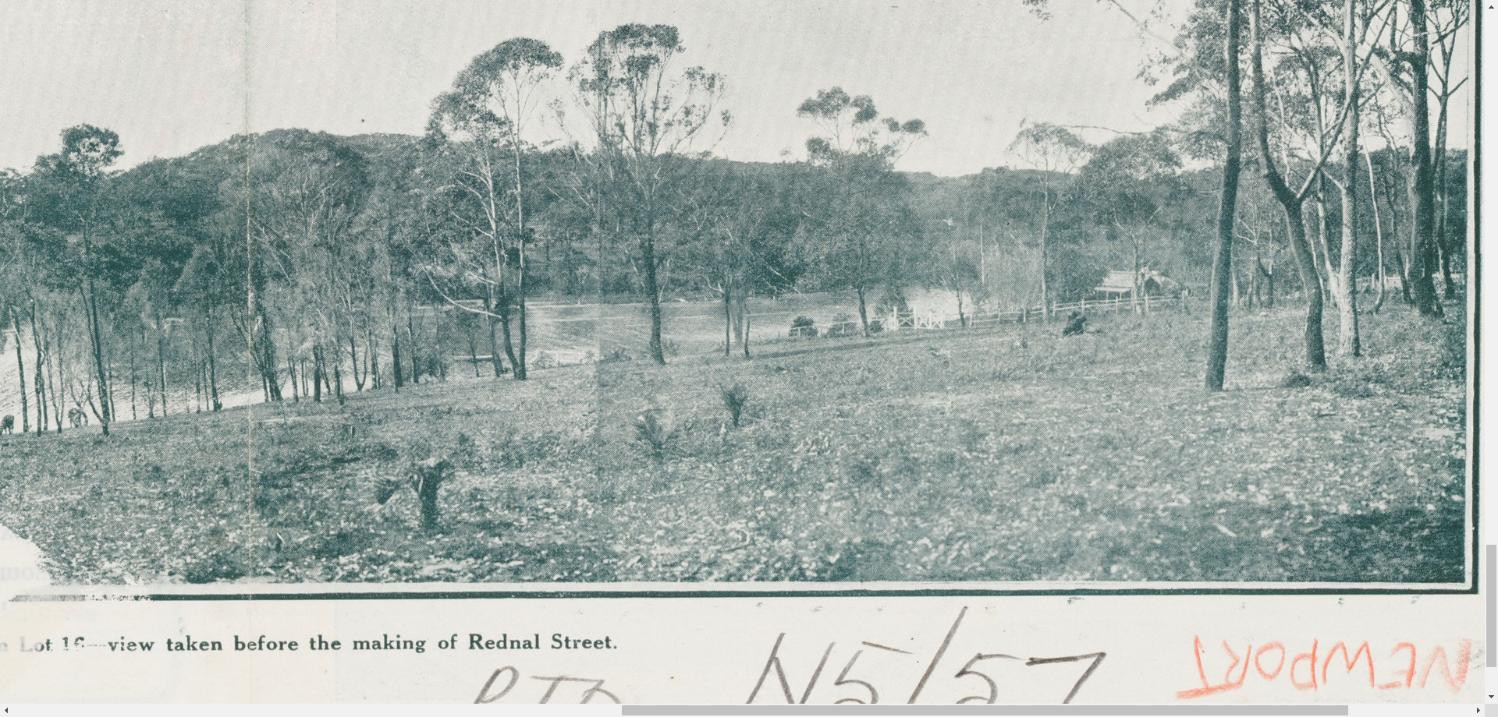
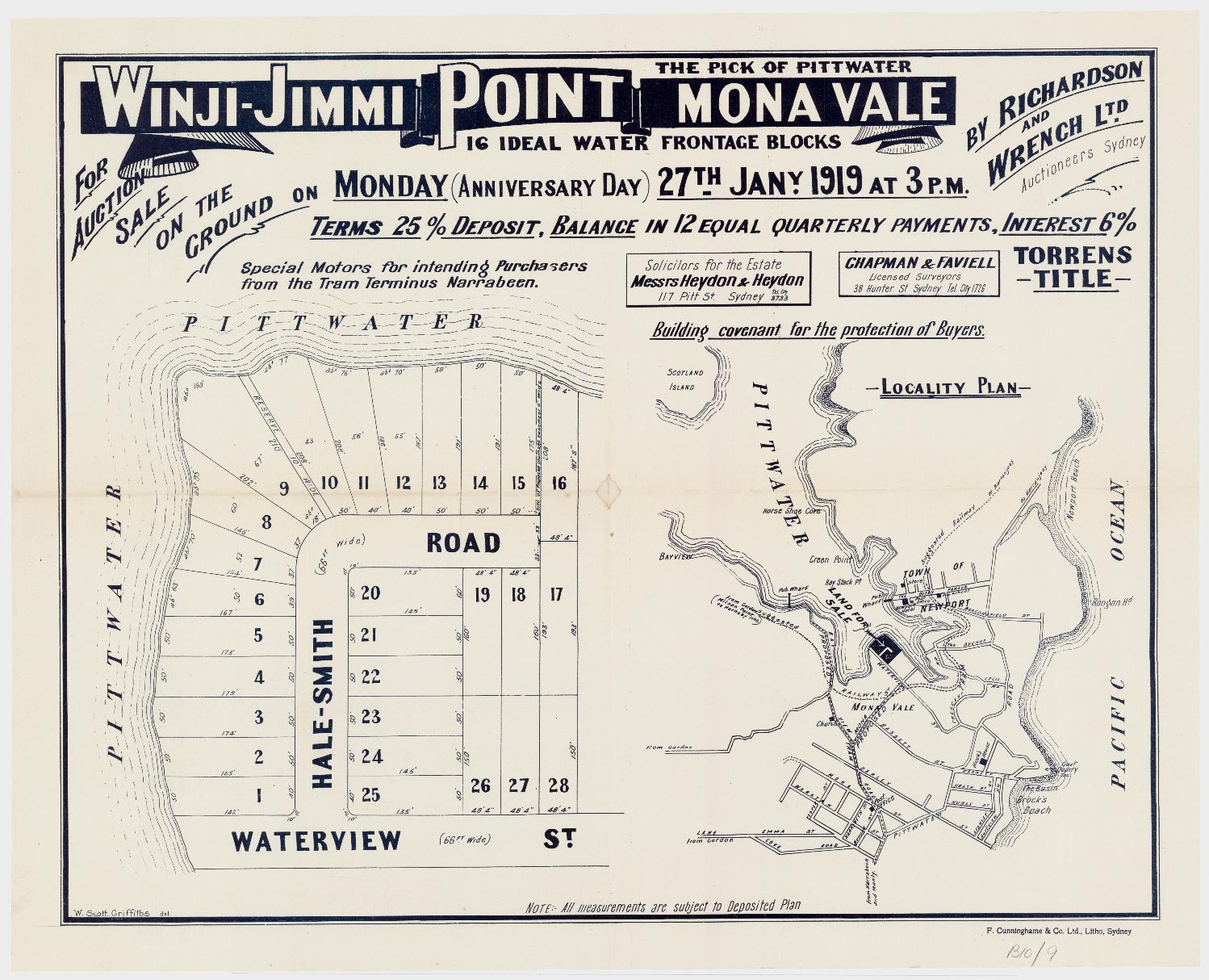
Winji Jimmi Point Mona Vale - Waterview St, Pittwater, Hale-Smith Rd, January 27th, 1919. Item: c029500009
Quite a number of subdivisional sales will be held to-day or on Monday. Messrs Richardson and Wrench will offer on Monday the Mona Vale Estate, Pittwater, on Winji Jimmi Point. There are 28 allotments, of which 16 have water frontages. The same firm, in conjunction with Mr. Lance Giddings, will offer also on Monday the Second subdivision of Matson City, Cronulla. REAL ESTATE. (1919, January 25). The Sydney Morning Herald (NSW : 1842 - 1954), p. 9. Retrieved from http://nla.gov.au/nla.news-article15821838
Warringah Shire Council Minutes of Meetings provides: Winji Jimmi Subdivision - Heydon and Heydon, 3/1/ 19, forwarding cheque for £190, for Winji Jimmi Subdivision road construction : Resolved, That the writers be informed that the Council is prepared to carry out the work in accordance with the letter so far as the money will go, but that it will probably not be able to start the work before the 26th inst., and that it will not object to the selling of the allotments before the subdivision road is constructed. It was decided to suggest that the new street be named Hale-Smith Street.
A few years on:
UNDER INSTRUCTIONS FROM THE UNION TRUSTEE COMPANY OF AUSTRALIA. LIMITED, ADMINISTRATORS C. T. A. OF THE ESTATE OF THE LATE B. B. ALLEN.
ABSOLUTE DEEP WATER FRONTAGE TO PITTWATER.
WITH COTTAGE RESIDENCE, "WINGI JIMMI." FRONTING WATERVIEW-STREET, and TWO CHOICE BUILDING ALLOTMENTS.
Only a few minutes' walk from Main Pittwater -road.
1. A MOST DESIRABLE WATER FRONTAGE COTTAGE, with a SPECIAL APPEAL to YACHTS NORTH-EASTERLY ASPECT. "WINGI JIMMI," A WELL-CONSTRUCTED COTTAGE OF BRICK, finished in roughcast cement, with roof of galvanised iron, containing dining-room end two bedrooms, each with fireplace, bathroom, verandah to front 9 feet wide, verandah at rear 10 x 10, kitchen with fuel stove, laundry. Water laid on from tanks to kitchen, bathroom, and laundry.
THE OUTBUILDINGS comprise WEATHER-BOARD GARAGE with concrete floor. Hardwood 2-stall stable, feedroom, and woodshed.
ON THE WATER FRONT is erected a SUBSTANTIAL WEATHERBOARD BOATSHED, with roof of galvanised Iron, with skids attached,
ALSO a WELL-CONSTRUCTED RUBBLE JETTY and a LARGE ENCLOSED SWIMMING BATH.
THE LAND has a frontage to WATERVIEW STREET Of 100ft by a depth of 529ft. IN AREA 1 acre 0 roods 3 perches. FREEHOLD NOTE.-This property should COMMEND Itself to YACHTSMEN and OTHERS desirous of securing In a HANDY. GET ABLE, and CHARMING LOCATION a DESIRABLE WATERSIDE HOME, eithe- as a permanent residence or for holiday or week-end periods.
THE WHOLE IN ABSOLUTE PERFECT ORDER.
TERMS: 25 per cent, deposit, balance In 3 years. Interest 6 1/2 per cent.
FOR INSPECTION apply H. E. PORTER, Newport
ADJOINING "WINGI JIMMI" are TWO CHOICE BUILDING ALLOTMENTS, as follows:
VACANT LAND, Lot 28, having a frontage to WATERVIEW-STREET of 48.4 by a depth of VACANT LAND at rear of Lot 28. being Lot 17 with a frontage to HALE-SMITH-STREET'of 33ft by a depth of 193, rear line 48.4. Torrens.
TERMS: 10 per cent, deposit, balance In equal quarterly payments. Interest 6 per cent.
GRAY and CO., 135 PITT-STREET : and at MOSMAN, in conjunction with H.E. PORTER, Pittwater road, NEWPORT, will submit the above-deseribed PROPERTIES at PUBLIC AUCTION on THURSDAY.21st
NOVEMBER, at 11.15 am.. at THE REAL ESTATE INSTITUTE, 30a MARTIN-PLACE. SYDNEY.
Messrs. MINTER SIMPSON and CO.. Union Bank Chambers, Hunter-street, solicitors to the Estate. Advertising (1929, November 9). The Sydney Morning Herald (NSW : 1842 - 1954), p. 27. Retrieved from http://nla.gov.au/nla.news-article16600388
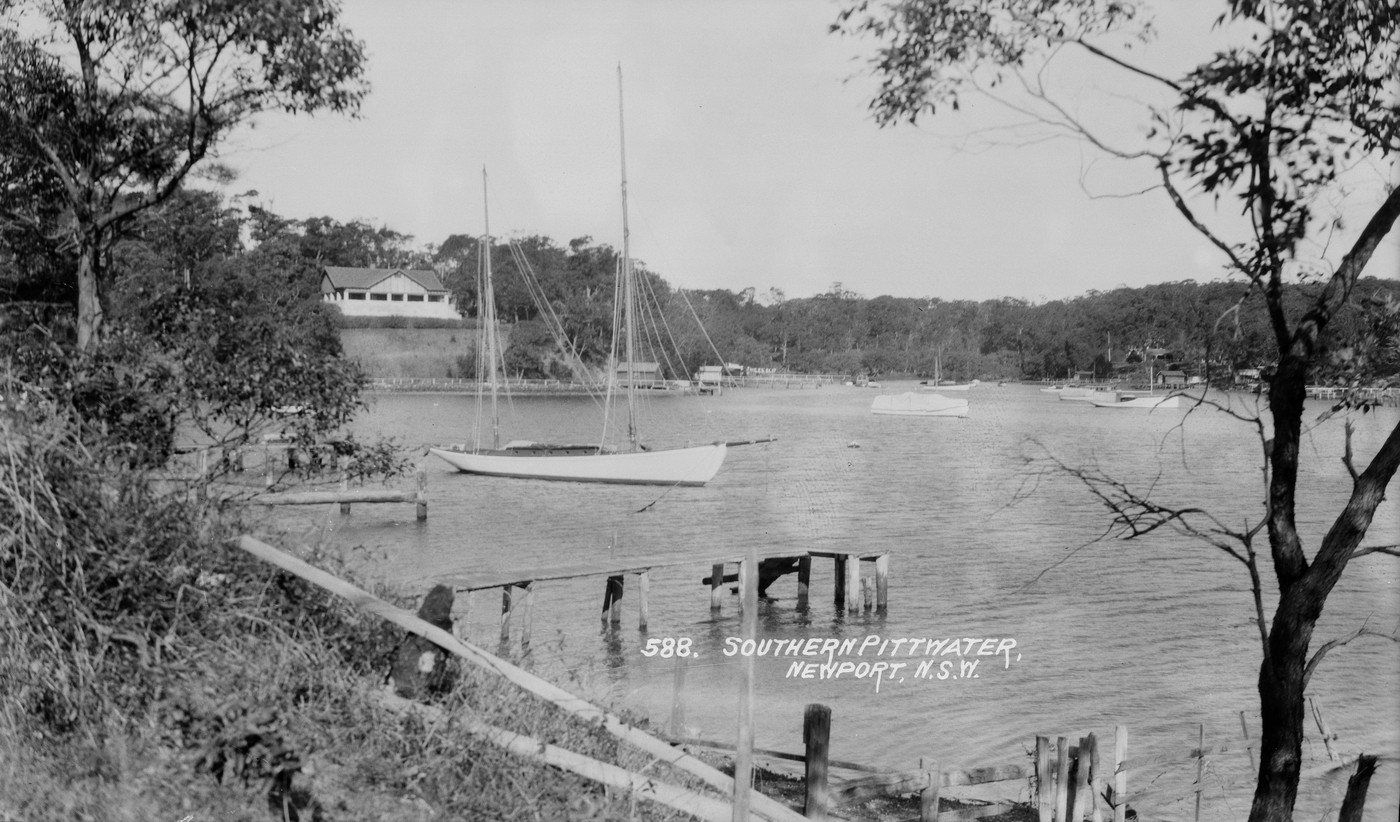
Southern Pittwater (Newport - Winji Jimm) from album ''Samuel Wood - postcard photonegatives of Avalon, Bilgola and Newport, ca. 1928'', Item: a1470007h , Courtesy Mitchell Library, State Library of New South Wales
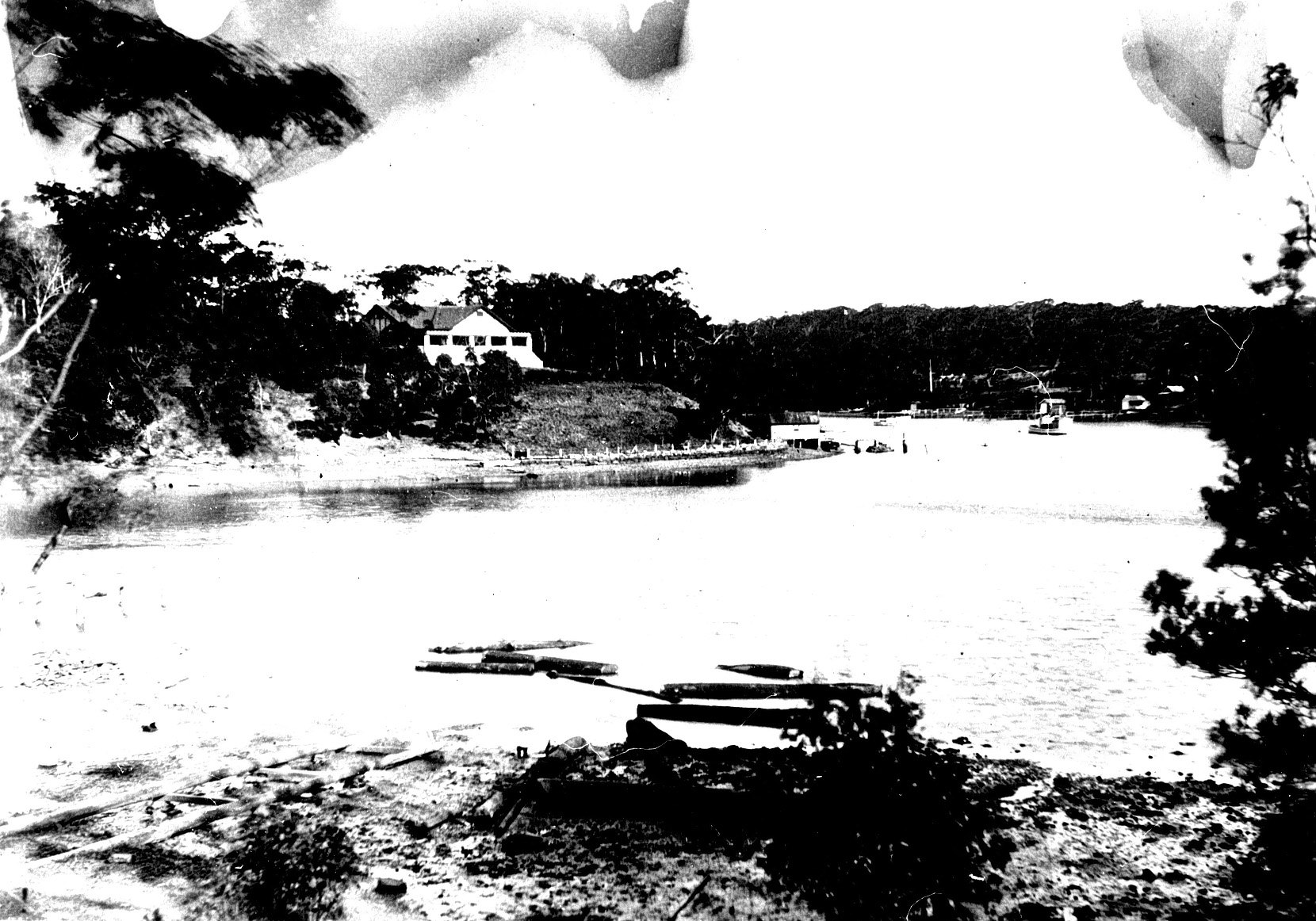
Pittwater. There is a boat moored to a small pier in the foreground. Creator; Alan Jackson, circa 1930. Courtesy Museums Victoria
Mr Allen passed away at his home in Wahroonga at the age of 61:
DEATH OF MR. B. B. ALLEN
The news of the death of Mr. B. B. Allen was received with sincere regret throughout New South Wales. Many graziers will feel that they have lost a personal friend. For years Mr. B. B. Allen was chairman of the Executive Council of the Graziers' Council, and he was a most successful chairman. His tact was proverbial, his knowledge was comprehensive, and his one desire was to do the right thing by the pastoral industry.
Everybody who knew B. B. Allen liked him. He had personal charm, and nothing ever seemed a trouble to him. You could go to him for advice, or you could go to him to do something for you, and you would always be sure of the most courteous consideration; and if it was in his power he would help you.
Since 1902 Mr. Allen had been a member of the Executive Committee. In April, 1910, he was appointed chairman of the committee and retained that position until a few months ago. He was chairman of many important conferences, and he represented the Association at several Federal Conferences. His never-failing tact helped to make him an admirable chairman, and an exceedingly worthy representative. Mr. Allen was a member of the committee of the Sydney Wool Selling Brokers for many years, and for several years past occupied the position of treasurer. He was also a member of the Sydney Chamber of Commerce and the Sheep Breeders' Association of New South Wales.
Mr. Allen is survived by Mrs. Allen, and by two daughters — Mrs. McKechnie, wife of the manager of Manaroo Station, Central Queensland; and Mrs. Auschau, of Sydney — and one son, Mr. Ernest Allen, of Eumarra Station, Brewarrina. DEATH OF MR. B. B. ALLEN (1928, October 2). The Tumut and Adelong Times (NSW : 1864 - 1867; 1899 - 1950), p. 1. Retrieved from http://nla.gov.au/nla.news-article139291643
In the Supreme Court of New South Wales.
PROBATE JURISDICTION.
In the will of Bernard Barnett Allen, late of Sydney, in the State of New South Wales, company manager, deceased.
PURSUANT to the provisions of the Wills, Probate and Administration Act, 1898, of the Testator's Family Maintenance and Guardianship of Infants Act; 1916, and of the Trustee Act, 1925: Notice is hereby given that all creditors and other persons having any claim, demand upon or against the estate or otherwise interested in the property and assets of the abovenamed deceased, who died at Wahroonga, on the 23rd day of September, 1928, and letters of administration, with the will annexed, of whose estate were granted by the Supreme Court of New South Wales, in its Probate Jurisdiction, on the 21st day of December, 1928, to The Union Trustee Company of Australia Limited, the administrator of the estate of the abovenamed deceased, are hereby required to send on or before the 11th day of March, 1929, full particulars of their claims and demands upon the said estate or in respect of the said property and assets or any part thereof to The Union Trustee Company of Australia Limited, 2 O'Connell-street, Sydney, at the expiration of which time the said The Union Trustee Company of Australia Limited intends to proceed to administer the said estate and to convey, distribute and/or appropriate the property and assets of the said deceased to and among the parties and persons entitled thereto, having' regard only to the claims, demands and interests of which they shall then have notice; and the Company will not, in respect of the property and assets or any part thereof so conveyed, distributed or appropriated, be liable to any person of whose claim they shall not Have had notice at the time of such conveyance, distribution or appropriation.—Dated this 28th day oil December, 1928.
The Union Trustee Company of Australia Limited,
A. E. NORDEN,
Manager. Minter, Simpson and Company, Proctors for Administrator,
** Union Bank Chambers,
Hunter-street, Sydney.
PROBATE JURISDICTION. (1929, January 4). Government Gazette of the State of New South Wales (Sydney, NSW : 1901 - 2001), p. 75. Retrieved from http://nla.gov.au/nla.news-article223987798
Council could not afford garbage collections for this area until 1943, an R C Taylor was requesting the road be tarred in November 1948 - in June 1950 they decided to acquire a small section of the frontage of Mrs. Vanstone's Lot 28, Rednal Street, be acquired, the estimated cost being from £30, to connect Rednal and Hale-Smith streets, and although there was a streetlight in 1948, the rollout of streetligfhts, plural, was still being asked for from Mackellar County Council in June 1952.